Pharmaceutical Industry Analysis
VerifiedAdded on 2020/02/05
|49
|11109
|278
Report
AI Summary
This assignment delves into a comparative analysis of GlaxoSmithKline (GSK) and AstraZeneca (AZN), two prominent players in the UK pharmaceutical industry. Students are tasked with evaluating their financial statements – balance sheets, income statements, and cash flow statements – to assess their performance, profitability, and financial health. The assignment encourages an exploration of key financial ratios and metrics, drawing connections between their financial strategies and the broader context of the UK pharmaceutical market.
Contribute Materials
Your contribution can guide someone’s learning journey. Share your
documents today.
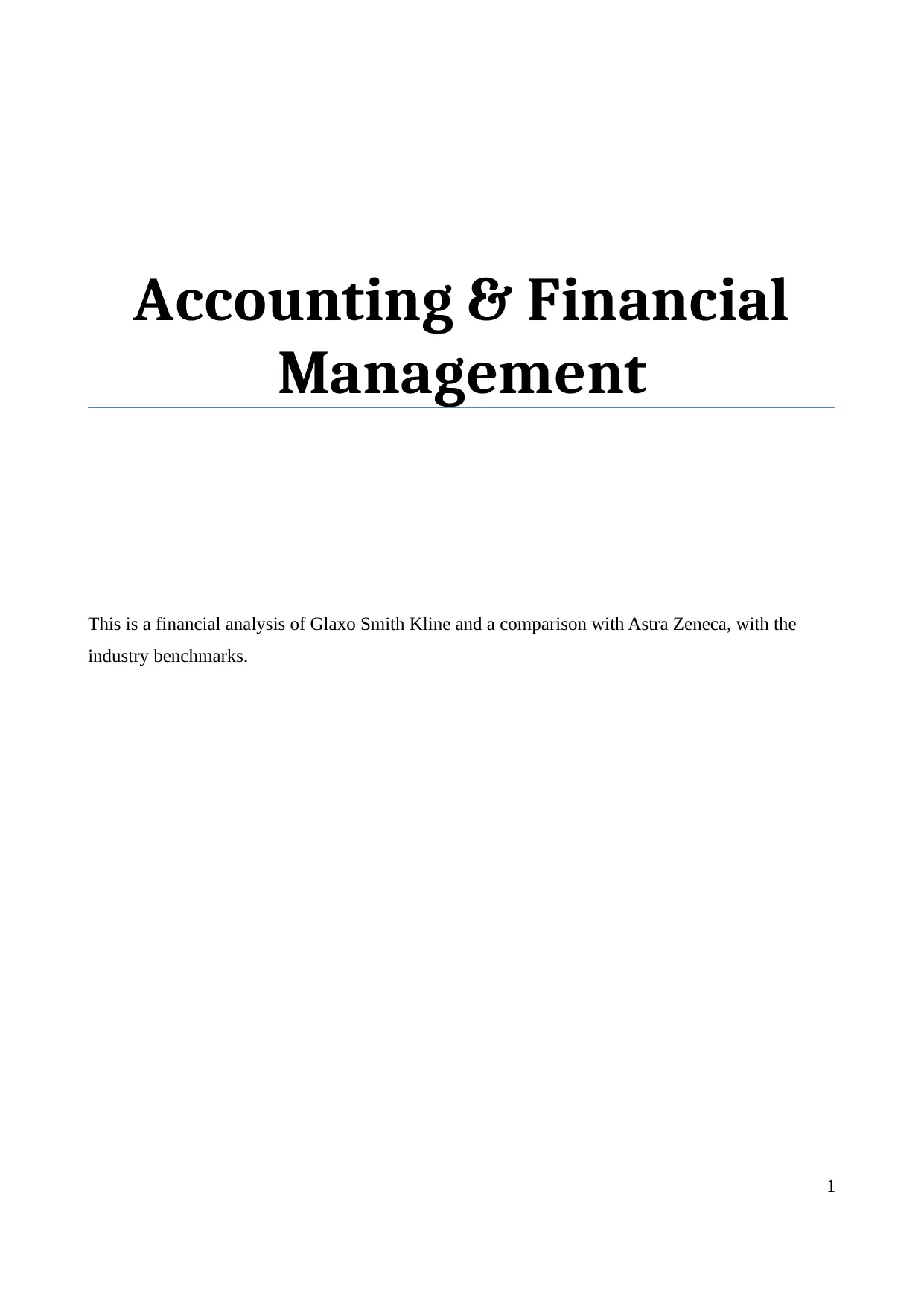
Accounting & Financial
Management
This is a financial analysis of Glaxo Smith Kline and a comparison with Astra Zeneca, with the
industry benchmarks.
1
Management
This is a financial analysis of Glaxo Smith Kline and a comparison with Astra Zeneca, with the
industry benchmarks.
1
Secure Best Marks with AI Grader
Need help grading? Try our AI Grader for instant feedback on your assignments.
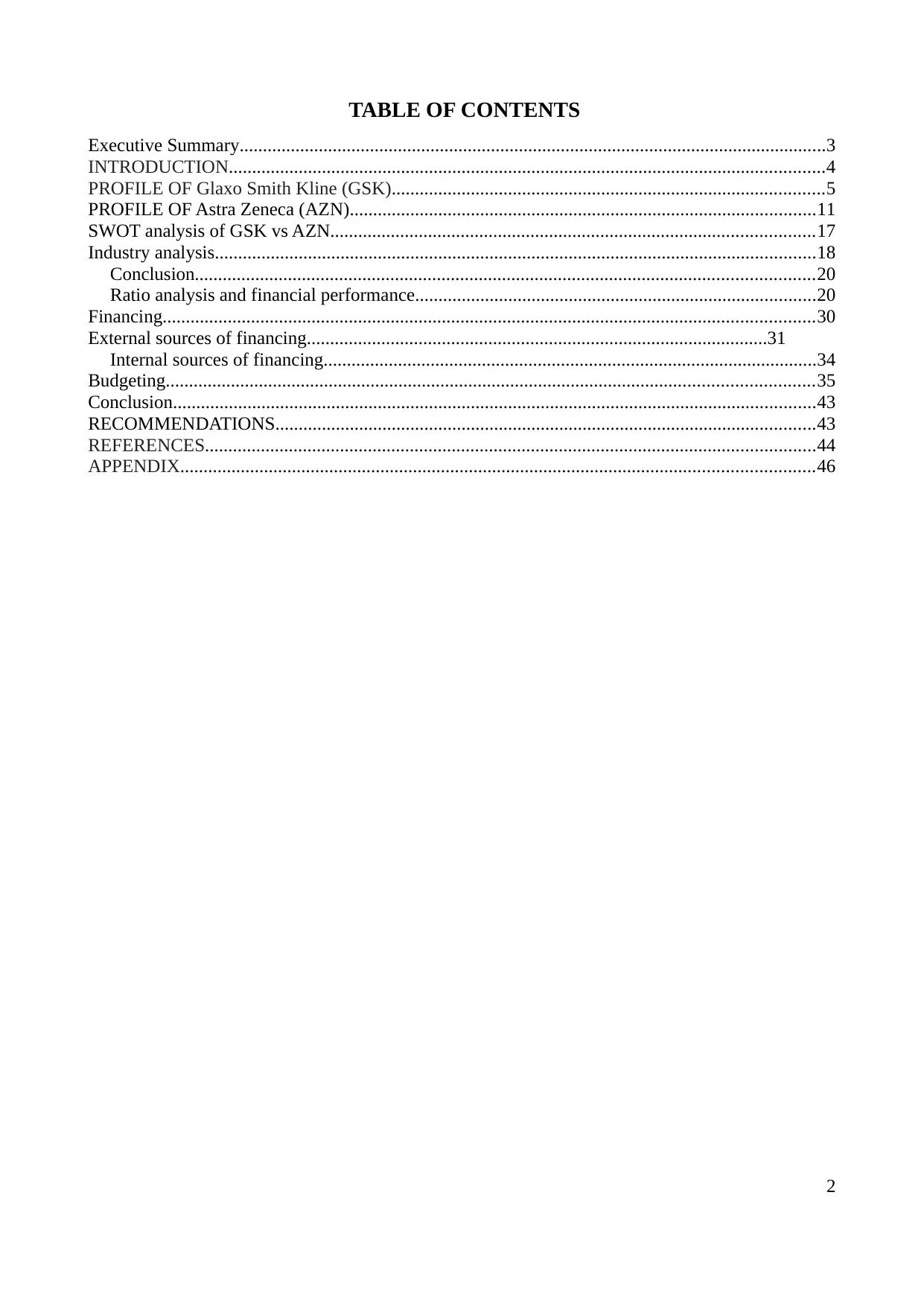
TABLE OF CONTENTS
Executive Summary..............................................................................................................................3
INTRODUCTION................................................................................................................................4
PROFILE OF Glaxo Smith Kline (GSK).............................................................................................5
PROFILE OF Astra Zeneca (AZN)....................................................................................................11
SWOT analysis of GSK vs AZN........................................................................................................17
Industry analysis.................................................................................................................................18
Conclusion.....................................................................................................................................20
Ratio analysis and financial performance......................................................................................20
Financing............................................................................................................................................30
External sources of financing...................................................................................................31
Internal sources of financing..........................................................................................................34
Budgeting...........................................................................................................................................35
Conclusion..........................................................................................................................................43
RECOMMENDATIONS....................................................................................................................43
REFERENCES...................................................................................................................................44
APPENDIX........................................................................................................................................46
2
Executive Summary..............................................................................................................................3
INTRODUCTION................................................................................................................................4
PROFILE OF Glaxo Smith Kline (GSK).............................................................................................5
PROFILE OF Astra Zeneca (AZN)....................................................................................................11
SWOT analysis of GSK vs AZN........................................................................................................17
Industry analysis.................................................................................................................................18
Conclusion.....................................................................................................................................20
Ratio analysis and financial performance......................................................................................20
Financing............................................................................................................................................30
External sources of financing...................................................................................................31
Internal sources of financing..........................................................................................................34
Budgeting...........................................................................................................................................35
Conclusion..........................................................................................................................................43
RECOMMENDATIONS....................................................................................................................43
REFERENCES...................................................................................................................................44
APPENDIX........................................................................................................................................46
2
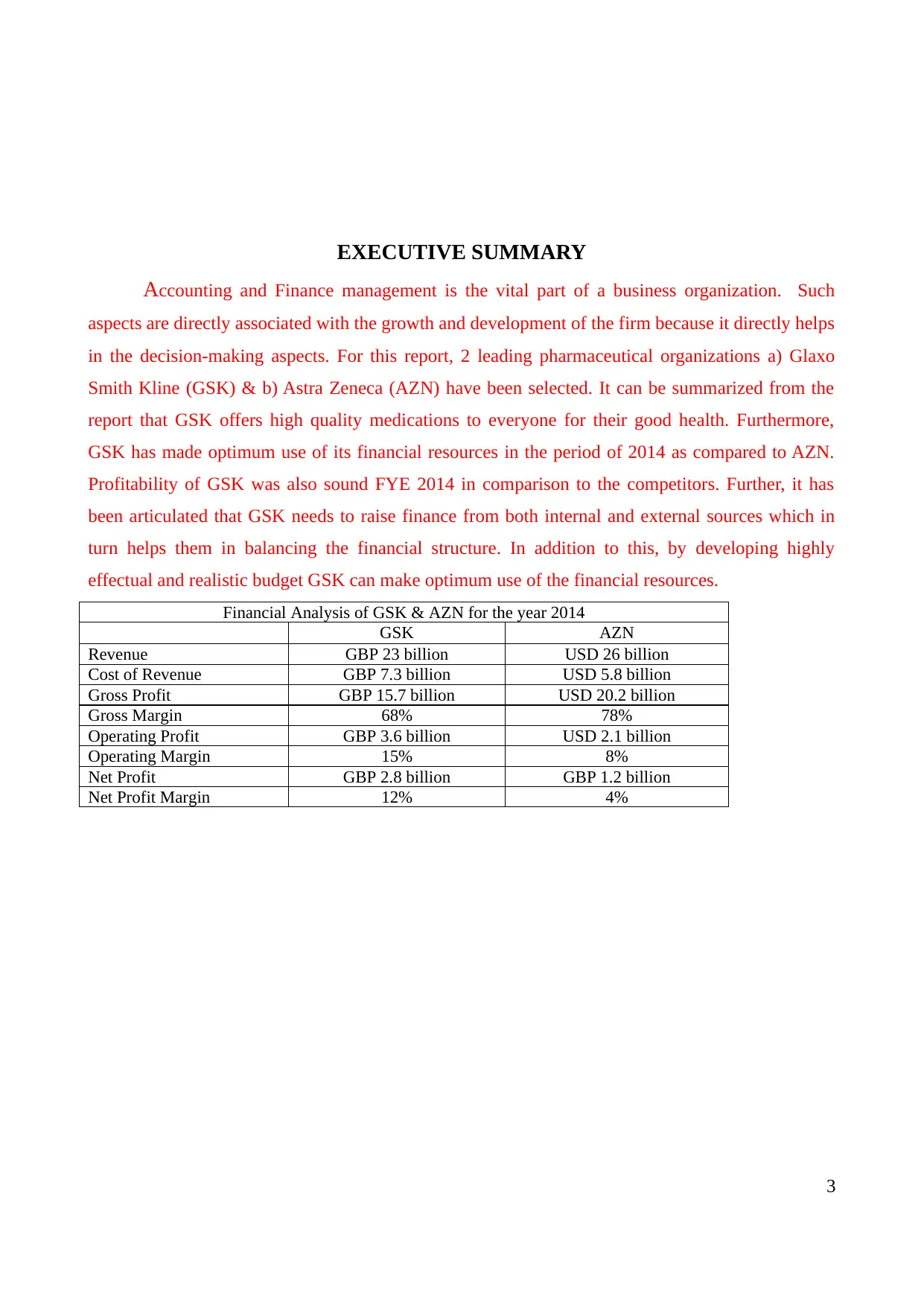
EXECUTIVE SUMMARY
Accounting and Finance management is the vital part of a business organization. Such
aspects are directly associated with the growth and development of the firm because it directly helps
in the decision-making aspects. For this report, 2 leading pharmaceutical organizations a) Glaxo
Smith Kline (GSK) & b) Astra Zeneca (AZN) have been selected. It can be summarized from the
report that GSK offers high quality medications to everyone for their good health. Furthermore,
GSK has made optimum use of its financial resources in the period of 2014 as compared to AZN.
Profitability of GSK was also sound FYE 2014 in comparison to the competitors. Further, it has
been articulated that GSK needs to raise finance from both internal and external sources which in
turn helps them in balancing the financial structure. In addition to this, by developing highly
effectual and realistic budget GSK can make optimum use of the financial resources.
Financial Analysis of GSK & AZN for the year 2014
GSK AZN
Revenue GBP 23 billion USD 26 billion
Cost of Revenue GBP 7.3 billion USD 5.8 billion
Gross Profit GBP 15.7 billion USD 20.2 billion
Gross Margin 68% 78%
Operating Profit GBP 3.6 billion USD 2.1 billion
Operating Margin 15% 8%
Net Profit GBP 2.8 billion GBP 1.2 billion
Net Profit Margin 12% 4%
3
Accounting and Finance management is the vital part of a business organization. Such
aspects are directly associated with the growth and development of the firm because it directly helps
in the decision-making aspects. For this report, 2 leading pharmaceutical organizations a) Glaxo
Smith Kline (GSK) & b) Astra Zeneca (AZN) have been selected. It can be summarized from the
report that GSK offers high quality medications to everyone for their good health. Furthermore,
GSK has made optimum use of its financial resources in the period of 2014 as compared to AZN.
Profitability of GSK was also sound FYE 2014 in comparison to the competitors. Further, it has
been articulated that GSK needs to raise finance from both internal and external sources which in
turn helps them in balancing the financial structure. In addition to this, by developing highly
effectual and realistic budget GSK can make optimum use of the financial resources.
Financial Analysis of GSK & AZN for the year 2014
GSK AZN
Revenue GBP 23 billion USD 26 billion
Cost of Revenue GBP 7.3 billion USD 5.8 billion
Gross Profit GBP 15.7 billion USD 20.2 billion
Gross Margin 68% 78%
Operating Profit GBP 3.6 billion USD 2.1 billion
Operating Margin 15% 8%
Net Profit GBP 2.8 billion GBP 1.2 billion
Net Profit Margin 12% 4%
3
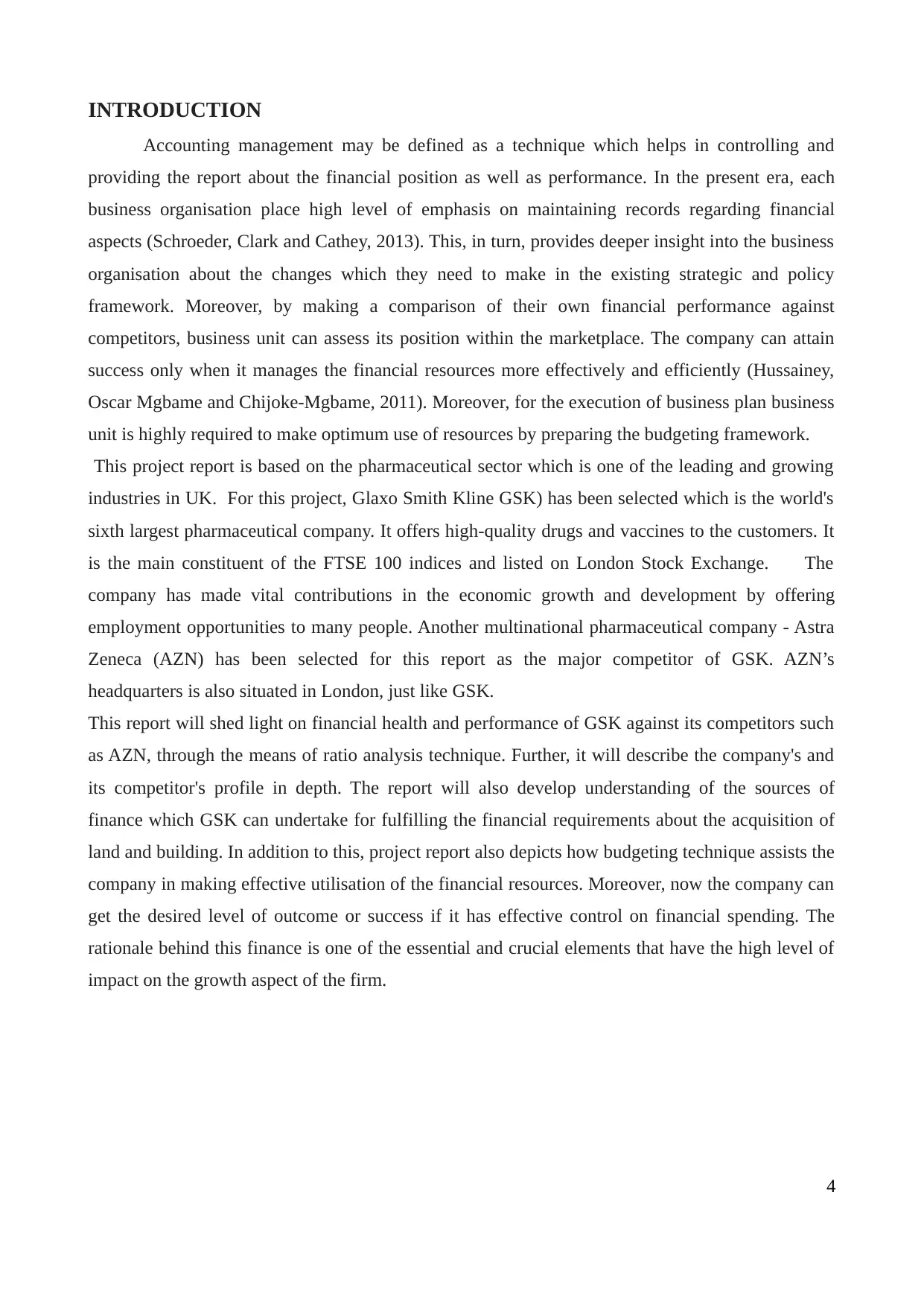
INTRODUCTION
Accounting management may be defined as a technique which helps in controlling and
providing the report about the financial position as well as performance. In the present era, each
business organisation place high level of emphasis on maintaining records regarding financial
aspects (Schroeder, Clark and Cathey, 2013). This, in turn, provides deeper insight into the business
organisation about the changes which they need to make in the existing strategic and policy
framework. Moreover, by making a comparison of their own financial performance against
competitors, business unit can assess its position within the marketplace. The company can attain
success only when it manages the financial resources more effectively and efficiently (Hussainey,
Oscar Mgbame and Chijoke-Mgbame, 2011). Moreover, for the execution of business plan business
unit is highly required to make optimum use of resources by preparing the budgeting framework.
This project report is based on the pharmaceutical sector which is one of the leading and growing
industries in UK. For this project, Glaxo Smith Kline GSK) has been selected which is the world's
sixth largest pharmaceutical company. It offers high-quality drugs and vaccines to the customers. It
is the main constituent of the FTSE 100 indices and listed on London Stock Exchange. The
company has made vital contributions in the economic growth and development by offering
employment opportunities to many people. Another multinational pharmaceutical company - Astra
Zeneca (AZN) has been selected for this report as the major competitor of GSK. AZN’s
headquarters is also situated in London, just like GSK.
This report will shed light on financial health and performance of GSK against its competitors such
as AZN, through the means of ratio analysis technique. Further, it will describe the company's and
its competitor's profile in depth. The report will also develop understanding of the sources of
finance which GSK can undertake for fulfilling the financial requirements about the acquisition of
land and building. In addition to this, project report also depicts how budgeting technique assists the
company in making effective utilisation of the financial resources. Moreover, now the company can
get the desired level of outcome or success if it has effective control on financial spending. The
rationale behind this finance is one of the essential and crucial elements that have the high level of
impact on the growth aspect of the firm.
4
Accounting management may be defined as a technique which helps in controlling and
providing the report about the financial position as well as performance. In the present era, each
business organisation place high level of emphasis on maintaining records regarding financial
aspects (Schroeder, Clark and Cathey, 2013). This, in turn, provides deeper insight into the business
organisation about the changes which they need to make in the existing strategic and policy
framework. Moreover, by making a comparison of their own financial performance against
competitors, business unit can assess its position within the marketplace. The company can attain
success only when it manages the financial resources more effectively and efficiently (Hussainey,
Oscar Mgbame and Chijoke-Mgbame, 2011). Moreover, for the execution of business plan business
unit is highly required to make optimum use of resources by preparing the budgeting framework.
This project report is based on the pharmaceutical sector which is one of the leading and growing
industries in UK. For this project, Glaxo Smith Kline GSK) has been selected which is the world's
sixth largest pharmaceutical company. It offers high-quality drugs and vaccines to the customers. It
is the main constituent of the FTSE 100 indices and listed on London Stock Exchange. The
company has made vital contributions in the economic growth and development by offering
employment opportunities to many people. Another multinational pharmaceutical company - Astra
Zeneca (AZN) has been selected for this report as the major competitor of GSK. AZN’s
headquarters is also situated in London, just like GSK.
This report will shed light on financial health and performance of GSK against its competitors such
as AZN, through the means of ratio analysis technique. Further, it will describe the company's and
its competitor's profile in depth. The report will also develop understanding of the sources of
finance which GSK can undertake for fulfilling the financial requirements about the acquisition of
land and building. In addition to this, project report also depicts how budgeting technique assists the
company in making effective utilisation of the financial resources. Moreover, now the company can
get the desired level of outcome or success if it has effective control on financial spending. The
rationale behind this finance is one of the essential and crucial elements that have the high level of
impact on the growth aspect of the firm.
4
Secure Best Marks with AI Grader
Need help grading? Try our AI Grader for instant feedback on your assignments.
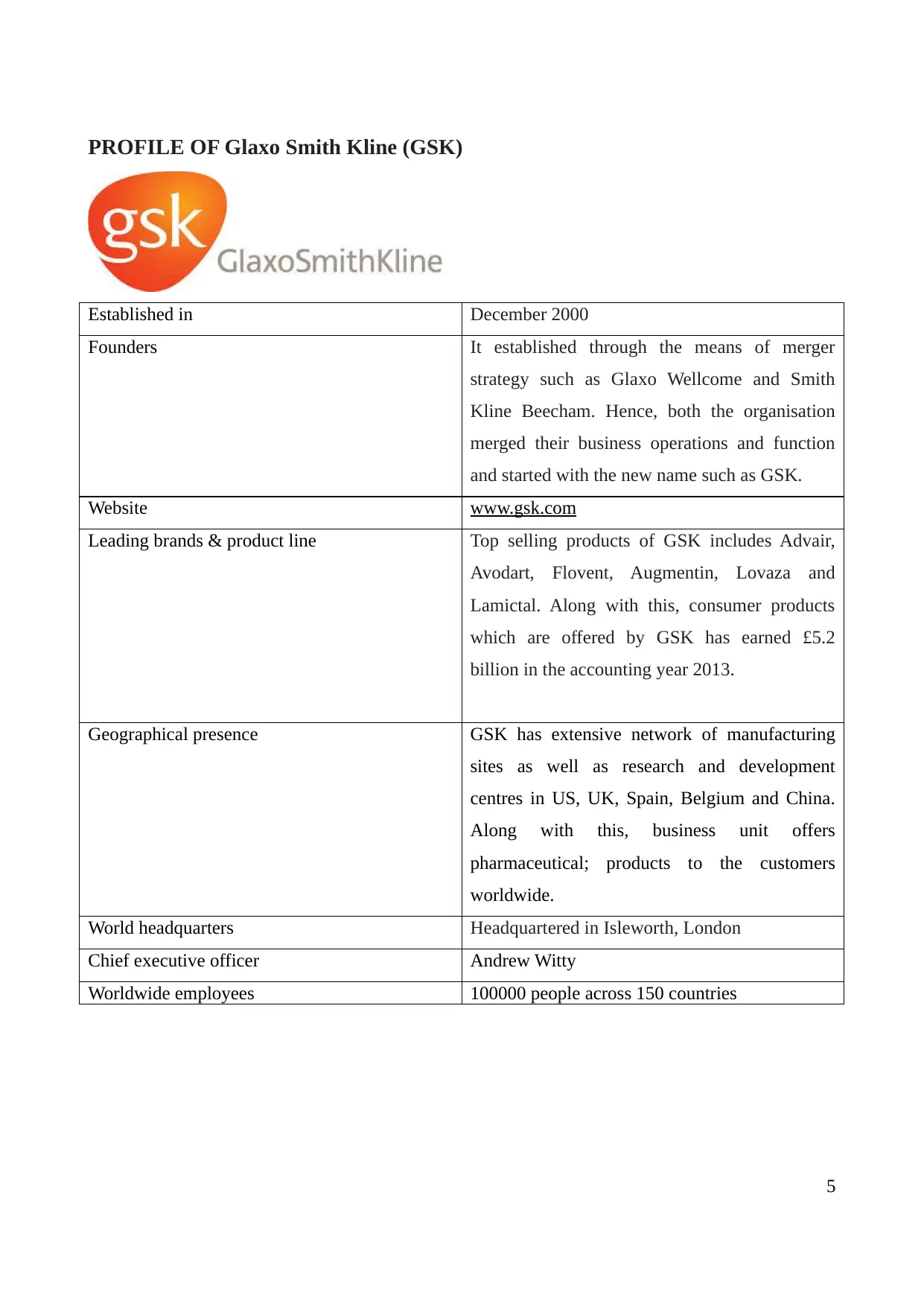
PROFILE OF Glaxo Smith Kline (GSK)
Established in December 2000
Founders It established through the means of merger
strategy such as Glaxo Wellcome and Smith
Kline Beecham. Hence, both the organisation
merged their business operations and function
and started with the new name such as GSK.
Website www.gsk.com
Leading brands & product line Top selling products of GSK includes Advair,
Avodart, Flovent, Augmentin, Lovaza and
Lamictal. Along with this, consumer products
which are offered by GSK has earned £5.2
billion in the accounting year 2013.
Geographical presence GSK has extensive network of manufacturing
sites as well as research and development
centres in US, UK, Spain, Belgium and China.
Along with this, business unit offers
pharmaceutical; products to the customers
worldwide.
World headquarters Headquartered in Isleworth, London
Chief executive officer Andrew Witty
Worldwide employees 100000 people across 150 countries
5
Established in December 2000
Founders It established through the means of merger
strategy such as Glaxo Wellcome and Smith
Kline Beecham. Hence, both the organisation
merged their business operations and function
and started with the new name such as GSK.
Website www.gsk.com
Leading brands & product line Top selling products of GSK includes Advair,
Avodart, Flovent, Augmentin, Lovaza and
Lamictal. Along with this, consumer products
which are offered by GSK has earned £5.2
billion in the accounting year 2013.
Geographical presence GSK has extensive network of manufacturing
sites as well as research and development
centres in US, UK, Spain, Belgium and China.
Along with this, business unit offers
pharmaceutical; products to the customers
worldwide.
World headquarters Headquartered in Isleworth, London
Chief executive officer Andrew Witty
Worldwide employees 100000 people across 150 countries
5
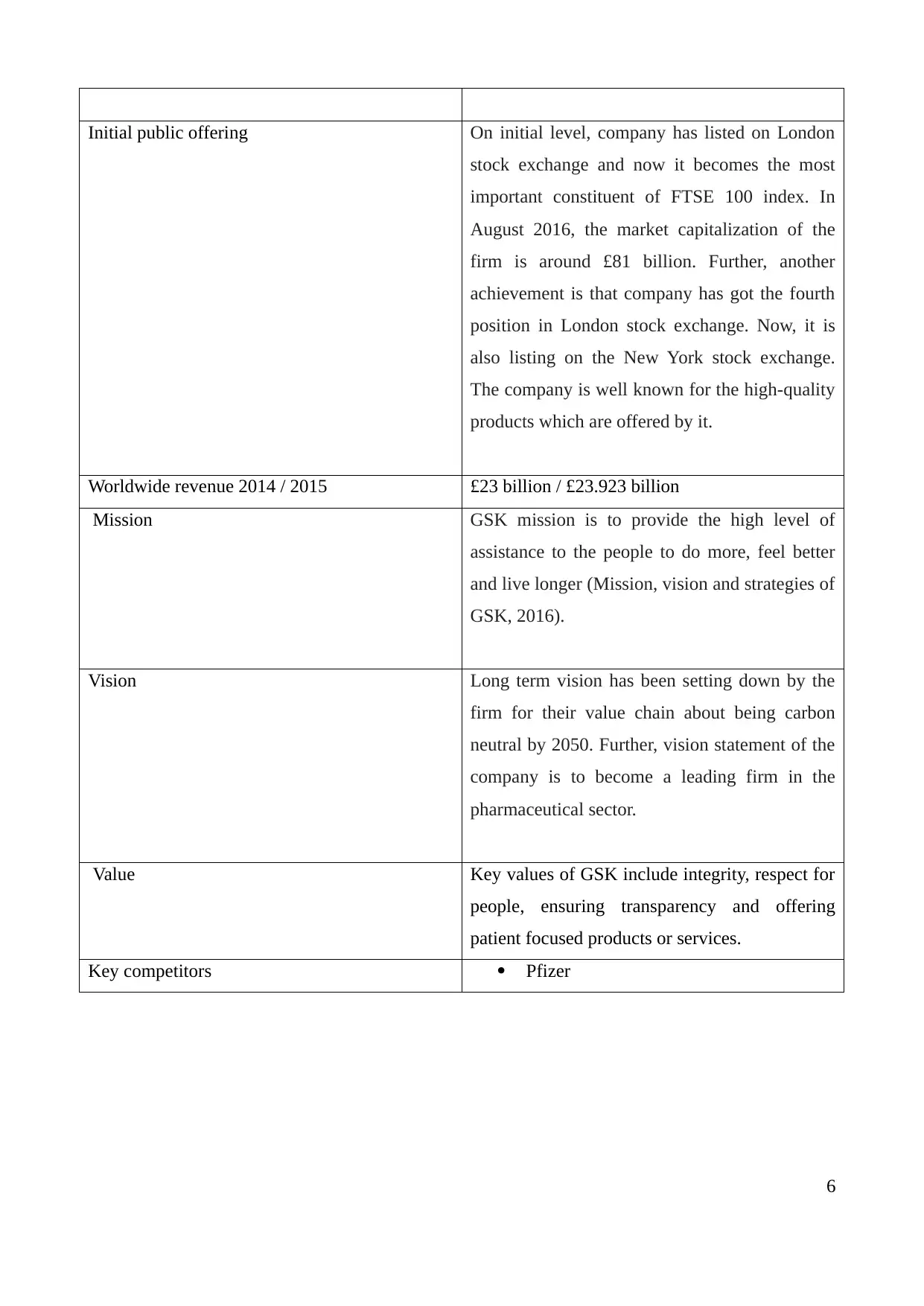
Initial public offering On initial level, company has listed on London
stock exchange and now it becomes the most
important constituent of FTSE 100 index. In
August 2016, the market capitalization of the
firm is around £81 billion. Further, another
achievement is that company has got the fourth
position in London stock exchange. Now, it is
also listing on the New York stock exchange.
The company is well known for the high-quality
products which are offered by it.
Worldwide revenue 2014 / 2015 £23 billion / £23.923 billion
Mission GSK mission is to provide the high level of
assistance to the people to do more, feel better
and live longer (Mission, vision and strategies of
GSK, 2016).
Vision Long term vision has been setting down by the
firm for their value chain about being carbon
neutral by 2050. Further, vision statement of the
company is to become a leading firm in the
pharmaceutical sector.
Value Key values of GSK include integrity, respect for
people, ensuring transparency and offering
patient focused products or services.
Key competitors Pfizer
6
stock exchange and now it becomes the most
important constituent of FTSE 100 index. In
August 2016, the market capitalization of the
firm is around £81 billion. Further, another
achievement is that company has got the fourth
position in London stock exchange. Now, it is
also listing on the New York stock exchange.
The company is well known for the high-quality
products which are offered by it.
Worldwide revenue 2014 / 2015 £23 billion / £23.923 billion
Mission GSK mission is to provide the high level of
assistance to the people to do more, feel better
and live longer (Mission, vision and strategies of
GSK, 2016).
Vision Long term vision has been setting down by the
firm for their value chain about being carbon
neutral by 2050. Further, vision statement of the
company is to become a leading firm in the
pharmaceutical sector.
Value Key values of GSK include integrity, respect for
people, ensuring transparency and offering
patient focused products or services.
Key competitors Pfizer
6
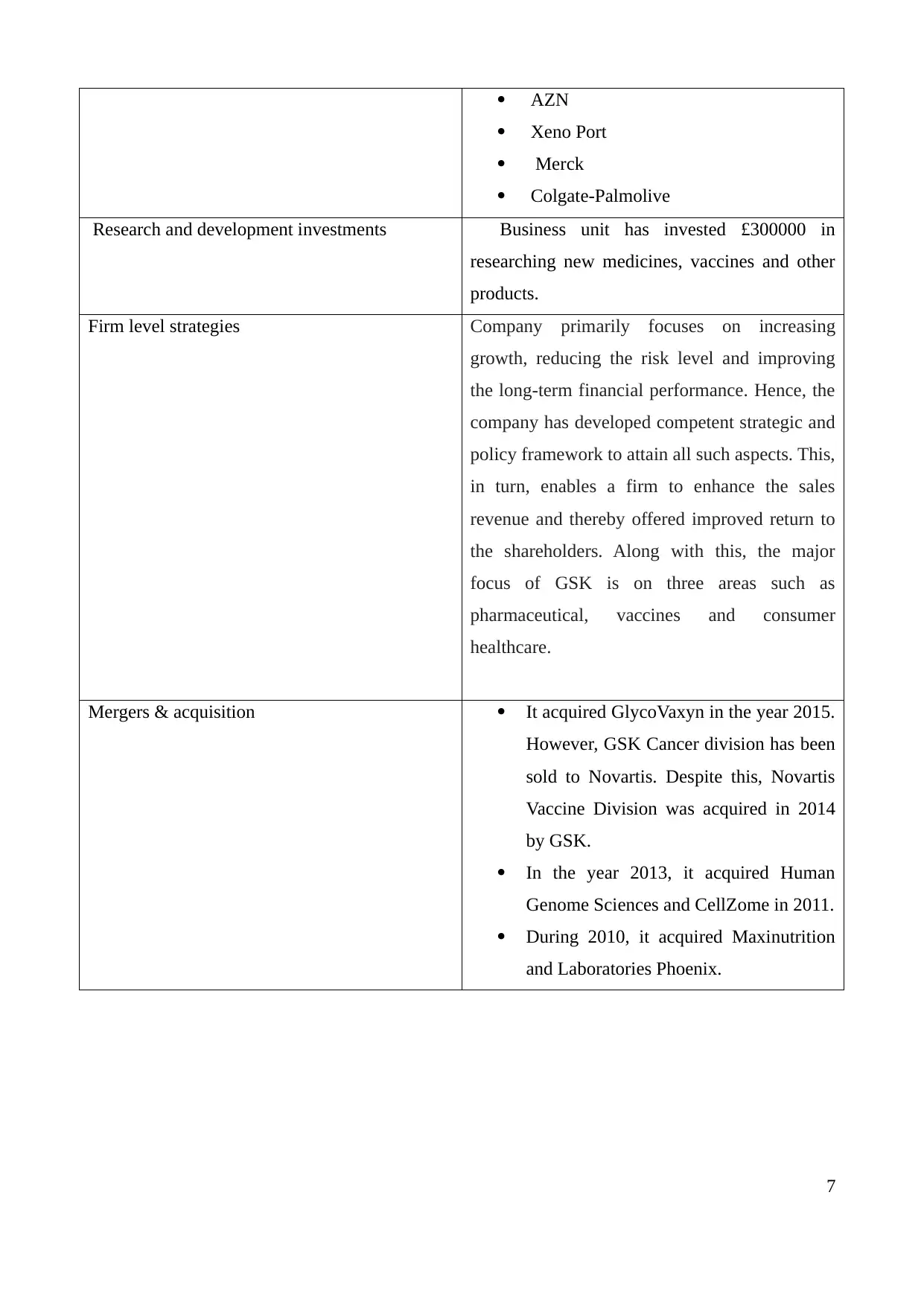
AZN
Xeno Port
Merck
Colgate-Palmolive
Research and development investments Business unit has invested £300000 in
researching new medicines, vaccines and other
products.
Firm level strategies Company primarily focuses on increasing
growth, reducing the risk level and improving
the long-term financial performance. Hence, the
company has developed competent strategic and
policy framework to attain all such aspects. This,
in turn, enables a firm to enhance the sales
revenue and thereby offered improved return to
the shareholders. Along with this, the major
focus of GSK is on three areas such as
pharmaceutical, vaccines and consumer
healthcare.
Mergers & acquisition It acquired GlycoVaxyn in the year 2015.
However, GSK Cancer division has been
sold to Novartis. Despite this, Novartis
Vaccine Division was acquired in 2014
by GSK.
In the year 2013, it acquired Human
Genome Sciences and CellZome in 2011.
During 2010, it acquired Maxinutrition
and Laboratories Phoenix.
7
Xeno Port
Merck
Colgate-Palmolive
Research and development investments Business unit has invested £300000 in
researching new medicines, vaccines and other
products.
Firm level strategies Company primarily focuses on increasing
growth, reducing the risk level and improving
the long-term financial performance. Hence, the
company has developed competent strategic and
policy framework to attain all such aspects. This,
in turn, enables a firm to enhance the sales
revenue and thereby offered improved return to
the shareholders. Along with this, the major
focus of GSK is on three areas such as
pharmaceutical, vaccines and consumer
healthcare.
Mergers & acquisition It acquired GlycoVaxyn in the year 2015.
However, GSK Cancer division has been
sold to Novartis. Despite this, Novartis
Vaccine Division was acquired in 2014
by GSK.
In the year 2013, it acquired Human
Genome Sciences and CellZome in 2011.
During 2010, it acquired Maxinutrition
and Laboratories Phoenix.
7
Paraphrase This Document
Need a fresh take? Get an instant paraphrase of this document with our AI Paraphraser
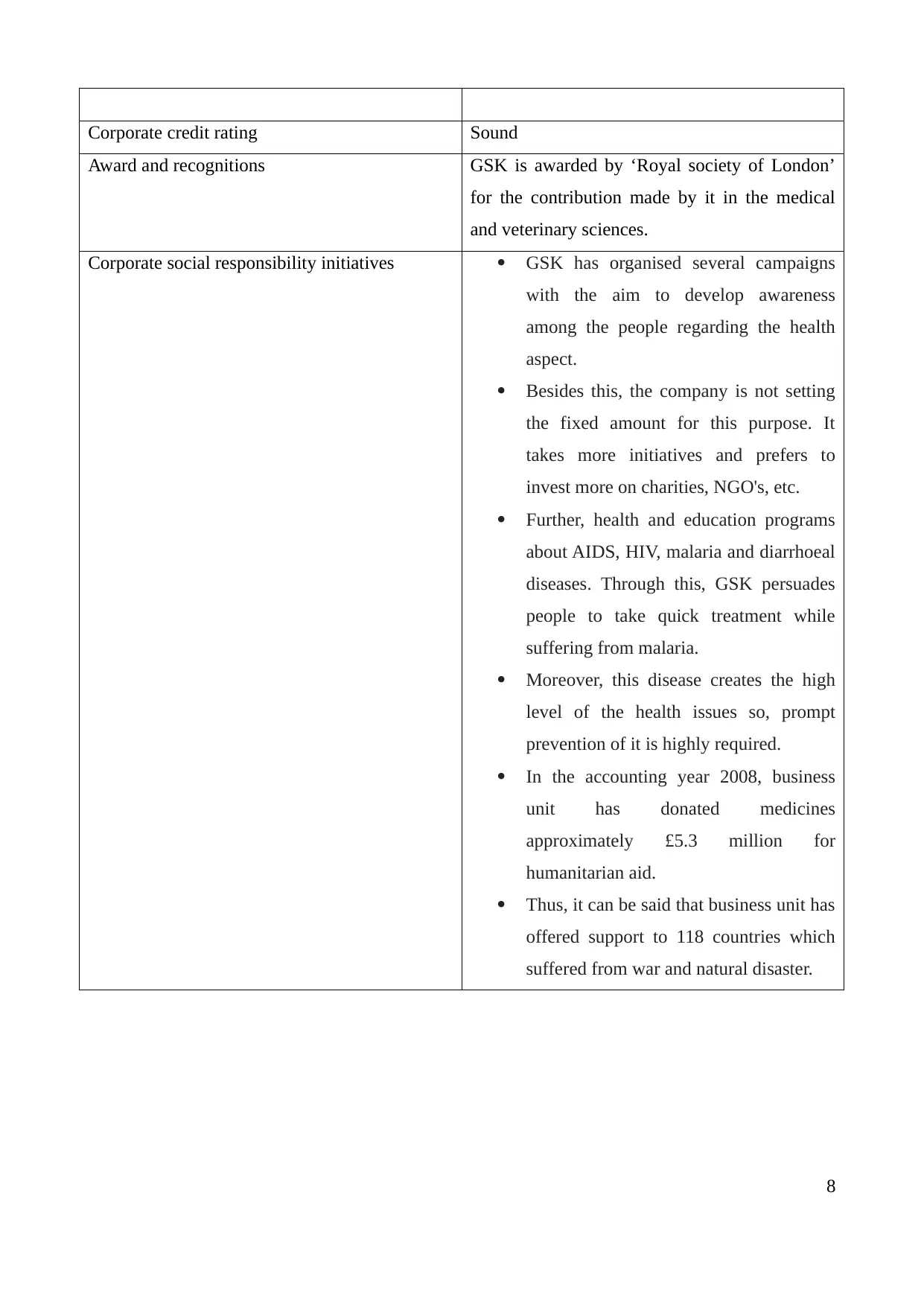
Corporate credit rating Sound
Award and recognitions GSK is awarded by ‘Royal society of London’
for the contribution made by it in the medical
and veterinary sciences.
Corporate social responsibility initiatives GSK has organised several campaigns
with the aim to develop awareness
among the people regarding the health
aspect.
Besides this, the company is not setting
the fixed amount for this purpose. It
takes more initiatives and prefers to
invest more on charities, NGO's, etc.
Further, health and education programs
about AIDS, HIV, malaria and diarrhoeal
diseases. Through this, GSK persuades
people to take quick treatment while
suffering from malaria.
Moreover, this disease creates the high
level of the health issues so, prompt
prevention of it is highly required.
In the accounting year 2008, business
unit has donated medicines
approximately £5.3 million for
humanitarian aid.
Thus, it can be said that business unit has
offered support to 118 countries which
suffered from war and natural disaster.
8
Award and recognitions GSK is awarded by ‘Royal society of London’
for the contribution made by it in the medical
and veterinary sciences.
Corporate social responsibility initiatives GSK has organised several campaigns
with the aim to develop awareness
among the people regarding the health
aspect.
Besides this, the company is not setting
the fixed amount for this purpose. It
takes more initiatives and prefers to
invest more on charities, NGO's, etc.
Further, health and education programs
about AIDS, HIV, malaria and diarrhoeal
diseases. Through this, GSK persuades
people to take quick treatment while
suffering from malaria.
Moreover, this disease creates the high
level of the health issues so, prompt
prevention of it is highly required.
In the accounting year 2008, business
unit has donated medicines
approximately £5.3 million for
humanitarian aid.
Thus, it can be said that business unit has
offered support to 118 countries which
suffered from war and natural disaster.
8
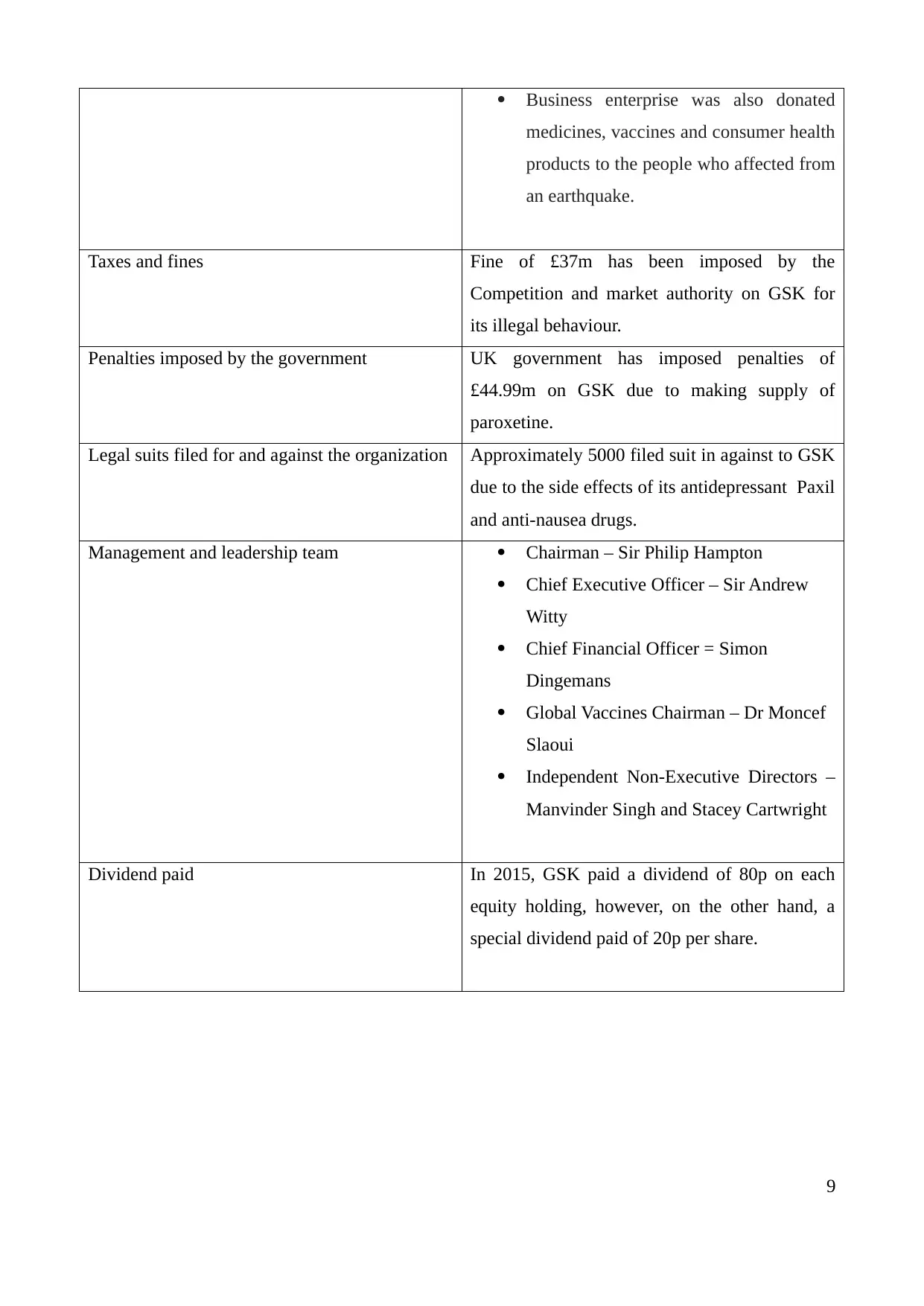
Business enterprise was also donated
medicines, vaccines and consumer health
products to the people who affected from
an earthquake.
Taxes and fines Fine of £37m has been imposed by the
Competition and market authority on GSK for
its illegal behaviour.
Penalties imposed by the government UK government has imposed penalties of
£44.99m on GSK due to making supply of
paroxetine.
Legal suits filed for and against the organization Approximately 5000 filed suit in against to GSK
due to the side effects of its antidepressant Paxil
and anti-nausea drugs.
Management and leadership team Chairman – Sir Philip Hampton
Chief Executive Officer – Sir Andrew
Witty
Chief Financial Officer = Simon
Dingemans
Global Vaccines Chairman – Dr Moncef
Slaoui
Independent Non-Executive Directors –
Manvinder Singh and Stacey Cartwright
Dividend paid In 2015, GSK paid a dividend of 80p on each
equity holding, however, on the other hand, a
special dividend paid of 20p per share.
9
medicines, vaccines and consumer health
products to the people who affected from
an earthquake.
Taxes and fines Fine of £37m has been imposed by the
Competition and market authority on GSK for
its illegal behaviour.
Penalties imposed by the government UK government has imposed penalties of
£44.99m on GSK due to making supply of
paroxetine.
Legal suits filed for and against the organization Approximately 5000 filed suit in against to GSK
due to the side effects of its antidepressant Paxil
and anti-nausea drugs.
Management and leadership team Chairman – Sir Philip Hampton
Chief Executive Officer – Sir Andrew
Witty
Chief Financial Officer = Simon
Dingemans
Global Vaccines Chairman – Dr Moncef
Slaoui
Independent Non-Executive Directors –
Manvinder Singh and Stacey Cartwright
Dividend paid In 2015, GSK paid a dividend of 80p on each
equity holding, however, on the other hand, a
special dividend paid of 20p per share.
9
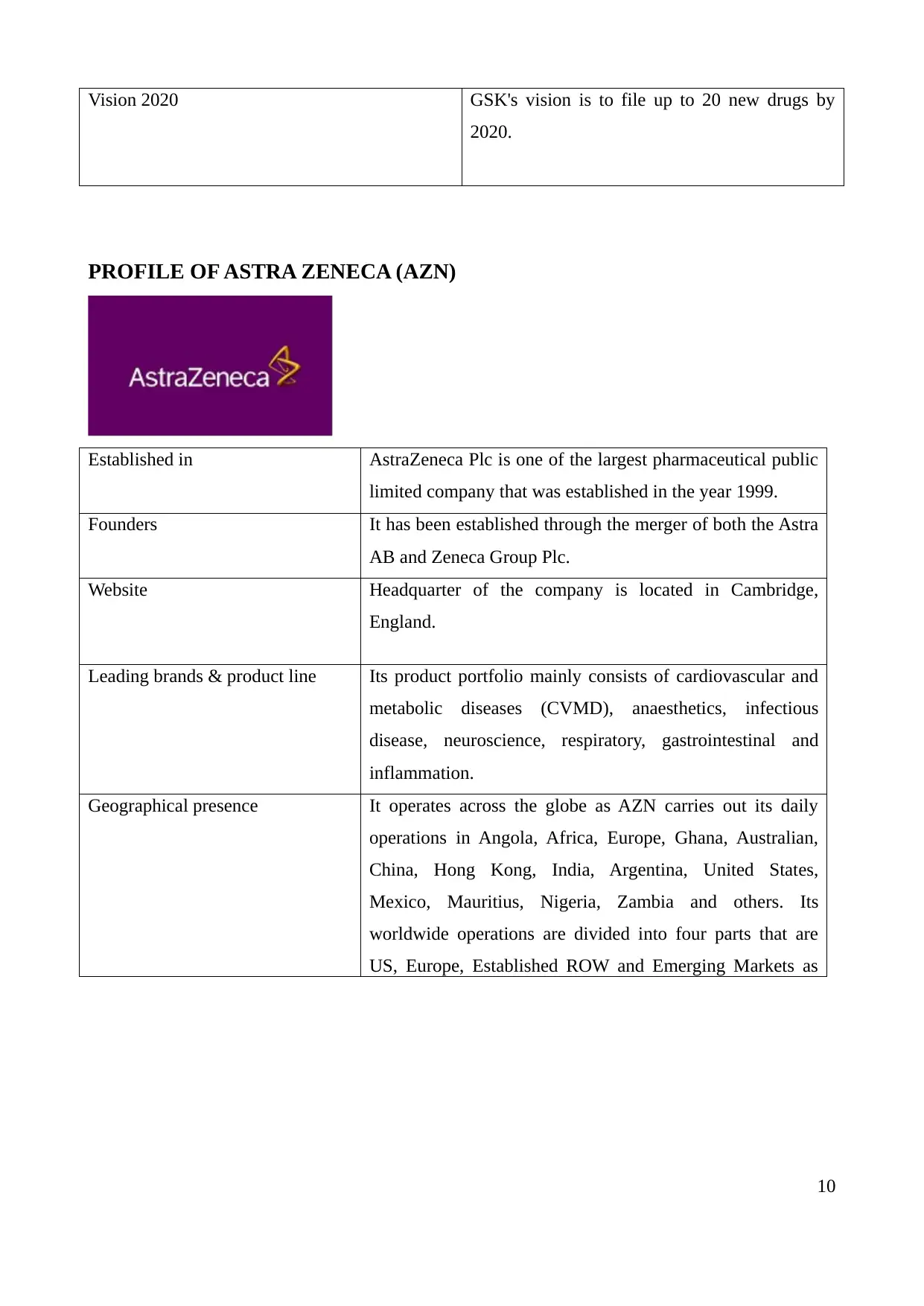
Vision 2020 GSK's vision is to file up to 20 new drugs by
2020.
PROFILE OF ASTRA ZENECA (AZN)
Established in AstraZeneca Plc is one of the largest pharmaceutical public
limited company that was established in the year 1999.
Founders It has been established through the merger of both the Astra
AB and Zeneca Group Plc.
Website Headquarter of the company is located in Cambridge,
England.
Leading brands & product line Its product portfolio mainly consists of cardiovascular and
metabolic diseases (CVMD), anaesthetics, infectious
disease, neuroscience, respiratory, gastrointestinal and
inflammation.
Geographical presence It operates across the globe as AZN carries out its daily
operations in Angola, Africa, Europe, Ghana, Australian,
China, Hong Kong, India, Argentina, United States,
Mexico, Mauritius, Nigeria, Zambia and others. Its
worldwide operations are divided into four parts that are
US, Europe, Established ROW and Emerging Markets as
10
2020.
PROFILE OF ASTRA ZENECA (AZN)
Established in AstraZeneca Plc is one of the largest pharmaceutical public
limited company that was established in the year 1999.
Founders It has been established through the merger of both the Astra
AB and Zeneca Group Plc.
Website Headquarter of the company is located in Cambridge,
England.
Leading brands & product line Its product portfolio mainly consists of cardiovascular and
metabolic diseases (CVMD), anaesthetics, infectious
disease, neuroscience, respiratory, gastrointestinal and
inflammation.
Geographical presence It operates across the globe as AZN carries out its daily
operations in Angola, Africa, Europe, Ghana, Australian,
China, Hong Kong, India, Argentina, United States,
Mexico, Mauritius, Nigeria, Zambia and others. Its
worldwide operations are divided into four parts that are
US, Europe, Established ROW and Emerging Markets as
10
Secure Best Marks with AI Grader
Need help grading? Try our AI Grader for instant feedback on your assignments.
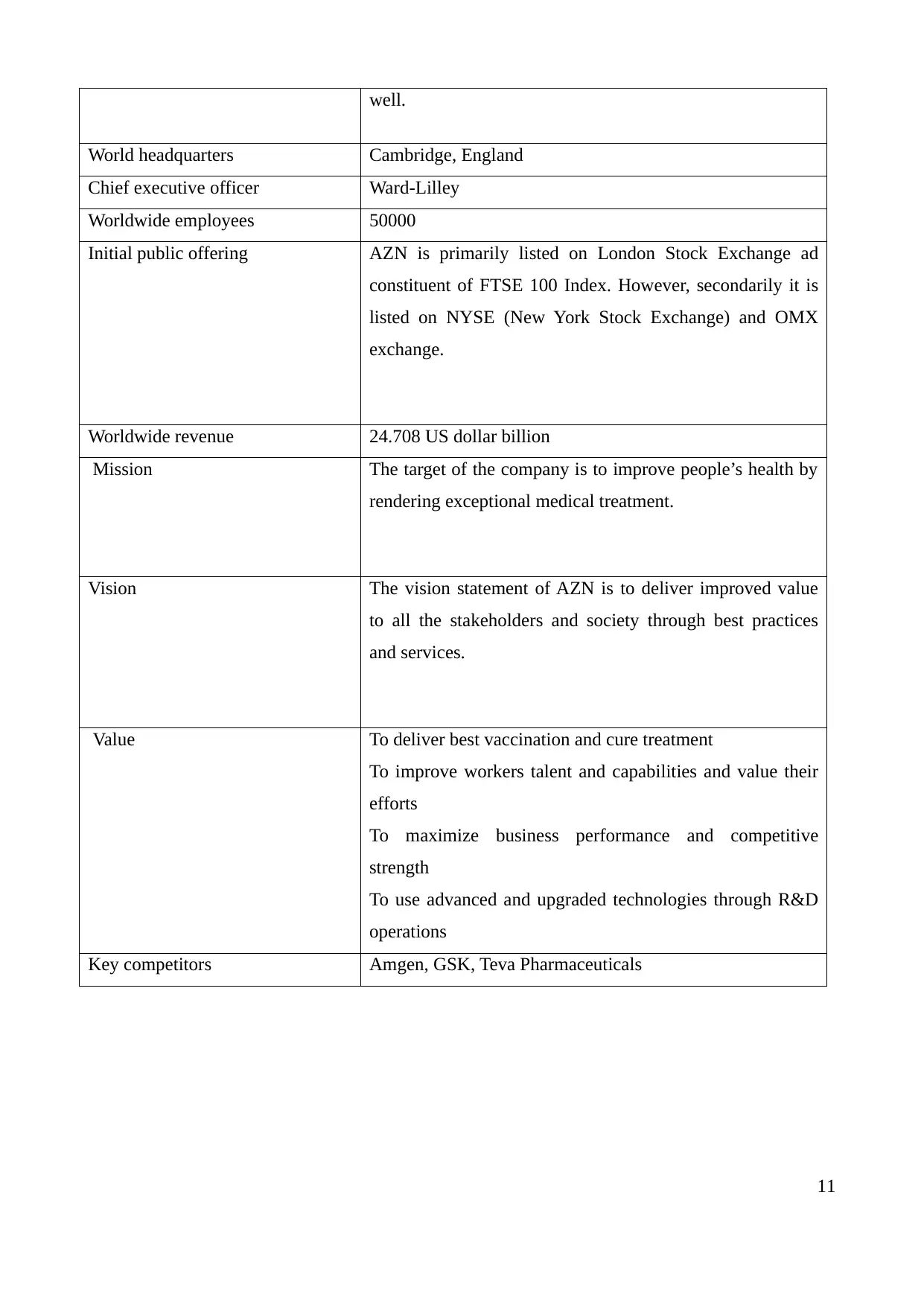
well.
World headquarters Cambridge, England
Chief executive officer Ward-Lilley
Worldwide employees 50000
Initial public offering AZN is primarily listed on London Stock Exchange ad
constituent of FTSE 100 Index. However, secondarily it is
listed on NYSE (New York Stock Exchange) and OMX
exchange.
Worldwide revenue 24.708 US dollar billion
Mission The target of the company is to improve people’s health by
rendering exceptional medical treatment.
Vision The vision statement of AZN is to deliver improved value
to all the stakeholders and society through best practices
and services.
Value To deliver best vaccination and cure treatment
To improve workers talent and capabilities and value their
efforts
To maximize business performance and competitive
strength
To use advanced and upgraded technologies through R&D
operations
Key competitors Amgen, GSK, Teva Pharmaceuticals
11
World headquarters Cambridge, England
Chief executive officer Ward-Lilley
Worldwide employees 50000
Initial public offering AZN is primarily listed on London Stock Exchange ad
constituent of FTSE 100 Index. However, secondarily it is
listed on NYSE (New York Stock Exchange) and OMX
exchange.
Worldwide revenue 24.708 US dollar billion
Mission The target of the company is to improve people’s health by
rendering exceptional medical treatment.
Vision The vision statement of AZN is to deliver improved value
to all the stakeholders and society through best practices
and services.
Value To deliver best vaccination and cure treatment
To improve workers talent and capabilities and value their
efforts
To maximize business performance and competitive
strength
To use advanced and upgraded technologies through R&D
operations
Key competitors Amgen, GSK, Teva Pharmaceuticals
11
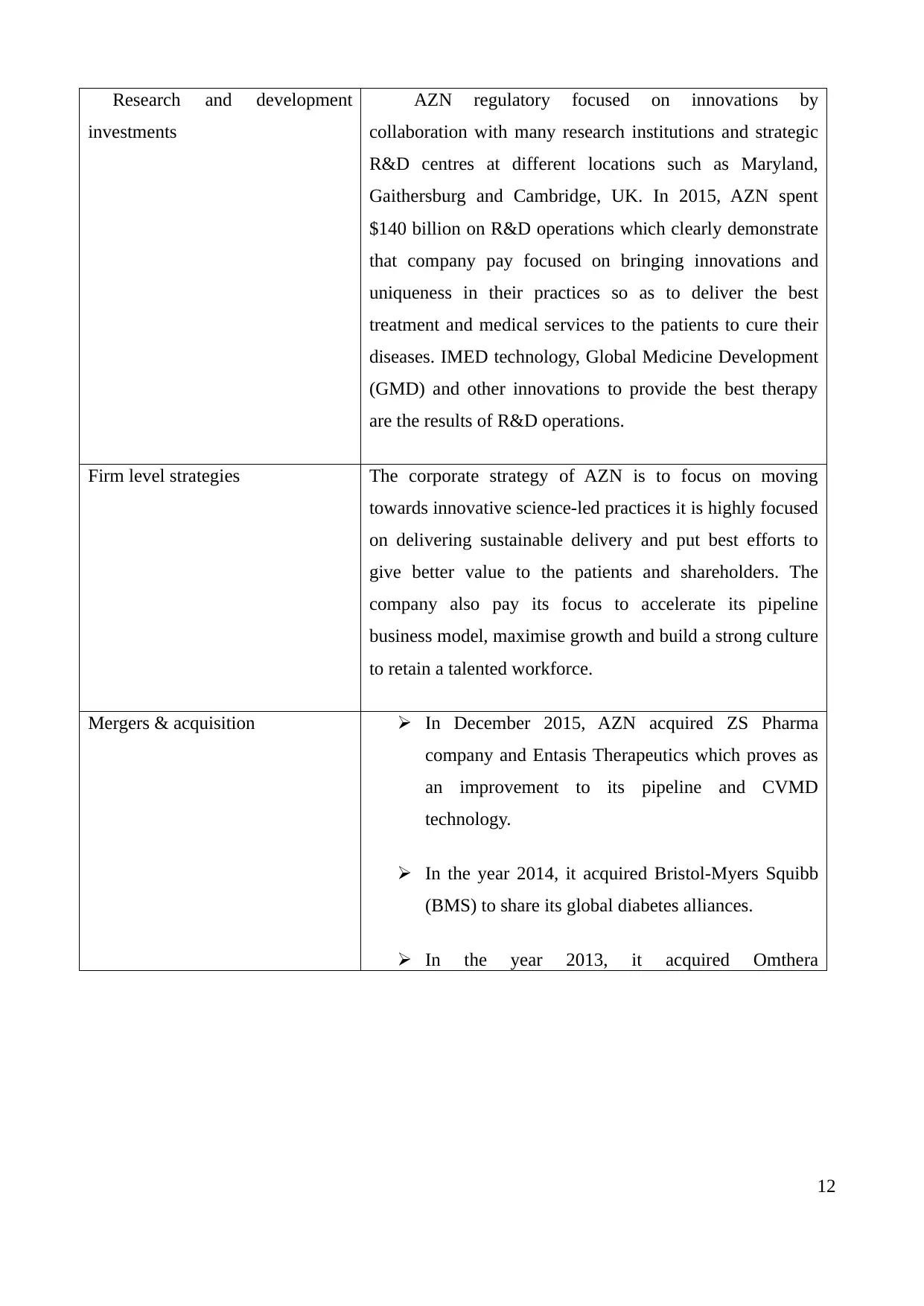
Research and development
investments
AZN regulatory focused on innovations by
collaboration with many research institutions and strategic
R&D centres at different locations such as Maryland,
Gaithersburg and Cambridge, UK. In 2015, AZN spent
$140 billion on R&D operations which clearly demonstrate
that company pay focused on bringing innovations and
uniqueness in their practices so as to deliver the best
treatment and medical services to the patients to cure their
diseases. IMED technology, Global Medicine Development
(GMD) and other innovations to provide the best therapy
are the results of R&D operations.
Firm level strategies The corporate strategy of AZN is to focus on moving
towards innovative science-led practices it is highly focused
on delivering sustainable delivery and put best efforts to
give better value to the patients and shareholders. The
company also pay its focus to accelerate its pipeline
business model, maximise growth and build a strong culture
to retain a talented workforce.
Mergers & acquisition n December 2015, AZN acquired ZS Pharma
company and Entasis Therapeutics which proves as
an improvement to its pipeline and CVMD
technology.
In the year 2014, it acquired Bristol-Myers Squibb
(BMS) to share its global diabetes alliances.
In the year 2013, it acquired Omthera
12
investments
AZN regulatory focused on innovations by
collaboration with many research institutions and strategic
R&D centres at different locations such as Maryland,
Gaithersburg and Cambridge, UK. In 2015, AZN spent
$140 billion on R&D operations which clearly demonstrate
that company pay focused on bringing innovations and
uniqueness in their practices so as to deliver the best
treatment and medical services to the patients to cure their
diseases. IMED technology, Global Medicine Development
(GMD) and other innovations to provide the best therapy
are the results of R&D operations.
Firm level strategies The corporate strategy of AZN is to focus on moving
towards innovative science-led practices it is highly focused
on delivering sustainable delivery and put best efforts to
give better value to the patients and shareholders. The
company also pay its focus to accelerate its pipeline
business model, maximise growth and build a strong culture
to retain a talented workforce.
Mergers & acquisition n December 2015, AZN acquired ZS Pharma
company and Entasis Therapeutics which proves as
an improvement to its pipeline and CVMD
technology.
In the year 2014, it acquired Bristol-Myers Squibb
(BMS) to share its global diabetes alliances.
In the year 2013, it acquired Omthera
12
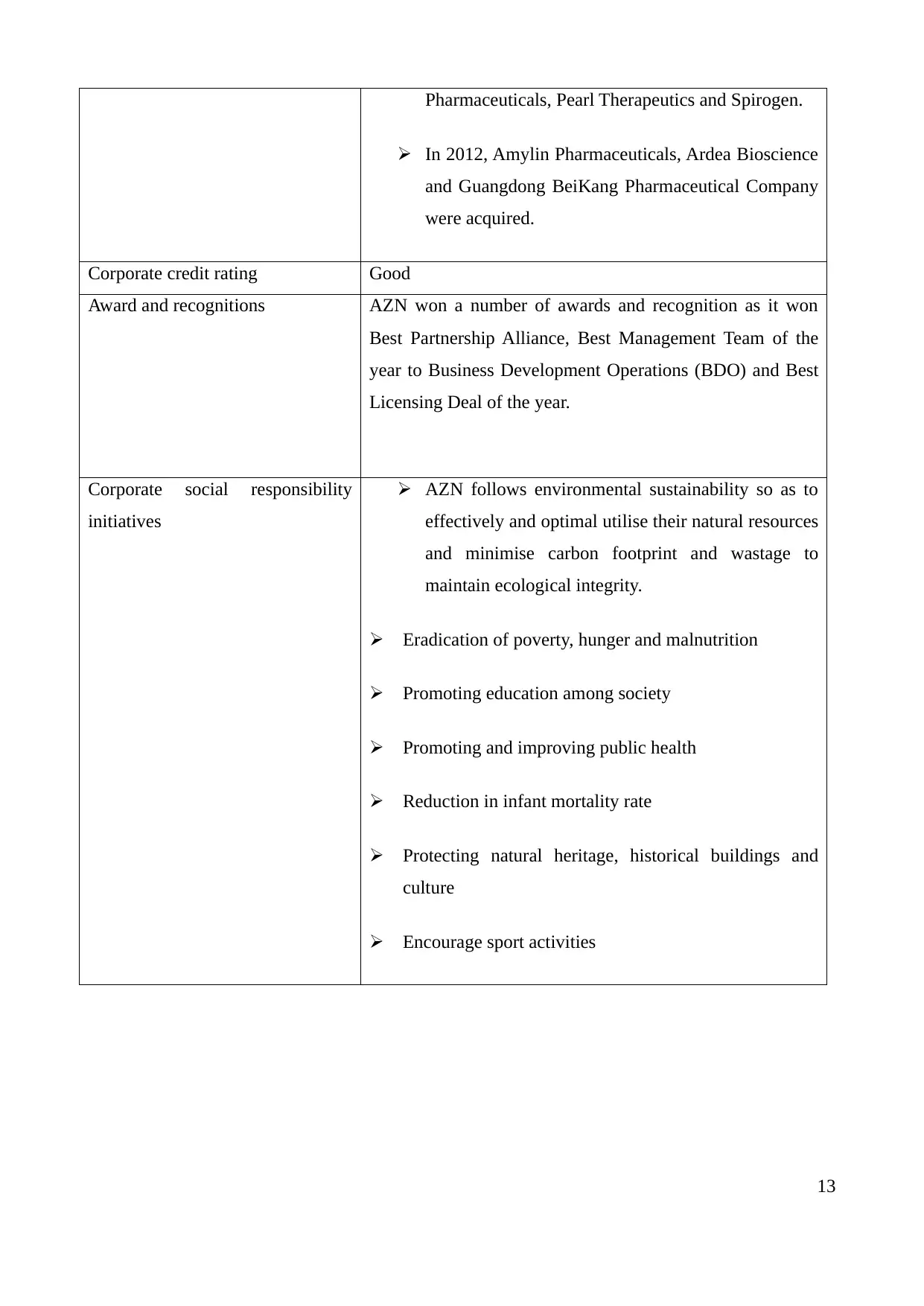
Pharmaceuticals, Pearl Therapeutics and Spirogen.
In 2012, Amylin Pharmaceuticals, Ardea Bioscience
and Guangdong BeiKang Pharmaceutical Company
were acquired.
Corporate credit rating Good
Award and recognitions AZN won a number of awards and recognition as it won
Best Partnership Alliance, Best Management Team of the
year to Business Development Operations (BDO) and Best
Licensing Deal of the year.
Corporate social responsibility
initiatives
AZN follows environmental sustainability so as to
effectively and optimal utilise their natural resources
and minimise carbon footprint and wastage to
maintain ecological integrity.
Eradication of poverty, hunger and malnutrition
Promoting education among society
Promoting and improving public health
Reduction in infant mortality rate
Protecting natural heritage, historical buildings and
culture
Encourage sport activities
13
In 2012, Amylin Pharmaceuticals, Ardea Bioscience
and Guangdong BeiKang Pharmaceutical Company
were acquired.
Corporate credit rating Good
Award and recognitions AZN won a number of awards and recognition as it won
Best Partnership Alliance, Best Management Team of the
year to Business Development Operations (BDO) and Best
Licensing Deal of the year.
Corporate social responsibility
initiatives
AZN follows environmental sustainability so as to
effectively and optimal utilise their natural resources
and minimise carbon footprint and wastage to
maintain ecological integrity.
Eradication of poverty, hunger and malnutrition
Promoting education among society
Promoting and improving public health
Reduction in infant mortality rate
Protecting natural heritage, historical buildings and
culture
Encourage sport activities
13
Paraphrase This Document
Need a fresh take? Get an instant paraphrase of this document with our AI Paraphraser
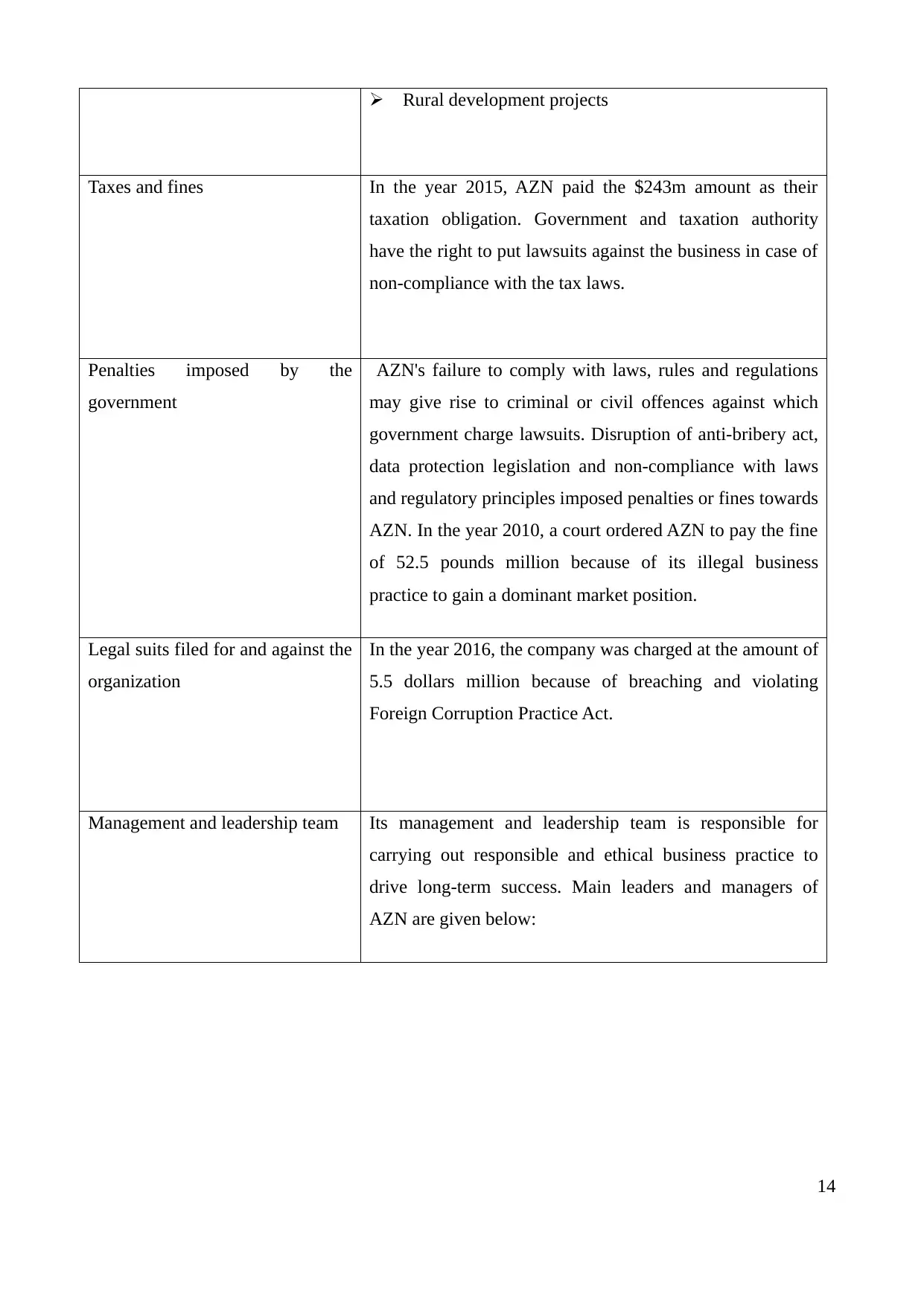
Rural development projects
Taxes and fines In the year 2015, AZN paid the $243m amount as their
taxation obligation. Government and taxation authority
have the right to put lawsuits against the business in case of
non-compliance with the tax laws.
Penalties imposed by the
government
AZN's failure to comply with laws, rules and regulations
may give rise to criminal or civil offences against which
government charge lawsuits. Disruption of anti-bribery act,
data protection legislation and non-compliance with laws
and regulatory principles imposed penalties or fines towards
AZN. In the year 2010, a court ordered AZN to pay the fine
of 52.5 pounds million because of its illegal business
practice to gain a dominant market position.
Legal suits filed for and against the
organization
In the year 2016, the company was charged at the amount of
5.5 dollars million because of breaching and violating
Foreign Corruption Practice Act.
Management and leadership team Its management and leadership team is responsible for
carrying out responsible and ethical business practice to
drive long-term success. Main leaders and managers of
AZN are given below:
14
Taxes and fines In the year 2015, AZN paid the $243m amount as their
taxation obligation. Government and taxation authority
have the right to put lawsuits against the business in case of
non-compliance with the tax laws.
Penalties imposed by the
government
AZN's failure to comply with laws, rules and regulations
may give rise to criminal or civil offences against which
government charge lawsuits. Disruption of anti-bribery act,
data protection legislation and non-compliance with laws
and regulatory principles imposed penalties or fines towards
AZN. In the year 2010, a court ordered AZN to pay the fine
of 52.5 pounds million because of its illegal business
practice to gain a dominant market position.
Legal suits filed for and against the
organization
In the year 2016, the company was charged at the amount of
5.5 dollars million because of breaching and violating
Foreign Corruption Practice Act.
Management and leadership team Its management and leadership team is responsible for
carrying out responsible and ethical business practice to
drive long-term success. Main leaders and managers of
AZN are given below:
14
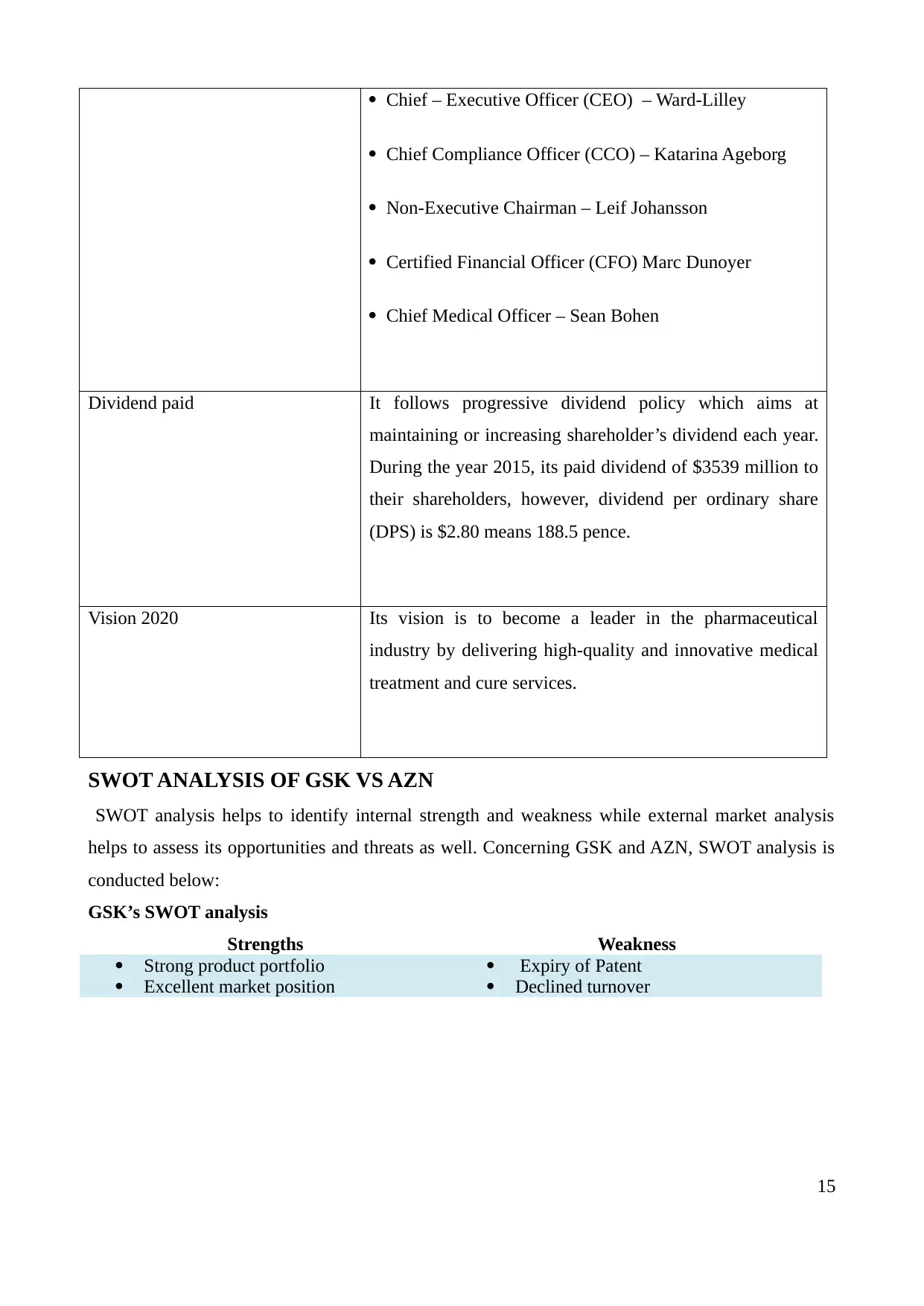
Chief – Executive Officer (CEO) – Ward-Lilley
Chief Compliance Officer (CCO) – Katarina Ageborg
Non-Executive Chairman – Leif Johansson
Certified Financial Officer (CFO) Marc Dunoyer
Chief Medical Officer – Sean Bohen
Dividend paid It follows progressive dividend policy which aims at
maintaining or increasing shareholder’s dividend each year.
During the year 2015, its paid dividend of $3539 million to
their shareholders, however, dividend per ordinary share
(DPS) is $2.80 means 188.5 pence.
Vision 2020 Its vision is to become a leader in the pharmaceutical
industry by delivering high-quality and innovative medical
treatment and cure services.
SWOT ANALYSIS OF GSK VS AZN
SWOT analysis helps to identify internal strength and weakness while external market analysis
helps to assess its opportunities and threats as well. Concerning GSK and AZN, SWOT analysis is
conducted below:
GSK’s SWOT analysis
Strengths Weakness
Strong product portfolio
Excellent market position
Expiry of Patent
Declined turnover
15
Chief Compliance Officer (CCO) – Katarina Ageborg
Non-Executive Chairman – Leif Johansson
Certified Financial Officer (CFO) Marc Dunoyer
Chief Medical Officer – Sean Bohen
Dividend paid It follows progressive dividend policy which aims at
maintaining or increasing shareholder’s dividend each year.
During the year 2015, its paid dividend of $3539 million to
their shareholders, however, dividend per ordinary share
(DPS) is $2.80 means 188.5 pence.
Vision 2020 Its vision is to become a leader in the pharmaceutical
industry by delivering high-quality and innovative medical
treatment and cure services.
SWOT ANALYSIS OF GSK VS AZN
SWOT analysis helps to identify internal strength and weakness while external market analysis
helps to assess its opportunities and threats as well. Concerning GSK and AZN, SWOT analysis is
conducted below:
GSK’s SWOT analysis
Strengths Weakness
Strong product portfolio
Excellent market position
Expiry of Patent
Declined turnover
15

Worldwide presence
Extensive Research and Development
High market turnover
Chemical industry and resource
efficiency rewards
Requirement of invention of new drug
and medicines
Needs to enter into new markets
Controversies regards to drug safety
negatively impact its corporate image
Opportunity Threats
Ageing UK population
Expansion into emerging economies i.e.
BRIC
Rising consumer awareness
Mergers and acquisition
Invention of new drug and medicines
Innovative technology
Tough competition from Amgen, AZN,
Abbott Laboratories
End of Intellectual Property Rights like
patent
Expensive research
High regulations
Economic downturn in Europe
AZN’s SWOT analysis
Strengths Weakness
Rapid and instant decision-making
Presence in emerging markets
Worldwide operations
Strong and dedicated R&D team
Strong brand and product portfolio
Global sales
Negative effect on business operations
due to drug shortage in Cefotan
Pricing issues adversely effected its
corporate reputation
Product discontinuation due to late-
stage development of its business
model Pipeline
Legal controversies and proceedings
regards to patent
Dependencies upon small molecules
Opportunity Threats
Leverage presence through expansion
in emerging economies
Copycat generic drug and medicines
Exposure to high level of competition
16
Extensive Research and Development
High market turnover
Chemical industry and resource
efficiency rewards
Requirement of invention of new drug
and medicines
Needs to enter into new markets
Controversies regards to drug safety
negatively impact its corporate image
Opportunity Threats
Ageing UK population
Expansion into emerging economies i.e.
BRIC
Rising consumer awareness
Mergers and acquisition
Invention of new drug and medicines
Innovative technology
Tough competition from Amgen, AZN,
Abbott Laboratories
End of Intellectual Property Rights like
patent
Expensive research
High regulations
Economic downturn in Europe
AZN’s SWOT analysis
Strengths Weakness
Rapid and instant decision-making
Presence in emerging markets
Worldwide operations
Strong and dedicated R&D team
Strong brand and product portfolio
Global sales
Negative effect on business operations
due to drug shortage in Cefotan
Pricing issues adversely effected its
corporate reputation
Product discontinuation due to late-
stage development of its business
model Pipeline
Legal controversies and proceedings
regards to patent
Dependencies upon small molecules
Opportunity Threats
Leverage presence through expansion
in emerging economies
Copycat generic drug and medicines
Exposure to high level of competition
16
Secure Best Marks with AI Grader
Need help grading? Try our AI Grader for instant feedback on your assignments.
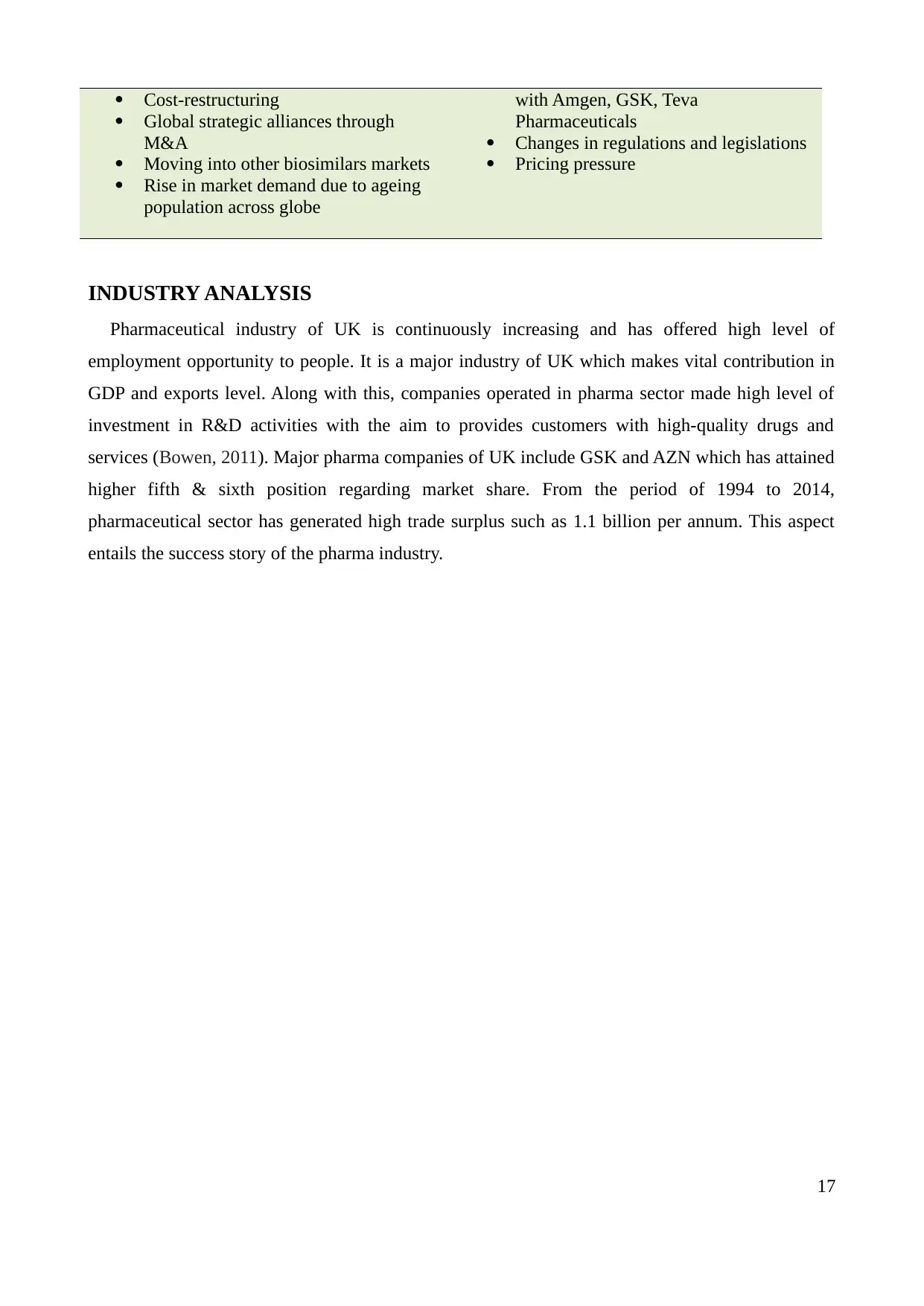
Cost-restructuring
Global strategic alliances through
M&A
Moving into other biosimilars markets
Rise in market demand due to ageing
population across globe
with Amgen, GSK, Teva
Pharmaceuticals
Changes in regulations and legislations
Pricing pressure
INDUSTRY ANALYSIS
Pharmaceutical industry of UK is continuously increasing and has offered high level of
employment opportunity to people. It is a major industry of UK which makes vital contribution in
GDP and exports level. Along with this, companies operated in pharma sector made high level of
investment in R&D activities with the aim to provides customers with high-quality drugs and
services (Bowen, 2011). Major pharma companies of UK include GSK and AZN which has attained
higher fifth & sixth position regarding market share. From the period of 1994 to 2014,
pharmaceutical sector has generated high trade surplus such as 1.1 billion per annum. This aspect
entails the success story of the pharma industry.
17
Global strategic alliances through
M&A
Moving into other biosimilars markets
Rise in market demand due to ageing
population across globe
with Amgen, GSK, Teva
Pharmaceuticals
Changes in regulations and legislations
Pricing pressure
INDUSTRY ANALYSIS
Pharmaceutical industry of UK is continuously increasing and has offered high level of
employment opportunity to people. It is a major industry of UK which makes vital contribution in
GDP and exports level. Along with this, companies operated in pharma sector made high level of
investment in R&D activities with the aim to provides customers with high-quality drugs and
services (Bowen, 2011). Major pharma companies of UK include GSK and AZN which has attained
higher fifth & sixth position regarding market share. From the period of 1994 to 2014,
pharmaceutical sector has generated high trade surplus such as 1.1 billion per annum. This aspect
entails the success story of the pharma industry.
17
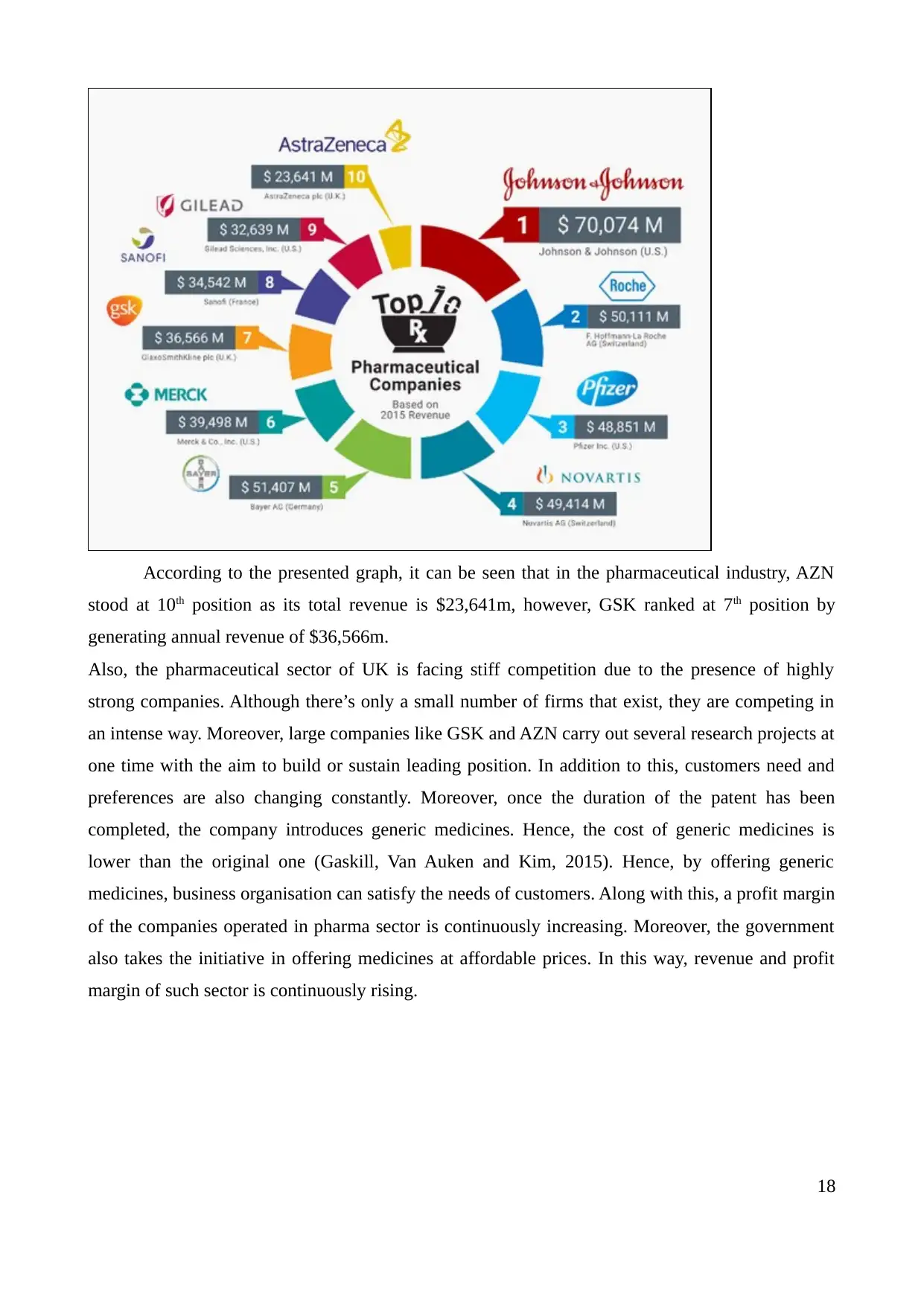
According to the presented graph, it can be seen that in the pharmaceutical industry, AZN
stood at 10th position as its total revenue is $23,641m, however, GSK ranked at 7th position by
generating annual revenue of $36,566m.
Also, the pharmaceutical sector of UK is facing stiff competition due to the presence of highly
strong companies. Although there’s only a small number of firms that exist, they are competing in
an intense way. Moreover, large companies like GSK and AZN carry out several research projects at
one time with the aim to build or sustain leading position. In addition to this, customers need and
preferences are also changing constantly. Moreover, once the duration of the patent has been
completed, the company introduces generic medicines. Hence, the cost of generic medicines is
lower than the original one (Gaskill, Van Auken and Kim, 2015). Hence, by offering generic
medicines, business organisation can satisfy the needs of customers. Along with this, a profit margin
of the companies operated in pharma sector is continuously increasing. Moreover, the government
also takes the initiative in offering medicines at affordable prices. In this way, revenue and profit
margin of such sector is continuously rising.
18
stood at 10th position as its total revenue is $23,641m, however, GSK ranked at 7th position by
generating annual revenue of $36,566m.
Also, the pharmaceutical sector of UK is facing stiff competition due to the presence of highly
strong companies. Although there’s only a small number of firms that exist, they are competing in
an intense way. Moreover, large companies like GSK and AZN carry out several research projects at
one time with the aim to build or sustain leading position. In addition to this, customers need and
preferences are also changing constantly. Moreover, once the duration of the patent has been
completed, the company introduces generic medicines. Hence, the cost of generic medicines is
lower than the original one (Gaskill, Van Auken and Kim, 2015). Hence, by offering generic
medicines, business organisation can satisfy the needs of customers. Along with this, a profit margin
of the companies operated in pharma sector is continuously increasing. Moreover, the government
also takes the initiative in offering medicines at affordable prices. In this way, revenue and profit
margin of such sector is continuously rising.
18

However, in the accounting year 2013 and 2014 sales revenue as well as the profit margin of GSK
and AZN decreased to a large extent. The reason behind this high level of unemployment situation
exists in the UK. Hence, due to this, business organisations performed in pharma sector faced
difficulty about the generation of enough amount of sales (Hung and Subramanyam, 2007). In
addition to this, UK has many pharma companies which are listed on London stock exchange.
Further, UK has top 25 companies which make the investment in the R&D to the large extent ion
which GSK and AZN has captured top positions as compared to other firms. Hence, in such
research-intensive industry companies of UK have made their best efforts and thereby contributed
to the economic growth and development.
Conclusion
From the above analysis, it has been concluded that GSK is one of the largest and leading
pharmaceutical companies in UK, as compared to rival firms. Besides this, it has been concluded
that strategies and policies developed by GSK is sound in comparison to AZN. Further, it can be
stated that GSK has several strengths regarding skilled personnel, high R&D investment compared
to AZN. It can be seen in the report that both companies have the opportunity to attain success by
introducing highly effectual and innovative medicines.
Ratio analysis and financial performance
Ratio analysis may be defined as a tool which assists a business organisation in evaluating their
financial performance and position against rival firms. It also offers an opportunity to the business
enterprise to compare their financials against previous years. Along with this, such financial
statement analysis tool provides stakeholders with huge amount of information that aids in the
effective and profitable decision making.
Current Ratio:
Current Ratio = Current Assets / Current Liabilities
This ratio furnishes information about the company's ability about fulfilling the current obligations
over the current assets (Brealey, 2012). By using such ratios companies and their stakeholders can
evaluate the liquidity position and performance of the firm.
Company 2013 2014
19
and AZN decreased to a large extent. The reason behind this high level of unemployment situation
exists in the UK. Hence, due to this, business organisations performed in pharma sector faced
difficulty about the generation of enough amount of sales (Hung and Subramanyam, 2007). In
addition to this, UK has many pharma companies which are listed on London stock exchange.
Further, UK has top 25 companies which make the investment in the R&D to the large extent ion
which GSK and AZN has captured top positions as compared to other firms. Hence, in such
research-intensive industry companies of UK have made their best efforts and thereby contributed
to the economic growth and development.
Conclusion
From the above analysis, it has been concluded that GSK is one of the largest and leading
pharmaceutical companies in UK, as compared to rival firms. Besides this, it has been concluded
that strategies and policies developed by GSK is sound in comparison to AZN. Further, it can be
stated that GSK has several strengths regarding skilled personnel, high R&D investment compared
to AZN. It can be seen in the report that both companies have the opportunity to attain success by
introducing highly effectual and innovative medicines.
Ratio analysis and financial performance
Ratio analysis may be defined as a tool which assists a business organisation in evaluating their
financial performance and position against rival firms. It also offers an opportunity to the business
enterprise to compare their financials against previous years. Along with this, such financial
statement analysis tool provides stakeholders with huge amount of information that aids in the
effective and profitable decision making.
Current Ratio:
Current Ratio = Current Assets / Current Liabilities
This ratio furnishes information about the company's ability about fulfilling the current obligations
over the current assets (Brealey, 2012). By using such ratios companies and their stakeholders can
evaluate the liquidity position and performance of the firm.
Company 2013 2014
19
Paraphrase This Document
Need a fresh take? Get an instant paraphrase of this document with our AI Paraphraser

/ year
GSK 1.11 1.1
1.27 0.96
AZN
The above-mentioned table presents that current ratio of both the organisations such as GSK
and AZN is showing decreasing trend. In 2013 and 2014 current ratio of GSK is 1.11 and 1.10. On
the other side, a current ratio of AZN declined from 1.27 to .96 at the end of the accounting year
2014. Hence, in comparison to the ideal ratio such as 2:1 both the firms do not have enough amount
of current assets to meet the obligations. The reason behind this in the financial year 2014 both the
companies failed to generate enough amount of sales in contrast to the before years. However, as
compared to AZN liquidity position and performance of GSK is good.
Asset Turnover Ratio:
Asset Turnover = Sales or Revenues / Total Assets
It presents the company's ability about the generation of sales from the total assets (Brown and
Petersen, 2011). By dividing the total assets from net income, company can truly measure its
performance to a large extent.
20
GSK 1.11 1.1
1.27 0.96
AZN
The above-mentioned table presents that current ratio of both the organisations such as GSK
and AZN is showing decreasing trend. In 2013 and 2014 current ratio of GSK is 1.11 and 1.10. On
the other side, a current ratio of AZN declined from 1.27 to .96 at the end of the accounting year
2014. Hence, in comparison to the ideal ratio such as 2:1 both the firms do not have enough amount
of current assets to meet the obligations. The reason behind this in the financial year 2014 both the
companies failed to generate enough amount of sales in contrast to the before years. However, as
compared to AZN liquidity position and performance of GSK is good.
Asset Turnover Ratio:
Asset Turnover = Sales or Revenues / Total Assets
It presents the company's ability about the generation of sales from the total assets (Brown and
Petersen, 2011). By dividing the total assets from net income, company can truly measure its
performance to a large extent.
20
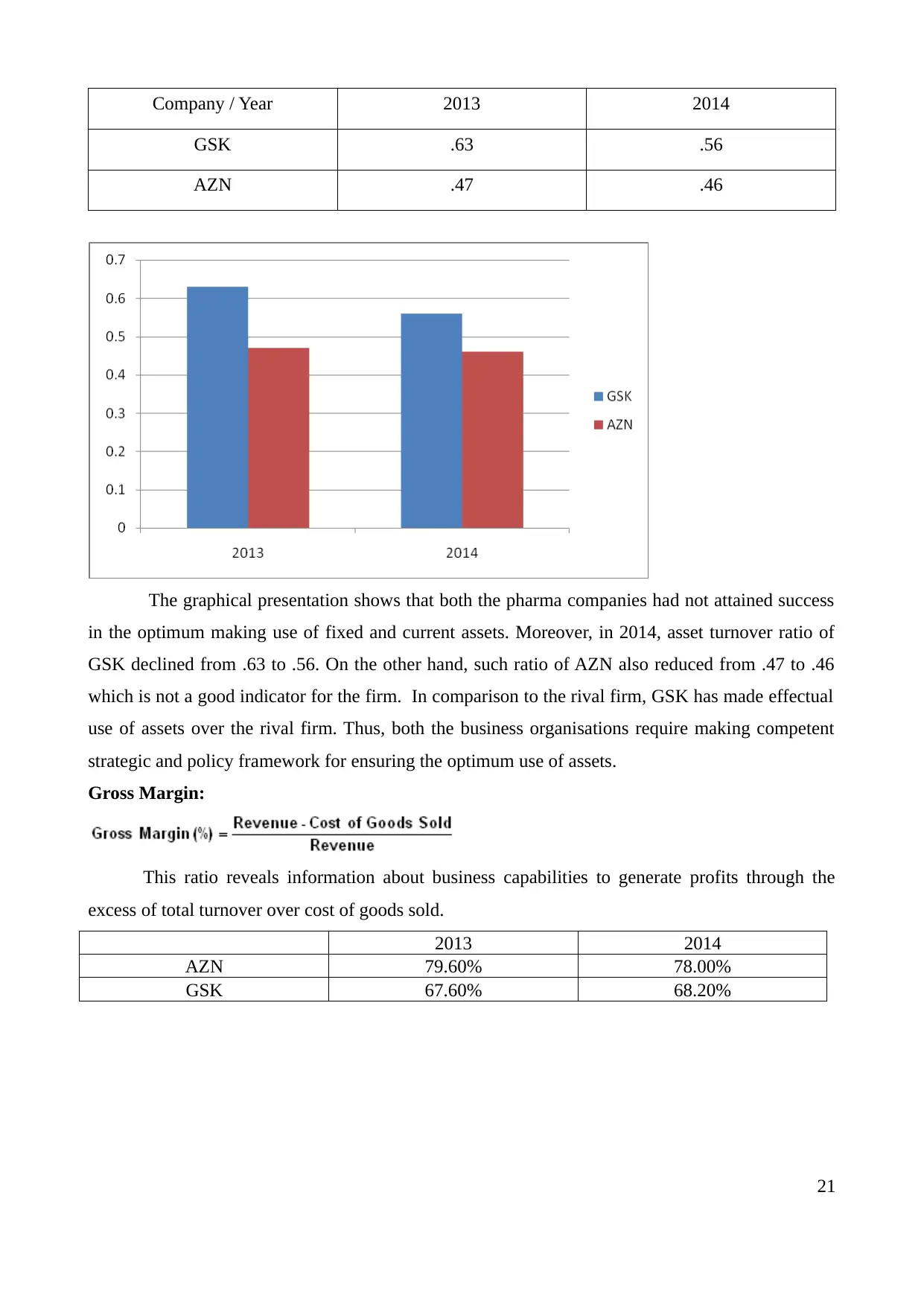
Company / Year 2013 2014
GSK .63 .56
AZN .47 .46
The graphical presentation shows that both the pharma companies had not attained success
in the optimum making use of fixed and current assets. Moreover, in 2014, asset turnover ratio of
GSK declined from .63 to .56. On the other hand, such ratio of AZN also reduced from .47 to .46
which is not a good indicator for the firm. In comparison to the rival firm, GSK has made effectual
use of assets over the rival firm. Thus, both the business organisations require making competent
strategic and policy framework for ensuring the optimum use of assets.
Gross Margin:
This ratio reveals information about business capabilities to generate profits through the
excess of total turnover over cost of goods sold.
2013 2014
AZN 79.60% 78.00%
GSK 67.60% 68.20%
21
GSK .63 .56
AZN .47 .46
The graphical presentation shows that both the pharma companies had not attained success
in the optimum making use of fixed and current assets. Moreover, in 2014, asset turnover ratio of
GSK declined from .63 to .56. On the other hand, such ratio of AZN also reduced from .47 to .46
which is not a good indicator for the firm. In comparison to the rival firm, GSK has made effectual
use of assets over the rival firm. Thus, both the business organisations require making competent
strategic and policy framework for ensuring the optimum use of assets.
Gross Margin:
This ratio reveals information about business capabilities to generate profits through the
excess of total turnover over cost of goods sold.
2013 2014
AZN 79.60% 78.00%
GSK 67.60% 68.20%
21
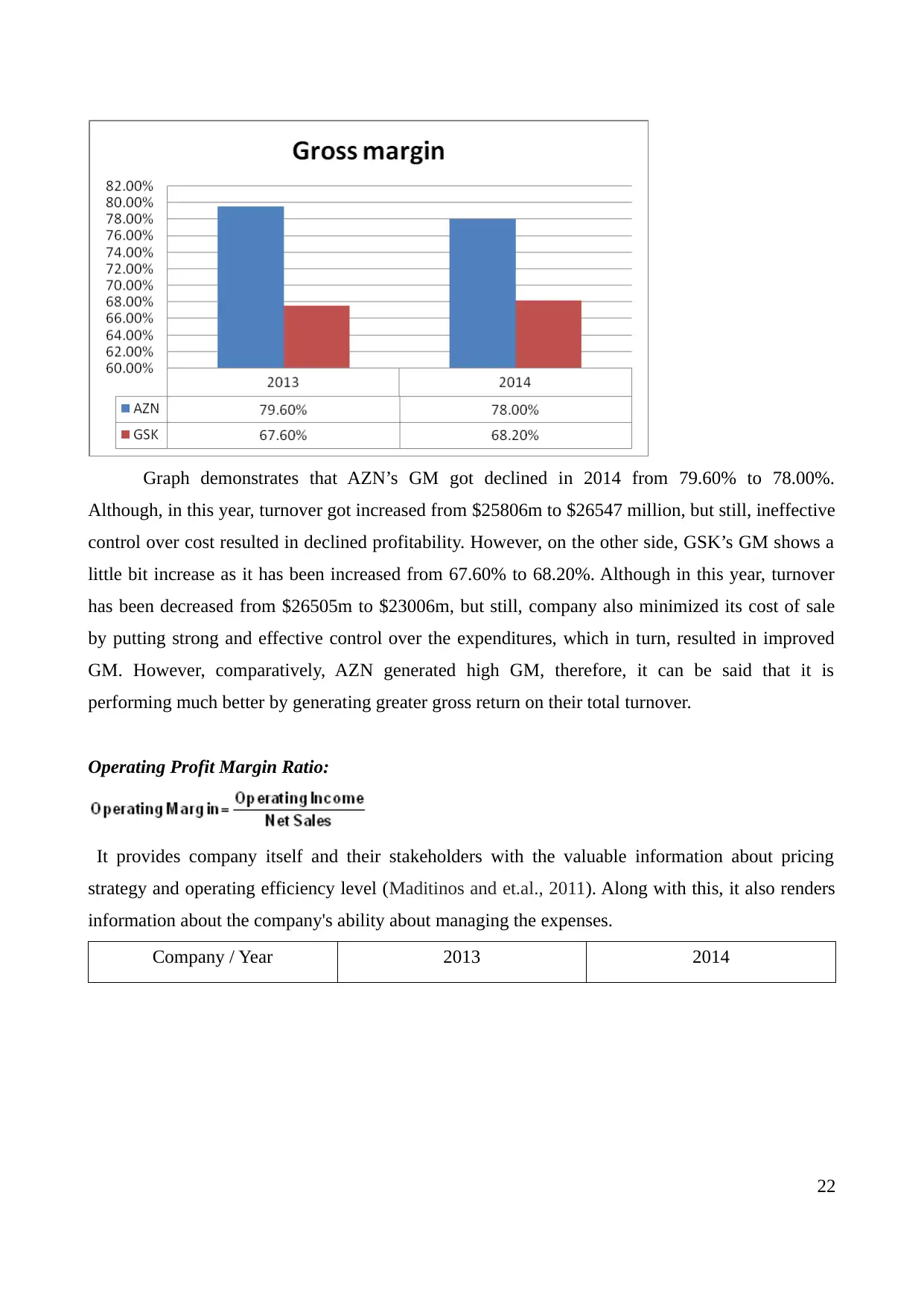
Graph demonstrates that AZN’s GM got declined in 2014 from 79.60% to 78.00%.
Although, in this year, turnover got increased from $25806m to $26547 million, but still, ineffective
control over cost resulted in declined profitability. However, on the other side, GSK’s GM shows a
little bit increase as it has been increased from 67.60% to 68.20%. Although in this year, turnover
has been decreased from $26505m to $23006m, but still, company also minimized its cost of sale
by putting strong and effective control over the expenditures, which in turn, resulted in improved
GM. However, comparatively, AZN generated high GM, therefore, it can be said that it is
performing much better by generating greater gross return on their total turnover.
Operating Profit Margin Ratio:
It provides company itself and their stakeholders with the valuable information about pricing
strategy and operating efficiency level (Maditinos and et.al., 2011). Along with this, it also renders
information about the company's ability about managing the expenses.
Company / Year 2013 2014
22
Although, in this year, turnover got increased from $25806m to $26547 million, but still, ineffective
control over cost resulted in declined profitability. However, on the other side, GSK’s GM shows a
little bit increase as it has been increased from 67.60% to 68.20%. Although in this year, turnover
has been decreased from $26505m to $23006m, but still, company also minimized its cost of sale
by putting strong and effective control over the expenditures, which in turn, resulted in improved
GM. However, comparatively, AZN generated high GM, therefore, it can be said that it is
performing much better by generating greater gross return on their total turnover.
Operating Profit Margin Ratio:
It provides company itself and their stakeholders with the valuable information about pricing
strategy and operating efficiency level (Maditinos and et.al., 2011). Along with this, it also renders
information about the company's ability about managing the expenses.
Company / Year 2013 2014
22
Secure Best Marks with AI Grader
Need help grading? Try our AI Grader for instant feedback on your assignments.
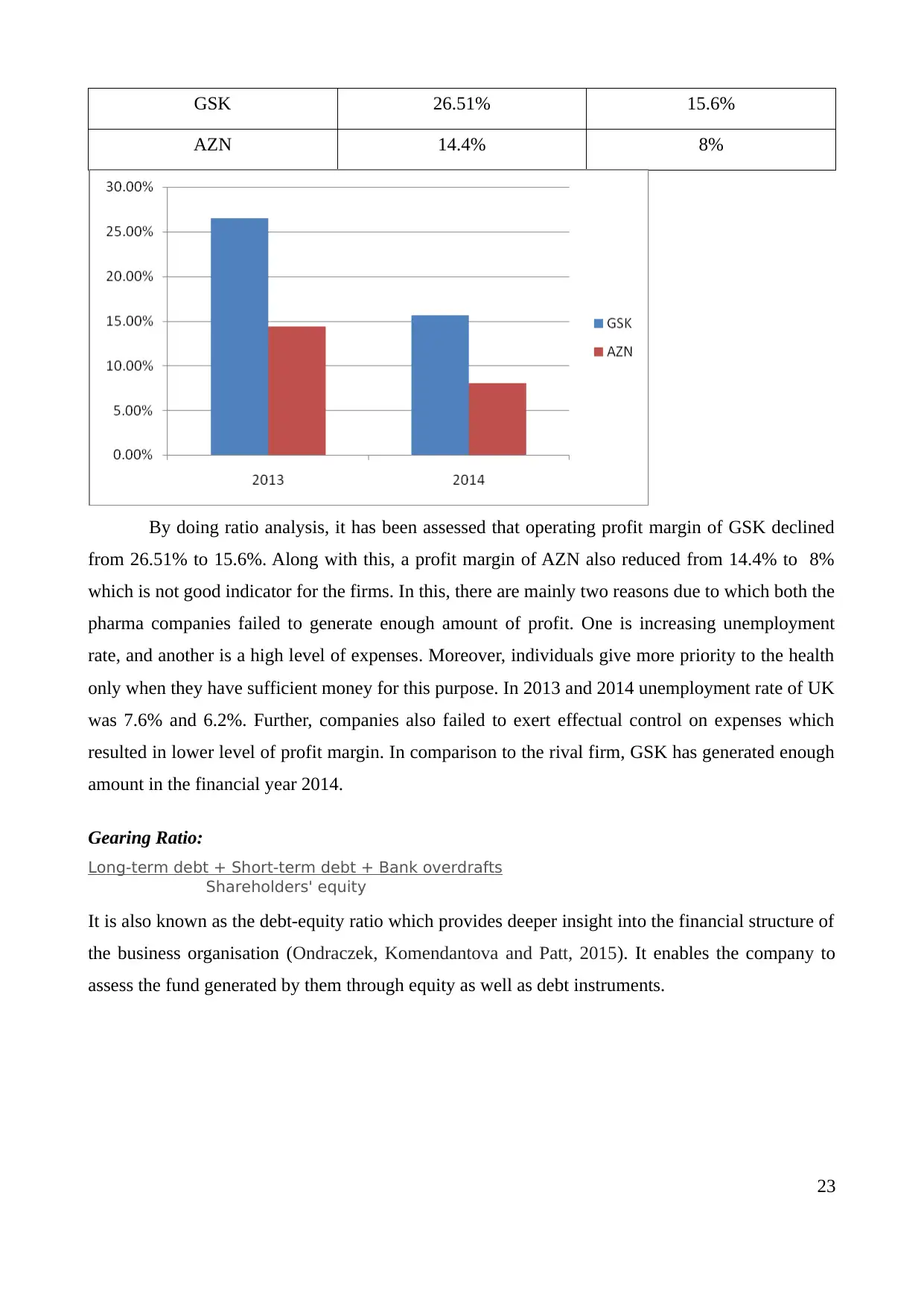
GSK 26.51% 15.6%
AZN 14.4% 8%
By doing ratio analysis, it has been assessed that operating profit margin of GSK declined
from 26.51% to 15.6%. Along with this, a profit margin of AZN also reduced from 14.4% to 8%
which is not good indicator for the firms. In this, there are mainly two reasons due to which both the
pharma companies failed to generate enough amount of profit. One is increasing unemployment
rate, and another is a high level of expenses. Moreover, individuals give more priority to the health
only when they have sufficient money for this purpose. In 2013 and 2014 unemployment rate of UK
was 7.6% and 6.2%. Further, companies also failed to exert effectual control on expenses which
resulted in lower level of profit margin. In comparison to the rival firm, GSK has generated enough
amount in the financial year 2014.
Gearing Ratio:
Long-term debt + Short-term debt + Bank overdrafts
Shareholders' equity
It is also known as the debt-equity ratio which provides deeper insight into the financial structure of
the business organisation (Ondraczek, Komendantova and Patt, 2015). It enables the company to
assess the fund generated by them through equity as well as debt instruments.
23
AZN 14.4% 8%
By doing ratio analysis, it has been assessed that operating profit margin of GSK declined
from 26.51% to 15.6%. Along with this, a profit margin of AZN also reduced from 14.4% to 8%
which is not good indicator for the firms. In this, there are mainly two reasons due to which both the
pharma companies failed to generate enough amount of profit. One is increasing unemployment
rate, and another is a high level of expenses. Moreover, individuals give more priority to the health
only when they have sufficient money for this purpose. In 2013 and 2014 unemployment rate of UK
was 7.6% and 6.2%. Further, companies also failed to exert effectual control on expenses which
resulted in lower level of profit margin. In comparison to the rival firm, GSK has generated enough
amount in the financial year 2014.
Gearing Ratio:
Long-term debt + Short-term debt + Bank overdrafts
Shareholders' equity
It is also known as the debt-equity ratio which provides deeper insight into the financial structure of
the business organisation (Ondraczek, Komendantova and Patt, 2015). It enables the company to
assess the fund generated by them through equity as well as debt instruments.
23
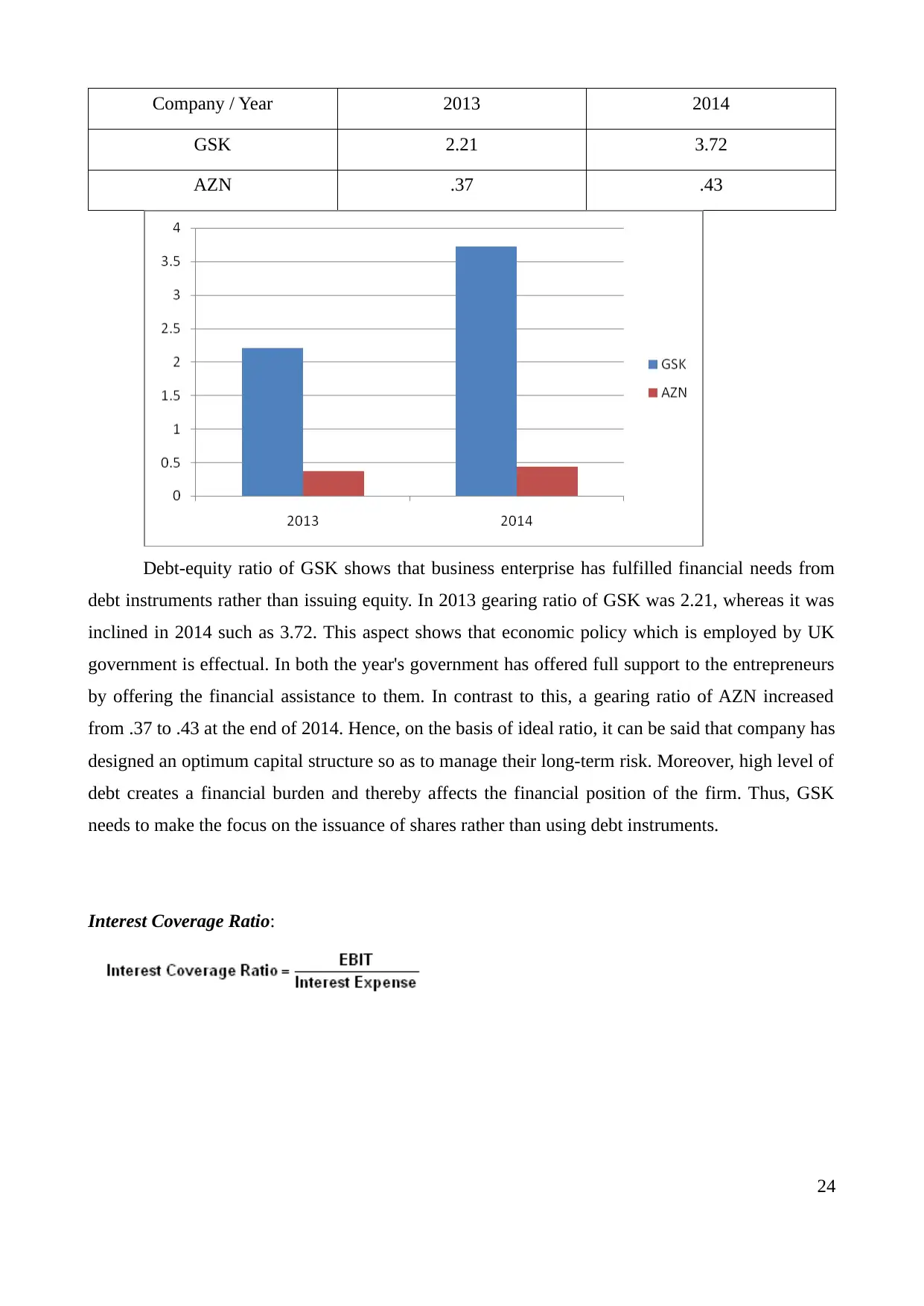
Company / Year 2013 2014
GSK 2.21 3.72
AZN .37 .43
Debt-equity ratio of GSK shows that business enterprise has fulfilled financial needs from
debt instruments rather than issuing equity. In 2013 gearing ratio of GSK was 2.21, whereas it was
inclined in 2014 such as 3.72. This aspect shows that economic policy which is employed by UK
government is effectual. In both the year's government has offered full support to the entrepreneurs
by offering the financial assistance to them. In contrast to this, a gearing ratio of AZN increased
from .37 to .43 at the end of 2014. Hence, on the basis of ideal ratio, it can be said that company has
designed an optimum capital structure so as to manage their long-term risk. Moreover, high level of
debt creates a financial burden and thereby affects the financial position of the firm. Thus, GSK
needs to make the focus on the issuance of shares rather than using debt instruments.
Interest Coverage Ratio:
24
GSK 2.21 3.72
AZN .37 .43
Debt-equity ratio of GSK shows that business enterprise has fulfilled financial needs from
debt instruments rather than issuing equity. In 2013 gearing ratio of GSK was 2.21, whereas it was
inclined in 2014 such as 3.72. This aspect shows that economic policy which is employed by UK
government is effectual. In both the year's government has offered full support to the entrepreneurs
by offering the financial assistance to them. In contrast to this, a gearing ratio of AZN increased
from .37 to .43 at the end of 2014. Hence, on the basis of ideal ratio, it can be said that company has
designed an optimum capital structure so as to manage their long-term risk. Moreover, high level of
debt creates a financial burden and thereby affects the financial position of the firm. Thus, GSK
needs to make the focus on the issuance of shares rather than using debt instruments.
Interest Coverage Ratio:
24

Such financial ratio serves information about the company's ability about meeting the interest
expenses from profit amount.
Company / Year 2013 2014
GSK 10.16 times 5.31 times
AZN 7.60 times 3.98 times
The above-presented ratio analysis exhibits that GSK is highly able about meeting the
interest expenses from profit. In 2014, due to the generation of the lower amount of sales
company's ability about meeting the interest expenses are significantly decreased. In the year of
2013 and 2014, Interest coverage ratio of GSK was 10.16 times & 5.31 times. On the other hand,
interest coverage ratio of AZN was 7.60 times and 3.98 times respectively. Thus, the company
needs to make the focus on promotional aspects which in turn helps them in enhancing the sales
revenue and thereby ability about meeting the interest expenses. By taking into account the ideal
ratio such as 1.5:1 times it can be said that both the firms such as GSK and AZN would become
able to meet both principal and interest amount on time. This in turn creates a good image of the
firm in the mind of stakeholders such as financial institutions, suppliers etc. Such coverage ratio
will help the firm in raising funds in the upcoming time period more effectually.
25
expenses from profit amount.
Company / Year 2013 2014
GSK 10.16 times 5.31 times
AZN 7.60 times 3.98 times
The above-presented ratio analysis exhibits that GSK is highly able about meeting the
interest expenses from profit. In 2014, due to the generation of the lower amount of sales
company's ability about meeting the interest expenses are significantly decreased. In the year of
2013 and 2014, Interest coverage ratio of GSK was 10.16 times & 5.31 times. On the other hand,
interest coverage ratio of AZN was 7.60 times and 3.98 times respectively. Thus, the company
needs to make the focus on promotional aspects which in turn helps them in enhancing the sales
revenue and thereby ability about meeting the interest expenses. By taking into account the ideal
ratio such as 1.5:1 times it can be said that both the firms such as GSK and AZN would become
able to meet both principal and interest amount on time. This in turn creates a good image of the
firm in the mind of stakeholders such as financial institutions, suppliers etc. Such coverage ratio
will help the firm in raising funds in the upcoming time period more effectually.
25
Paraphrase This Document
Need a fresh take? Get an instant paraphrase of this document with our AI Paraphraser
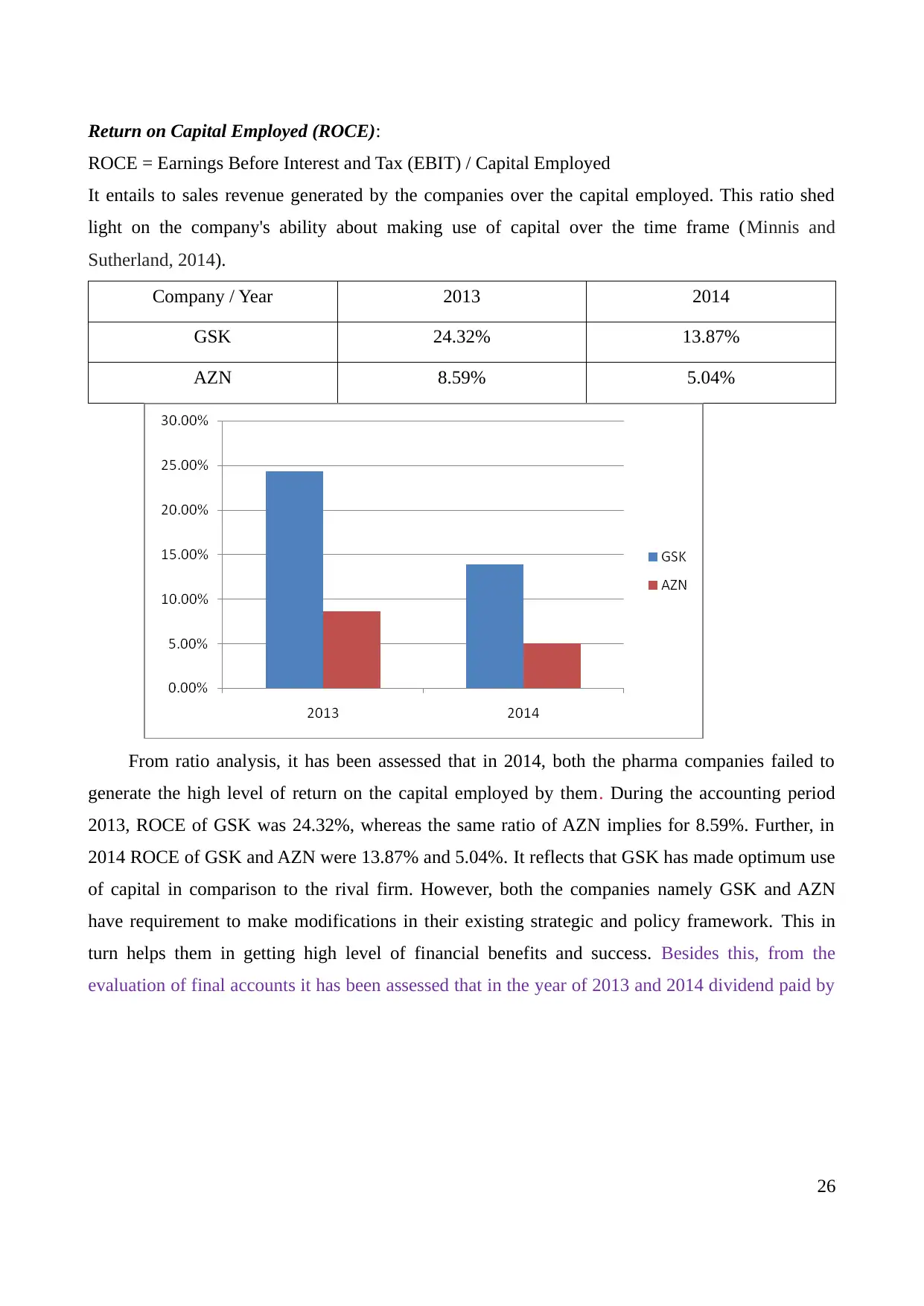
Return on Capital Employed (ROCE):
ROCE = Earnings Before Interest and Tax (EBIT) / Capital Employed
It entails to sales revenue generated by the companies over the capital employed. This ratio shed
light on the company's ability about making use of capital over the time frame (Minnis and
Sutherland, 2014).
Company / Year 2013 2014
GSK 24.32% 13.87%
AZN 8.59% 5.04%
From ratio analysis, it has been assessed that in 2014, both the pharma companies failed to
generate the high level of return on the capital employed by them. During the accounting period
2013, ROCE of GSK was 24.32%, whereas the same ratio of AZN implies for 8.59%. Further, in
2014 ROCE of GSK and AZN were 13.87% and 5.04%. It reflects that GSK has made optimum use
of capital in comparison to the rival firm. However, both the companies namely GSK and AZN
have requirement to make modifications in their existing strategic and policy framework. This in
turn helps them in getting high level of financial benefits and success. Besides this, from the
evaluation of final accounts it has been assessed that in the year of 2013 and 2014 dividend paid by
26
ROCE = Earnings Before Interest and Tax (EBIT) / Capital Employed
It entails to sales revenue generated by the companies over the capital employed. This ratio shed
light on the company's ability about making use of capital over the time frame (Minnis and
Sutherland, 2014).
Company / Year 2013 2014
GSK 24.32% 13.87%
AZN 8.59% 5.04%
From ratio analysis, it has been assessed that in 2014, both the pharma companies failed to
generate the high level of return on the capital employed by them. During the accounting period
2013, ROCE of GSK was 24.32%, whereas the same ratio of AZN implies for 8.59%. Further, in
2014 ROCE of GSK and AZN were 13.87% and 5.04%. It reflects that GSK has made optimum use
of capital in comparison to the rival firm. However, both the companies namely GSK and AZN
have requirement to make modifications in their existing strategic and policy framework. This in
turn helps them in getting high level of financial benefits and success. Besides this, from the
evaluation of final accounts it has been assessed that in the year of 2013 and 2014 dividend paid by
26
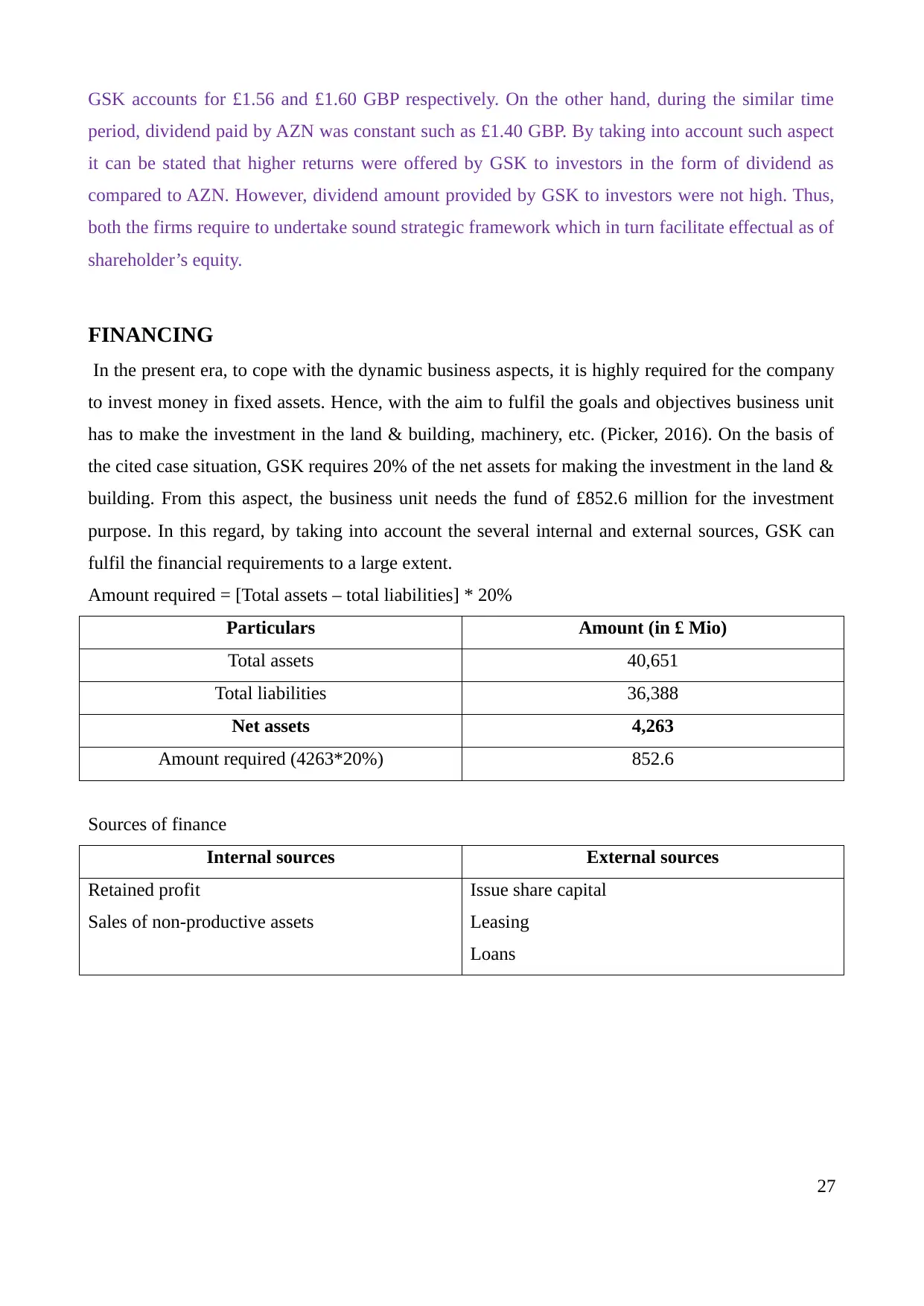
GSK accounts for £1.56 and £1.60 GBP respectively. On the other hand, during the similar time
period, dividend paid by AZN was constant such as £1.40 GBP. By taking into account such aspect
it can be stated that higher returns were offered by GSK to investors in the form of dividend as
compared to AZN. However, dividend amount provided by GSK to investors were not high. Thus,
both the firms require to undertake sound strategic framework which in turn facilitate effectual as of
shareholder’s equity.
FINANCING
In the present era, to cope with the dynamic business aspects, it is highly required for the company
to invest money in fixed assets. Hence, with the aim to fulfil the goals and objectives business unit
has to make the investment in the land & building, machinery, etc. (Picker, 2016). On the basis of
the cited case situation, GSK requires 20% of the net assets for making the investment in the land &
building. From this aspect, the business unit needs the fund of £852.6 million for the investment
purpose. In this regard, by taking into account the several internal and external sources, GSK can
fulfil the financial requirements to a large extent.
Amount required = [Total assets – total liabilities] * 20%
Particulars Amount (in £ Mio)
Total assets 40,651
Total liabilities 36,388
Net assets 4,263
Amount required (4263*20%) 852.6
Sources of finance
Internal sources External sources
Retained profit
Sales of non-productive assets
Issue share capital
Leasing
Loans
27
period, dividend paid by AZN was constant such as £1.40 GBP. By taking into account such aspect
it can be stated that higher returns were offered by GSK to investors in the form of dividend as
compared to AZN. However, dividend amount provided by GSK to investors were not high. Thus,
both the firms require to undertake sound strategic framework which in turn facilitate effectual as of
shareholder’s equity.
FINANCING
In the present era, to cope with the dynamic business aspects, it is highly required for the company
to invest money in fixed assets. Hence, with the aim to fulfil the goals and objectives business unit
has to make the investment in the land & building, machinery, etc. (Picker, 2016). On the basis of
the cited case situation, GSK requires 20% of the net assets for making the investment in the land &
building. From this aspect, the business unit needs the fund of £852.6 million for the investment
purpose. In this regard, by taking into account the several internal and external sources, GSK can
fulfil the financial requirements to a large extent.
Amount required = [Total assets – total liabilities] * 20%
Particulars Amount (in £ Mio)
Total assets 40,651
Total liabilities 36,388
Net assets 4,263
Amount required (4263*20%) 852.6
Sources of finance
Internal sources External sources
Retained profit
Sales of non-productive assets
Issue share capital
Leasing
Loans
27
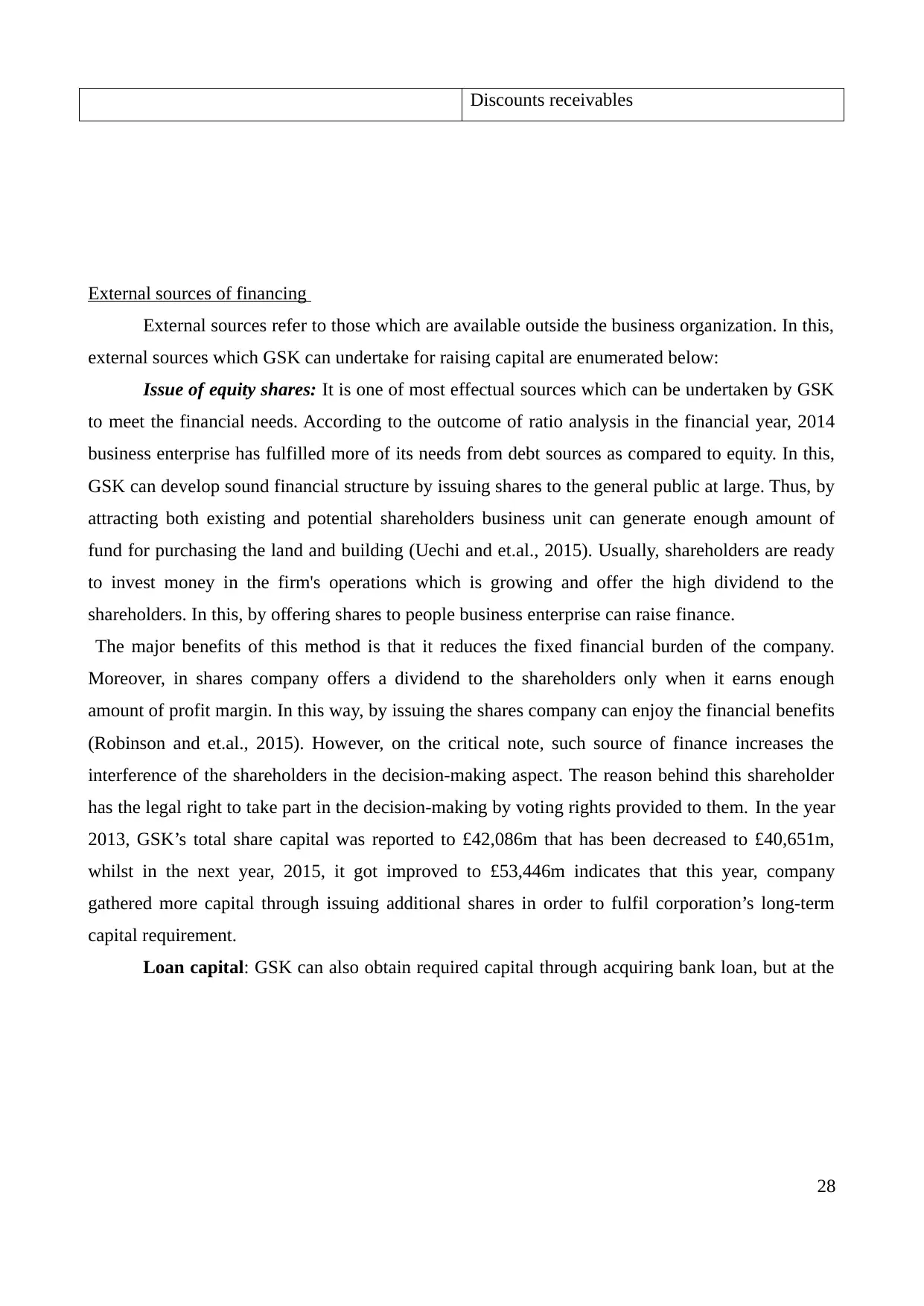
Discounts receivables
External sources of financing
External sources refer to those which are available outside the business organization. In this,
external sources which GSK can undertake for raising capital are enumerated below:
Issue of equity shares: It is one of most effectual sources which can be undertaken by GSK
to meet the financial needs. According to the outcome of ratio analysis in the financial year, 2014
business enterprise has fulfilled more of its needs from debt sources as compared to equity. In this,
GSK can develop sound financial structure by issuing shares to the general public at large. Thus, by
attracting both existing and potential shareholders business unit can generate enough amount of
fund for purchasing the land and building (Uechi and et.al., 2015). Usually, shareholders are ready
to invest money in the firm's operations which is growing and offer the high dividend to the
shareholders. In this, by offering shares to people business enterprise can raise finance.
The major benefits of this method is that it reduces the fixed financial burden of the company.
Moreover, in shares company offers a dividend to the shareholders only when it earns enough
amount of profit margin. In this way, by issuing the shares company can enjoy the financial benefits
(Robinson and et.al., 2015). However, on the critical note, such source of finance increases the
interference of the shareholders in the decision-making aspect. The reason behind this shareholder
has the legal right to take part in the decision-making by voting rights provided to them. In the year
2013, GSK’s total share capital was reported to £42,086m that has been decreased to £40,651m,
whilst in the next year, 2015, it got improved to £53,446m indicates that this year, company
gathered more capital through issuing additional shares in order to fulfil corporation’s long-term
capital requirement.
Loan capital: GSK can also obtain required capital through acquiring bank loan, but at the
28
External sources of financing
External sources refer to those which are available outside the business organization. In this,
external sources which GSK can undertake for raising capital are enumerated below:
Issue of equity shares: It is one of most effectual sources which can be undertaken by GSK
to meet the financial needs. According to the outcome of ratio analysis in the financial year, 2014
business enterprise has fulfilled more of its needs from debt sources as compared to equity. In this,
GSK can develop sound financial structure by issuing shares to the general public at large. Thus, by
attracting both existing and potential shareholders business unit can generate enough amount of
fund for purchasing the land and building (Uechi and et.al., 2015). Usually, shareholders are ready
to invest money in the firm's operations which is growing and offer the high dividend to the
shareholders. In this, by offering shares to people business enterprise can raise finance.
The major benefits of this method is that it reduces the fixed financial burden of the company.
Moreover, in shares company offers a dividend to the shareholders only when it earns enough
amount of profit margin. In this way, by issuing the shares company can enjoy the financial benefits
(Robinson and et.al., 2015). However, on the critical note, such source of finance increases the
interference of the shareholders in the decision-making aspect. The reason behind this shareholder
has the legal right to take part in the decision-making by voting rights provided to them. In the year
2013, GSK’s total share capital was reported to £42,086m that has been decreased to £40,651m,
whilst in the next year, 2015, it got improved to £53,446m indicates that this year, company
gathered more capital through issuing additional shares in order to fulfil corporation’s long-term
capital requirement.
Loan capital: GSK can also obtain required capital through acquiring bank loan, but at the
28
Secure Best Marks with AI Grader
Need help grading? Try our AI Grader for instant feedback on your assignments.
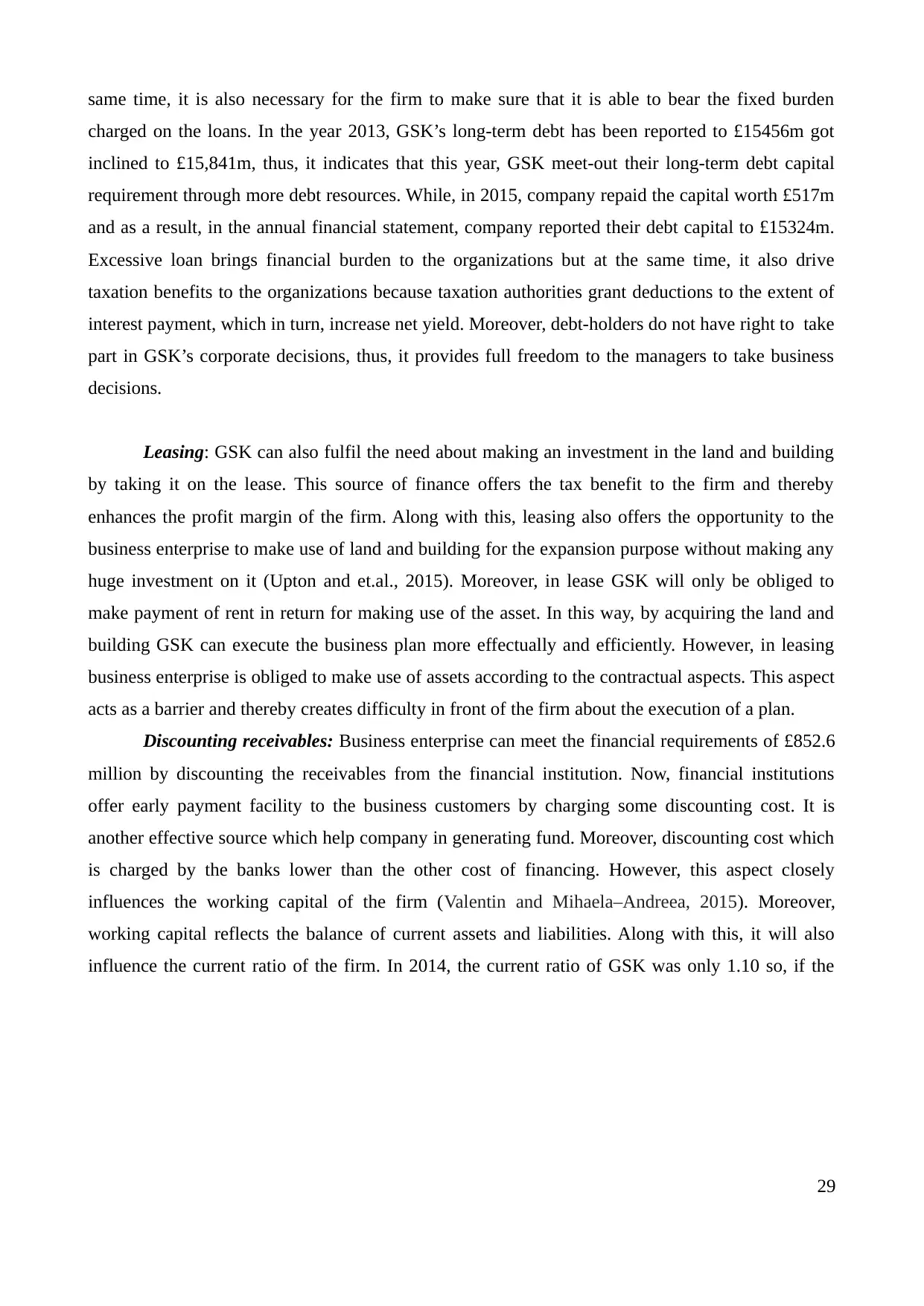
same time, it is also necessary for the firm to make sure that it is able to bear the fixed burden
charged on the loans. In the year 2013, GSK’s long-term debt has been reported to £15456m got
inclined to £15,841m, thus, it indicates that this year, GSK meet-out their long-term debt capital
requirement through more debt resources. While, in 2015, company repaid the capital worth £517m
and as a result, in the annual financial statement, company reported their debt capital to £15324m.
Excessive loan brings financial burden to the organizations but at the same time, it also drive
taxation benefits to the organizations because taxation authorities grant deductions to the extent of
interest payment, which in turn, increase net yield. Moreover, debt-holders do not have right to take
part in GSK’s corporate decisions, thus, it provides full freedom to the managers to take business
decisions.
Leasing: GSK can also fulfil the need about making an investment in the land and building
by taking it on the lease. This source of finance offers the tax benefit to the firm and thereby
enhances the profit margin of the firm. Along with this, leasing also offers the opportunity to the
business enterprise to make use of land and building for the expansion purpose without making any
huge investment on it (Upton and et.al., 2015). Moreover, in lease GSK will only be obliged to
make payment of rent in return for making use of the asset. In this way, by acquiring the land and
building GSK can execute the business plan more effectually and efficiently. However, in leasing
business enterprise is obliged to make use of assets according to the contractual aspects. This aspect
acts as a barrier and thereby creates difficulty in front of the firm about the execution of a plan.
Discounting receivables: Business enterprise can meet the financial requirements of £852.6
million by discounting the receivables from the financial institution. Now, financial institutions
offer early payment facility to the business customers by charging some discounting cost. It is
another effective source which help company in generating fund. Moreover, discounting cost which
is charged by the banks lower than the other cost of financing. However, this aspect closely
influences the working capital of the firm (Valentin and Mihaela–Andreea, 2015). Moreover,
working capital reflects the balance of current assets and liabilities. Along with this, it will also
influence the current ratio of the firm. In 2014, the current ratio of GSK was only 1.10 so, if the
29
charged on the loans. In the year 2013, GSK’s long-term debt has been reported to £15456m got
inclined to £15,841m, thus, it indicates that this year, GSK meet-out their long-term debt capital
requirement through more debt resources. While, in 2015, company repaid the capital worth £517m
and as a result, in the annual financial statement, company reported their debt capital to £15324m.
Excessive loan brings financial burden to the organizations but at the same time, it also drive
taxation benefits to the organizations because taxation authorities grant deductions to the extent of
interest payment, which in turn, increase net yield. Moreover, debt-holders do not have right to take
part in GSK’s corporate decisions, thus, it provides full freedom to the managers to take business
decisions.
Leasing: GSK can also fulfil the need about making an investment in the land and building
by taking it on the lease. This source of finance offers the tax benefit to the firm and thereby
enhances the profit margin of the firm. Along with this, leasing also offers the opportunity to the
business enterprise to make use of land and building for the expansion purpose without making any
huge investment on it (Upton and et.al., 2015). Moreover, in lease GSK will only be obliged to
make payment of rent in return for making use of the asset. In this way, by acquiring the land and
building GSK can execute the business plan more effectually and efficiently. However, in leasing
business enterprise is obliged to make use of assets according to the contractual aspects. This aspect
acts as a barrier and thereby creates difficulty in front of the firm about the execution of a plan.
Discounting receivables: Business enterprise can meet the financial requirements of £852.6
million by discounting the receivables from the financial institution. Now, financial institutions
offer early payment facility to the business customers by charging some discounting cost. It is
another effective source which help company in generating fund. Moreover, discounting cost which
is charged by the banks lower than the other cost of financing. However, this aspect closely
influences the working capital of the firm (Valentin and Mihaela–Andreea, 2015). Moreover,
working capital reflects the balance of current assets and liabilities. Along with this, it will also
influence the current ratio of the firm. In 2014, the current ratio of GSK was only 1.10 so, if the
29

business unit will discount receivables, then it closely influences such financial aspect. Moreover,
investors make an evaluation of such ratio to determine the company's ability about the fulfilling of
current obligations.
Conclusion
Hence, by considering the benefits and drawbacks of all the above mentioned external
sources it has been identified that GSK should issue shares. This in turn helps company in getting
two benefits such as proper balance in the financial structure as well as a reduction in the fixed
periodical burden (Karger, Oh and Shah, 2014). Moreover, at present, the debt-equity ratio of the
firm is very far from the ideal ratio. By doing financial statement analysis, it has been assessed that
debt-equity ratio of GSK was 2.21 and 3.72 times in the year of 2013 & 2014 respectively. The
ideal debt-equity ratio level must be 0.5:1. It shows that the company’s financial structure is very far
from standard ratio. By keeping such aspect in mind, it can be said that by issuing shares the
optimal monetary structure can be built and maintained by GSK. Thus, the company has
opportunity to make improvement in the solvency position to the large extent. Along with this, the
company can control the financial expense regarding interest. Moreover, in the case of shares,
business entity offers dividend only when enough amount of profit is earned. Hence, referring all
such aspects option of share issuance should be chosen by GSK. Thus, by issuing 85,260,000 shares
@ face value of £10 each GSK would become able to fulfil its monetary requirements to a great
extent. By doing assessment of financial statement it has been identified that dividend provided by
GSK during the period 2013 and 2014 accounts for 1.56 & 1.60 GBP million. It shows that
company is offering dividend with increasing rate. This in turn enhances investor’s confidence and
encourages them to invest more money in business operations of GSK. In addition to this, annual
report of GSK clearly presents that business unit lays emphasis on issuing additional equity. Thus,
by taking into account such aspect it can be said that future investment strategies can easily be
executed by GSK through issuance of shares.
30
investors make an evaluation of such ratio to determine the company's ability about the fulfilling of
current obligations.
Conclusion
Hence, by considering the benefits and drawbacks of all the above mentioned external
sources it has been identified that GSK should issue shares. This in turn helps company in getting
two benefits such as proper balance in the financial structure as well as a reduction in the fixed
periodical burden (Karger, Oh and Shah, 2014). Moreover, at present, the debt-equity ratio of the
firm is very far from the ideal ratio. By doing financial statement analysis, it has been assessed that
debt-equity ratio of GSK was 2.21 and 3.72 times in the year of 2013 & 2014 respectively. The
ideal debt-equity ratio level must be 0.5:1. It shows that the company’s financial structure is very far
from standard ratio. By keeping such aspect in mind, it can be said that by issuing shares the
optimal monetary structure can be built and maintained by GSK. Thus, the company has
opportunity to make improvement in the solvency position to the large extent. Along with this, the
company can control the financial expense regarding interest. Moreover, in the case of shares,
business entity offers dividend only when enough amount of profit is earned. Hence, referring all
such aspects option of share issuance should be chosen by GSK. Thus, by issuing 85,260,000 shares
@ face value of £10 each GSK would become able to fulfil its monetary requirements to a great
extent. By doing assessment of financial statement it has been identified that dividend provided by
GSK during the period 2013 and 2014 accounts for 1.56 & 1.60 GBP million. It shows that
company is offering dividend with increasing rate. This in turn enhances investor’s confidence and
encourages them to invest more money in business operations of GSK. In addition to this, annual
report of GSK clearly presents that business unit lays emphasis on issuing additional equity. Thus,
by taking into account such aspect it can be said that future investment strategies can easily be
executed by GSK through issuance of shares.
30
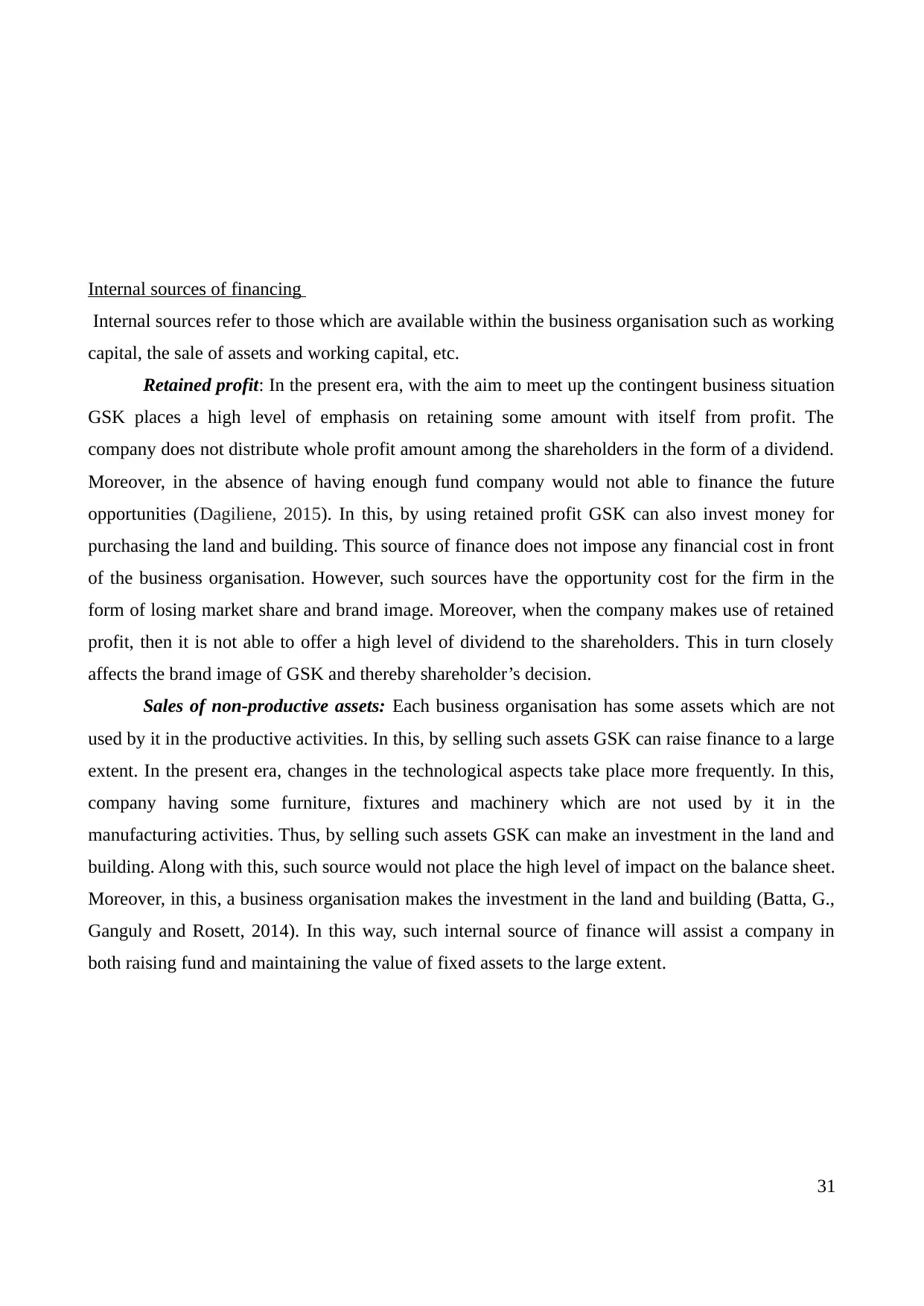
Internal sources of financing
Internal sources refer to those which are available within the business organisation such as working
capital, the sale of assets and working capital, etc.
Retained profit: In the present era, with the aim to meet up the contingent business situation
GSK places a high level of emphasis on retaining some amount with itself from profit. The
company does not distribute whole profit amount among the shareholders in the form of a dividend.
Moreover, in the absence of having enough fund company would not able to finance the future
opportunities (Dagiliene, 2015). In this, by using retained profit GSK can also invest money for
purchasing the land and building. This source of finance does not impose any financial cost in front
of the business organisation. However, such sources have the opportunity cost for the firm in the
form of losing market share and brand image. Moreover, when the company makes use of retained
profit, then it is not able to offer a high level of dividend to the shareholders. This in turn closely
affects the brand image of GSK and thereby shareholder’s decision.
Sales of non-productive assets: Each business organisation has some assets which are not
used by it in the productive activities. In this, by selling such assets GSK can raise finance to a large
extent. In the present era, changes in the technological aspects take place more frequently. In this,
company having some furniture, fixtures and machinery which are not used by it in the
manufacturing activities. Thus, by selling such assets GSK can make an investment in the land and
building. Along with this, such source would not place the high level of impact on the balance sheet.
Moreover, in this, a business organisation makes the investment in the land and building (Batta, G.,
Ganguly and Rosett, 2014). In this way, such internal source of finance will assist a company in
both raising fund and maintaining the value of fixed assets to the large extent.
31
Internal sources refer to those which are available within the business organisation such as working
capital, the sale of assets and working capital, etc.
Retained profit: In the present era, with the aim to meet up the contingent business situation
GSK places a high level of emphasis on retaining some amount with itself from profit. The
company does not distribute whole profit amount among the shareholders in the form of a dividend.
Moreover, in the absence of having enough fund company would not able to finance the future
opportunities (Dagiliene, 2015). In this, by using retained profit GSK can also invest money for
purchasing the land and building. This source of finance does not impose any financial cost in front
of the business organisation. However, such sources have the opportunity cost for the firm in the
form of losing market share and brand image. Moreover, when the company makes use of retained
profit, then it is not able to offer a high level of dividend to the shareholders. This in turn closely
affects the brand image of GSK and thereby shareholder’s decision.
Sales of non-productive assets: Each business organisation has some assets which are not
used by it in the productive activities. In this, by selling such assets GSK can raise finance to a large
extent. In the present era, changes in the technological aspects take place more frequently. In this,
company having some furniture, fixtures and machinery which are not used by it in the
manufacturing activities. Thus, by selling such assets GSK can make an investment in the land and
building. Along with this, such source would not place the high level of impact on the balance sheet.
Moreover, in this, a business organisation makes the investment in the land and building (Batta, G.,
Ganguly and Rosett, 2014). In this way, such internal source of finance will assist a company in
both raising fund and maintaining the value of fixed assets to the large extent.
31
Paraphrase This Document
Need a fresh take? Get an instant paraphrase of this document with our AI Paraphraser
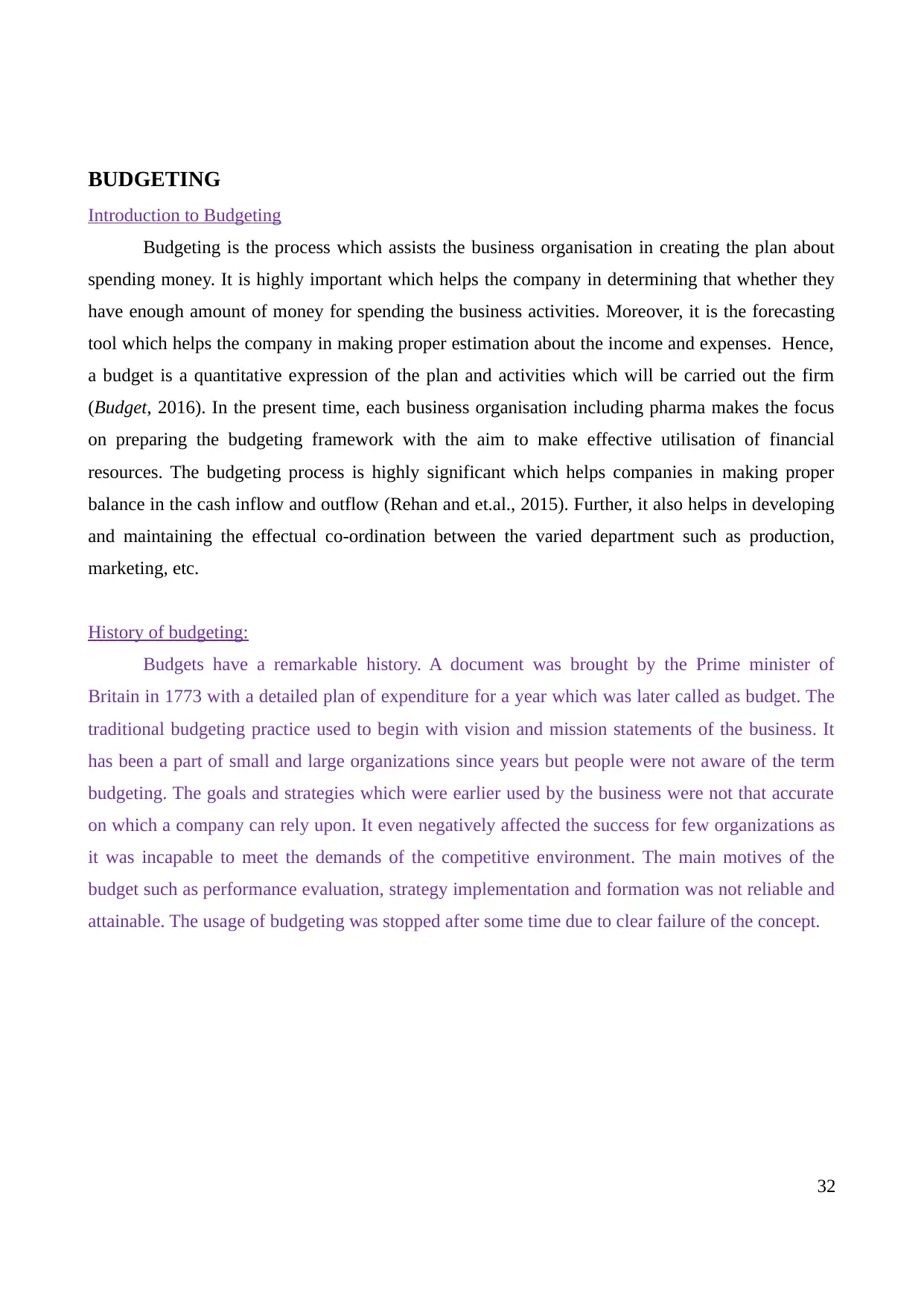
BUDGETING
Introduction to Budgeting
Budgeting is the process which assists the business organisation in creating the plan about
spending money. It is highly important which helps the company in determining that whether they
have enough amount of money for spending the business activities. Moreover, it is the forecasting
tool which helps the company in making proper estimation about the income and expenses. Hence,
a budget is a quantitative expression of the plan and activities which will be carried out the firm
(Budget, 2016). In the present time, each business organisation including pharma makes the focus
on preparing the budgeting framework with the aim to make effective utilisation of financial
resources. The budgeting process is highly significant which helps companies in making proper
balance in the cash inflow and outflow (Rehan and et.al., 2015). Further, it also helps in developing
and maintaining the effectual co-ordination between the varied department such as production,
marketing, etc.
History of budgeting:
Budgets have a remarkable history. A document was brought by the Prime minister of
Britain in 1773 with a detailed plan of expenditure for a year which was later called as budget. The
traditional budgeting practice used to begin with vision and mission statements of the business. It
has been a part of small and large organizations since years but people were not aware of the term
budgeting. The goals and strategies which were earlier used by the business were not that accurate
on which a company can rely upon. It even negatively affected the success for few organizations as
it was incapable to meet the demands of the competitive environment. The main motives of the
budget such as performance evaluation, strategy implementation and formation was not reliable and
attainable. The usage of budgeting was stopped after some time due to clear failure of the concept.
32
Introduction to Budgeting
Budgeting is the process which assists the business organisation in creating the plan about
spending money. It is highly important which helps the company in determining that whether they
have enough amount of money for spending the business activities. Moreover, it is the forecasting
tool which helps the company in making proper estimation about the income and expenses. Hence,
a budget is a quantitative expression of the plan and activities which will be carried out the firm
(Budget, 2016). In the present time, each business organisation including pharma makes the focus
on preparing the budgeting framework with the aim to make effective utilisation of financial
resources. The budgeting process is highly significant which helps companies in making proper
balance in the cash inflow and outflow (Rehan and et.al., 2015). Further, it also helps in developing
and maintaining the effectual co-ordination between the varied department such as production,
marketing, etc.
History of budgeting:
Budgets have a remarkable history. A document was brought by the Prime minister of
Britain in 1773 with a detailed plan of expenditure for a year which was later called as budget. The
traditional budgeting practice used to begin with vision and mission statements of the business. It
has been a part of small and large organizations since years but people were not aware of the term
budgeting. The goals and strategies which were earlier used by the business were not that accurate
on which a company can rely upon. It even negatively affected the success for few organizations as
it was incapable to meet the demands of the competitive environment. The main motives of the
budget such as performance evaluation, strategy implementation and formation was not reliable and
attainable. The usage of budgeting was stopped after some time due to clear failure of the concept.
32

Critical Analysis of Strengths and Weaknesses of Current Budget Process
Budgeting technique has some advantages and disadvantages which are enumerated below:
Purpose Optimum use of financial resources
Making control on expenses
Necessity Better allocation of resources
Providing guidance to the personnel
about spending money
Meeting contingent situation more
effectively and efficiently
Advantages The financial framework in the form of
budget offers the opportunity to the firm
to make an early evaluation of the
difficulties which will arise shortly
(Gaskill, Van Auken and Kim, 2015). In
this, it would enable the manager to take
effectual measure within the suitable
time frame.
Along with this, the budget also guides
the personnel at each about the fund
which they need to spend in varied tasks.
Budgeting framework also enables the
company to measure the performance
level of each department and thereby
make control on it. Hence, by making a
comparison of the actual performance
with the standard aspects companies can
assess the deviations that take place in
the financial aspects (Advantages of
33
Budgeting technique has some advantages and disadvantages which are enumerated below:
Purpose Optimum use of financial resources
Making control on expenses
Necessity Better allocation of resources
Providing guidance to the personnel
about spending money
Meeting contingent situation more
effectively and efficiently
Advantages The financial framework in the form of
budget offers the opportunity to the firm
to make an early evaluation of the
difficulties which will arise shortly
(Gaskill, Van Auken and Kim, 2015). In
this, it would enable the manager to take
effectual measure within the suitable
time frame.
Along with this, the budget also guides
the personnel at each about the fund
which they need to spend in varied tasks.
Budgeting framework also enables the
company to measure the performance
level of each department and thereby
make control on it. Hence, by making a
comparison of the actual performance
with the standard aspects companies can
assess the deviations that take place in
the financial aspects (Advantages of
33

Budgeting, 2016). In this way, by taking
strategic action within the suitable time
frame business organisation can enhance
its financial performance and aspects to a
large extent.
Disadvantages In the dynamic business environment, it
is highly difficult for the manager to
make a proper estimation of the cost of
material and other aspects (Hung and
Subramanyam, 2007). In this, if manager
undertakes such framework for the
performance evaluation then it may
result in the low level of employee
motivation and morale. Moreover, the
occurrence of higher deviation
negatively affects the satisfaction level of
customers.
In addition to this, if finance manager of
the company fails to undertake the
factors such as inflation, technological
advancement, changing customer needs,
etc. then it may result into the unrealistic
financial framework.
Best practices for budgeting process Preparation of plan chart
Making use of software
Hence, timeline, objectives, resources, KPI’s, risk and challenges are the main five elements
which business organization needs to keep in mind while preparing the budgeting framework.
Along with this, there are several budgeting methods which can be used by the business
34
strategic action within the suitable time
frame business organisation can enhance
its financial performance and aspects to a
large extent.
Disadvantages In the dynamic business environment, it
is highly difficult for the manager to
make a proper estimation of the cost of
material and other aspects (Hung and
Subramanyam, 2007). In this, if manager
undertakes such framework for the
performance evaluation then it may
result in the low level of employee
motivation and morale. Moreover, the
occurrence of higher deviation
negatively affects the satisfaction level of
customers.
In addition to this, if finance manager of
the company fails to undertake the
factors such as inflation, technological
advancement, changing customer needs,
etc. then it may result into the unrealistic
financial framework.
Best practices for budgeting process Preparation of plan chart
Making use of software
Hence, timeline, objectives, resources, KPI’s, risk and challenges are the main five elements
which business organization needs to keep in mind while preparing the budgeting framework.
Along with this, there are several budgeting methods which can be used by the business
34
Secure Best Marks with AI Grader
Need help grading? Try our AI Grader for instant feedback on your assignments.
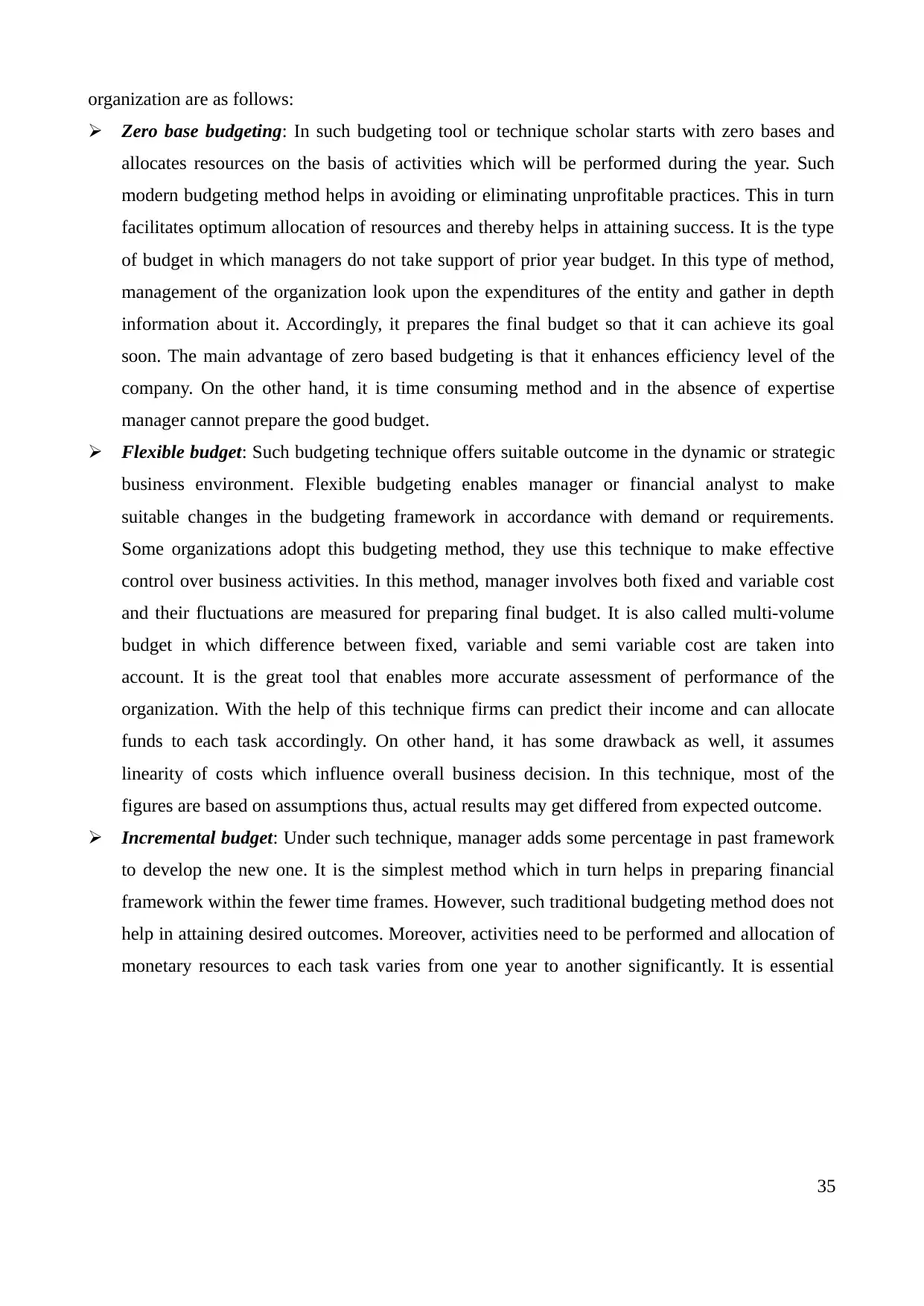
organization are as follows:
Zero base budgeting: In such budgeting tool or technique scholar starts with zero bases and
allocates resources on the basis of activities which will be performed during the year. Such
modern budgeting method helps in avoiding or eliminating unprofitable practices. This in turn
facilitates optimum allocation of resources and thereby helps in attaining success. It is the type
of budget in which managers do not take support of prior year budget. In this type of method,
management of the organization look upon the expenditures of the entity and gather in depth
information about it. Accordingly, it prepares the final budget so that it can achieve its goal
soon. The main advantage of zero based budgeting is that it enhances efficiency level of the
company. On the other hand, it is time consuming method and in the absence of expertise
manager cannot prepare the good budget.
Flexible budget: Such budgeting technique offers suitable outcome in the dynamic or strategic
business environment. Flexible budgeting enables manager or financial analyst to make
suitable changes in the budgeting framework in accordance with demand or requirements.
Some organizations adopt this budgeting method, they use this technique to make effective
control over business activities. In this method, manager involves both fixed and variable cost
and their fluctuations are measured for preparing final budget. It is also called multi-volume
budget in which difference between fixed, variable and semi variable cost are taken into
account. It is the great tool that enables more accurate assessment of performance of the
organization. With the help of this technique firms can predict their income and can allocate
funds to each task accordingly. On other hand, it has some drawback as well, it assumes
linearity of costs which influence overall business decision. In this technique, most of the
figures are based on assumptions thus, actual results may get differed from expected outcome.
Incremental budget: Under such technique, manager adds some percentage in past framework
to develop the new one. It is the simplest method which in turn helps in preparing financial
framework within the fewer time frames. However, such traditional budgeting method does not
help in attaining desired outcomes. Moreover, activities need to be performed and allocation of
monetary resources to each task varies from one year to another significantly. It is essential
35
Zero base budgeting: In such budgeting tool or technique scholar starts with zero bases and
allocates resources on the basis of activities which will be performed during the year. Such
modern budgeting method helps in avoiding or eliminating unprofitable practices. This in turn
facilitates optimum allocation of resources and thereby helps in attaining success. It is the type
of budget in which managers do not take support of prior year budget. In this type of method,
management of the organization look upon the expenditures of the entity and gather in depth
information about it. Accordingly, it prepares the final budget so that it can achieve its goal
soon. The main advantage of zero based budgeting is that it enhances efficiency level of the
company. On the other hand, it is time consuming method and in the absence of expertise
manager cannot prepare the good budget.
Flexible budget: Such budgeting technique offers suitable outcome in the dynamic or strategic
business environment. Flexible budgeting enables manager or financial analyst to make
suitable changes in the budgeting framework in accordance with demand or requirements.
Some organizations adopt this budgeting method, they use this technique to make effective
control over business activities. In this method, manager involves both fixed and variable cost
and their fluctuations are measured for preparing final budget. It is also called multi-volume
budget in which difference between fixed, variable and semi variable cost are taken into
account. It is the great tool that enables more accurate assessment of performance of the
organization. With the help of this technique firms can predict their income and can allocate
funds to each task accordingly. On other hand, it has some drawback as well, it assumes
linearity of costs which influence overall business decision. In this technique, most of the
figures are based on assumptions thus, actual results may get differed from expected outcome.
Incremental budget: Under such technique, manager adds some percentage in past framework
to develop the new one. It is the simplest method which in turn helps in preparing financial
framework within the fewer time frames. However, such traditional budgeting method does not
help in attaining desired outcomes. Moreover, activities need to be performed and allocation of
monetary resources to each task varies from one year to another significantly. It is essential
35
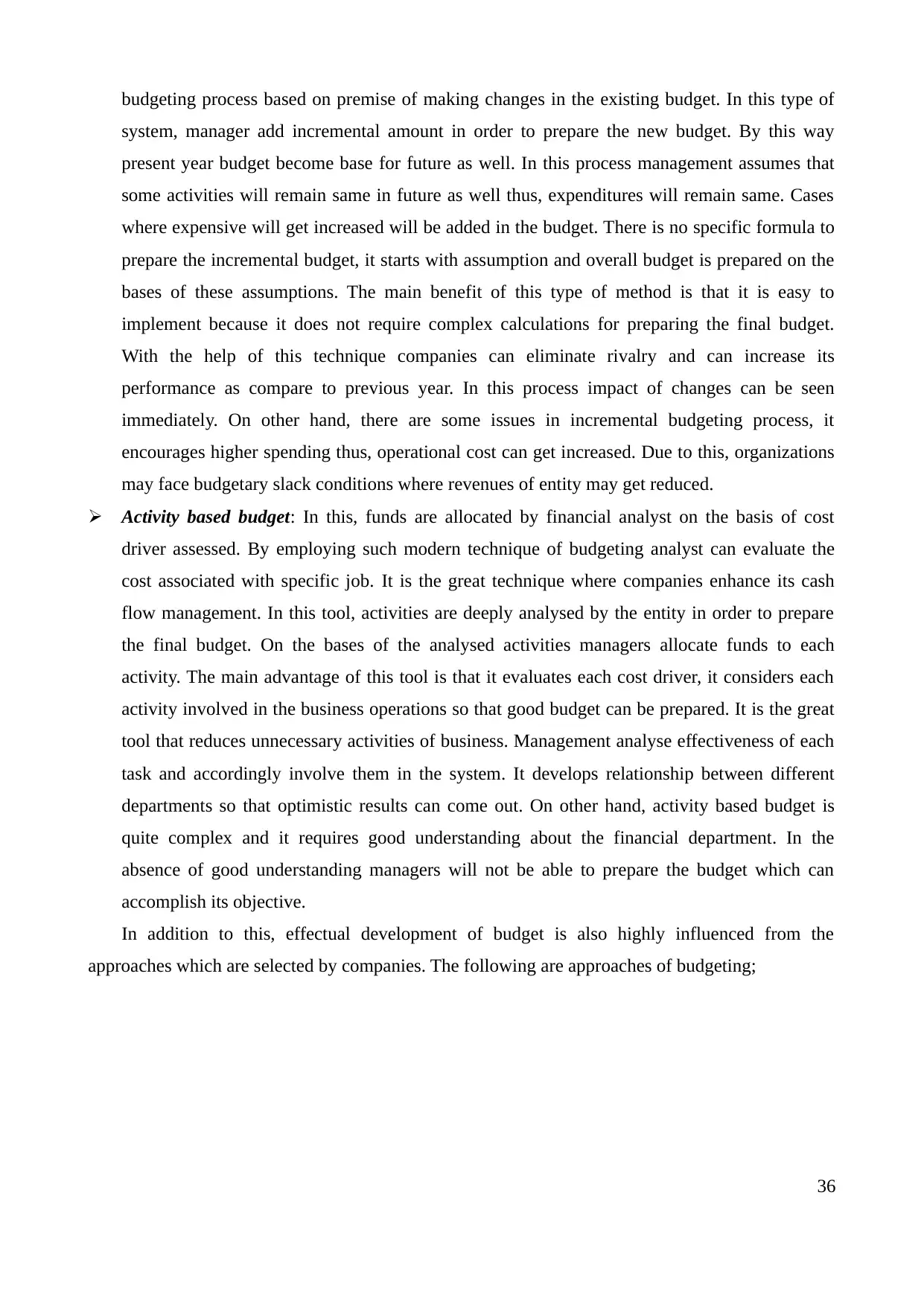
budgeting process based on premise of making changes in the existing budget. In this type of
system, manager add incremental amount in order to prepare the new budget. By this way
present year budget become base for future as well. In this process management assumes that
some activities will remain same in future as well thus, expenditures will remain same. Cases
where expensive will get increased will be added in the budget. There is no specific formula to
prepare the incremental budget, it starts with assumption and overall budget is prepared on the
bases of these assumptions. The main benefit of this type of method is that it is easy to
implement because it does not require complex calculations for preparing the final budget.
With the help of this technique companies can eliminate rivalry and can increase its
performance as compare to previous year. In this process impact of changes can be seen
immediately. On other hand, there are some issues in incremental budgeting process, it
encourages higher spending thus, operational cost can get increased. Due to this, organizations
may face budgetary slack conditions where revenues of entity may get reduced.
Activity based budget: In this, funds are allocated by financial analyst on the basis of cost
driver assessed. By employing such modern technique of budgeting analyst can evaluate the
cost associated with specific job. It is the great technique where companies enhance its cash
flow management. In this tool, activities are deeply analysed by the entity in order to prepare
the final budget. On the bases of the analysed activities managers allocate funds to each
activity. The main advantage of this tool is that it evaluates each cost driver, it considers each
activity involved in the business operations so that good budget can be prepared. It is the great
tool that reduces unnecessary activities of business. Management analyse effectiveness of each
task and accordingly involve them in the system. It develops relationship between different
departments so that optimistic results can come out. On other hand, activity based budget is
quite complex and it requires good understanding about the financial department. In the
absence of good understanding managers will not be able to prepare the budget which can
accomplish its objective.
In addition to this, effectual development of budget is also highly influenced from the
approaches which are selected by companies. The following are approaches of budgeting;
36
system, manager add incremental amount in order to prepare the new budget. By this way
present year budget become base for future as well. In this process management assumes that
some activities will remain same in future as well thus, expenditures will remain same. Cases
where expensive will get increased will be added in the budget. There is no specific formula to
prepare the incremental budget, it starts with assumption and overall budget is prepared on the
bases of these assumptions. The main benefit of this type of method is that it is easy to
implement because it does not require complex calculations for preparing the final budget.
With the help of this technique companies can eliminate rivalry and can increase its
performance as compare to previous year. In this process impact of changes can be seen
immediately. On other hand, there are some issues in incremental budgeting process, it
encourages higher spending thus, operational cost can get increased. Due to this, organizations
may face budgetary slack conditions where revenues of entity may get reduced.
Activity based budget: In this, funds are allocated by financial analyst on the basis of cost
driver assessed. By employing such modern technique of budgeting analyst can evaluate the
cost associated with specific job. It is the great technique where companies enhance its cash
flow management. In this tool, activities are deeply analysed by the entity in order to prepare
the final budget. On the bases of the analysed activities managers allocate funds to each
activity. The main advantage of this tool is that it evaluates each cost driver, it considers each
activity involved in the business operations so that good budget can be prepared. It is the great
tool that reduces unnecessary activities of business. Management analyse effectiveness of each
task and accordingly involve them in the system. It develops relationship between different
departments so that optimistic results can come out. On other hand, activity based budget is
quite complex and it requires good understanding about the financial department. In the
absence of good understanding managers will not be able to prepare the budget which can
accomplish its objective.
In addition to this, effectual development of budget is also highly influenced from the
approaches which are selected by companies. The following are approaches of budgeting;
36
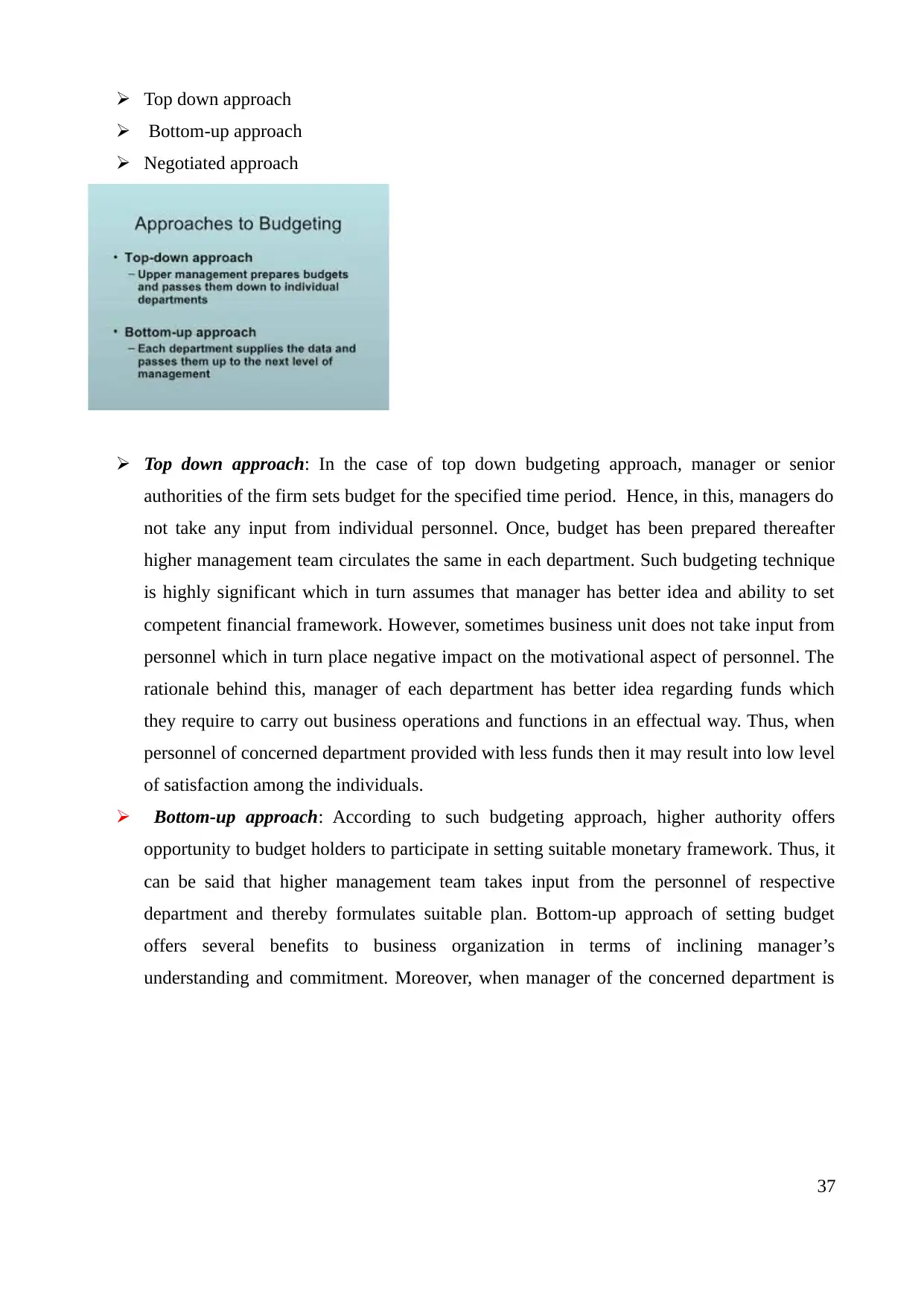
Top down approach
Bottom-up approach
Negotiated approach
Top down approach: In the case of top down budgeting approach, manager or senior
authorities of the firm sets budget for the specified time period. Hence, in this, managers do
not take any input from individual personnel. Once, budget has been prepared thereafter
higher management team circulates the same in each department. Such budgeting technique
is highly significant which in turn assumes that manager has better idea and ability to set
competent financial framework. However, sometimes business unit does not take input from
personnel which in turn place negative impact on the motivational aspect of personnel. The
rationale behind this, manager of each department has better idea regarding funds which
they require to carry out business operations and functions in an effectual way. Thus, when
personnel of concerned department provided with less funds then it may result into low level
of satisfaction among the individuals.
Bottom-up approach: According to such budgeting approach, higher authority offers
opportunity to budget holders to participate in setting suitable monetary framework. Thus, it
can be said that higher management team takes input from the personnel of respective
department and thereby formulates suitable plan. Bottom-up approach of setting budget
offers several benefits to business organization in terms of inclining manager’s
understanding and commitment. Moreover, when manager of the concerned department is
37
Bottom-up approach
Negotiated approach
Top down approach: In the case of top down budgeting approach, manager or senior
authorities of the firm sets budget for the specified time period. Hence, in this, managers do
not take any input from individual personnel. Once, budget has been prepared thereafter
higher management team circulates the same in each department. Such budgeting technique
is highly significant which in turn assumes that manager has better idea and ability to set
competent financial framework. However, sometimes business unit does not take input from
personnel which in turn place negative impact on the motivational aspect of personnel. The
rationale behind this, manager of each department has better idea regarding funds which
they require to carry out business operations and functions in an effectual way. Thus, when
personnel of concerned department provided with less funds then it may result into low level
of satisfaction among the individuals.
Bottom-up approach: According to such budgeting approach, higher authority offers
opportunity to budget holders to participate in setting suitable monetary framework. Thus, it
can be said that higher management team takes input from the personnel of respective
department and thereby formulates suitable plan. Bottom-up approach of setting budget
offers several benefits to business organization in terms of inclining manager’s
understanding and commitment. Moreover, when manager of the concerned department is
37
Paraphrase This Document
Need a fresh take? Get an instant paraphrase of this document with our AI Paraphraser

included in setting budget then it may result into increase in motivation aspect. In addition to
this, bottom-up approach facilitates better communication between departments and thereby
helps in making optimum use of funds. However, on the critical note it can be stated that
bottom-up approach may cause of budgetary slack. Thus, in such approach, manager sets
target that are easily achievable Further, it also enhances dysfunctional behaviour within the
firm.
Whether the budgeting process is still fit for purpose in the modern environment?
Being in a dynamic world and increasing speed of change, the estimates are difficult to be
applied. However, it is important to have an estimate of receipts and expenditure to act upon. The
companies use various tools and techniques in order to prepare an effective budget for the business.
There are various factors which affect the estimations some of them are political, economic, social,
technological, legal and environmental factors. Rationality and irrationality is difficult to be
determined and it increases the chances of personal gain also. Some conditions such as currencies,
oil prices, interest rates etc, keeps changing for the whole year, which makes it difficult to make
exact estimates. Even if the company is able to meet the budget estimation, it does not guarantee
whether the resources were efficiently utilised or not. Budget does not describe that whether it was
the actual success of the business or it was the market share of the competitor which came down.
There are various unforeseen circumstances that takes place in the environment which are not
considered while preparing the budget as the main assumption while preparing the budget is that the
environment will remain stable and will not change. The opportunity cost of different budget
forgone which cannot be adopted in the middle of the year. It is important to make the budget
considering all the factors otherwise it is difficult to meet the expectations of the budget.
As the environment changes, it can be difficult to continue with the same budget as it was
prepared in the beginning of the year, therefore, it is necessary to update the budget after every
major incident taking place in the marketplace that can affect the estimated amounts. Continuing the
same budget for the whole year can be difficult to follow and have major chances of failing to meet
the estimations at the end of the year. Budget may not fit in the modern environment as it is, but it
38
this, bottom-up approach facilitates better communication between departments and thereby
helps in making optimum use of funds. However, on the critical note it can be stated that
bottom-up approach may cause of budgetary slack. Thus, in such approach, manager sets
target that are easily achievable Further, it also enhances dysfunctional behaviour within the
firm.
Whether the budgeting process is still fit for purpose in the modern environment?
Being in a dynamic world and increasing speed of change, the estimates are difficult to be
applied. However, it is important to have an estimate of receipts and expenditure to act upon. The
companies use various tools and techniques in order to prepare an effective budget for the business.
There are various factors which affect the estimations some of them are political, economic, social,
technological, legal and environmental factors. Rationality and irrationality is difficult to be
determined and it increases the chances of personal gain also. Some conditions such as currencies,
oil prices, interest rates etc, keeps changing for the whole year, which makes it difficult to make
exact estimates. Even if the company is able to meet the budget estimation, it does not guarantee
whether the resources were efficiently utilised or not. Budget does not describe that whether it was
the actual success of the business or it was the market share of the competitor which came down.
There are various unforeseen circumstances that takes place in the environment which are not
considered while preparing the budget as the main assumption while preparing the budget is that the
environment will remain stable and will not change. The opportunity cost of different budget
forgone which cannot be adopted in the middle of the year. It is important to make the budget
considering all the factors otherwise it is difficult to meet the expectations of the budget.
As the environment changes, it can be difficult to continue with the same budget as it was
prepared in the beginning of the year, therefore, it is necessary to update the budget after every
major incident taking place in the marketplace that can affect the estimated amounts. Continuing the
same budget for the whole year can be difficult to follow and have major chances of failing to meet
the estimations at the end of the year. Budget may not fit in the modern environment as it is, but it
38
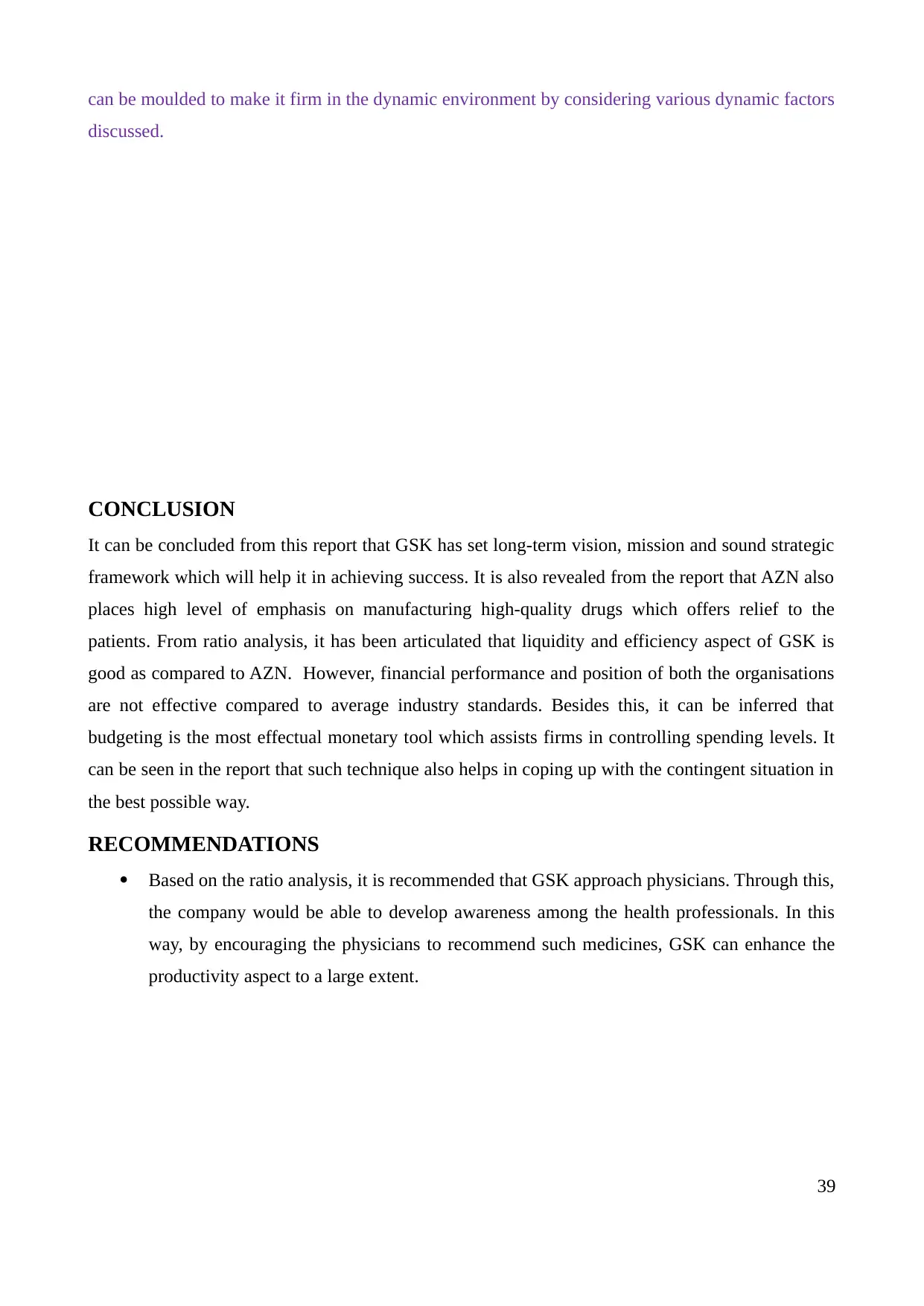
can be moulded to make it firm in the dynamic environment by considering various dynamic factors
discussed.
CONCLUSION
It can be concluded from this report that GSK has set long-term vision, mission and sound strategic
framework which will help it in achieving success. It is also revealed from the report that AZN also
places high level of emphasis on manufacturing high-quality drugs which offers relief to the
patients. From ratio analysis, it has been articulated that liquidity and efficiency aspect of GSK is
good as compared to AZN. However, financial performance and position of both the organisations
are not effective compared to average industry standards. Besides this, it can be inferred that
budgeting is the most effectual monetary tool which assists firms in controlling spending levels. It
can be seen in the report that such technique also helps in coping up with the contingent situation in
the best possible way.
RECOMMENDATIONS
Based on the ratio analysis, it is recommended that GSK approach physicians. Through this,
the company would be able to develop awareness among the health professionals. In this
way, by encouraging the physicians to recommend such medicines, GSK can enhance the
productivity aspect to a large extent.
39
discussed.
CONCLUSION
It can be concluded from this report that GSK has set long-term vision, mission and sound strategic
framework which will help it in achieving success. It is also revealed from the report that AZN also
places high level of emphasis on manufacturing high-quality drugs which offers relief to the
patients. From ratio analysis, it has been articulated that liquidity and efficiency aspect of GSK is
good as compared to AZN. However, financial performance and position of both the organisations
are not effective compared to average industry standards. Besides this, it can be inferred that
budgeting is the most effectual monetary tool which assists firms in controlling spending levels. It
can be seen in the report that such technique also helps in coping up with the contingent situation in
the best possible way.
RECOMMENDATIONS
Based on the ratio analysis, it is recommended that GSK approach physicians. Through this,
the company would be able to develop awareness among the health professionals. In this
way, by encouraging the physicians to recommend such medicines, GSK can enhance the
productivity aspect to a large extent.
39
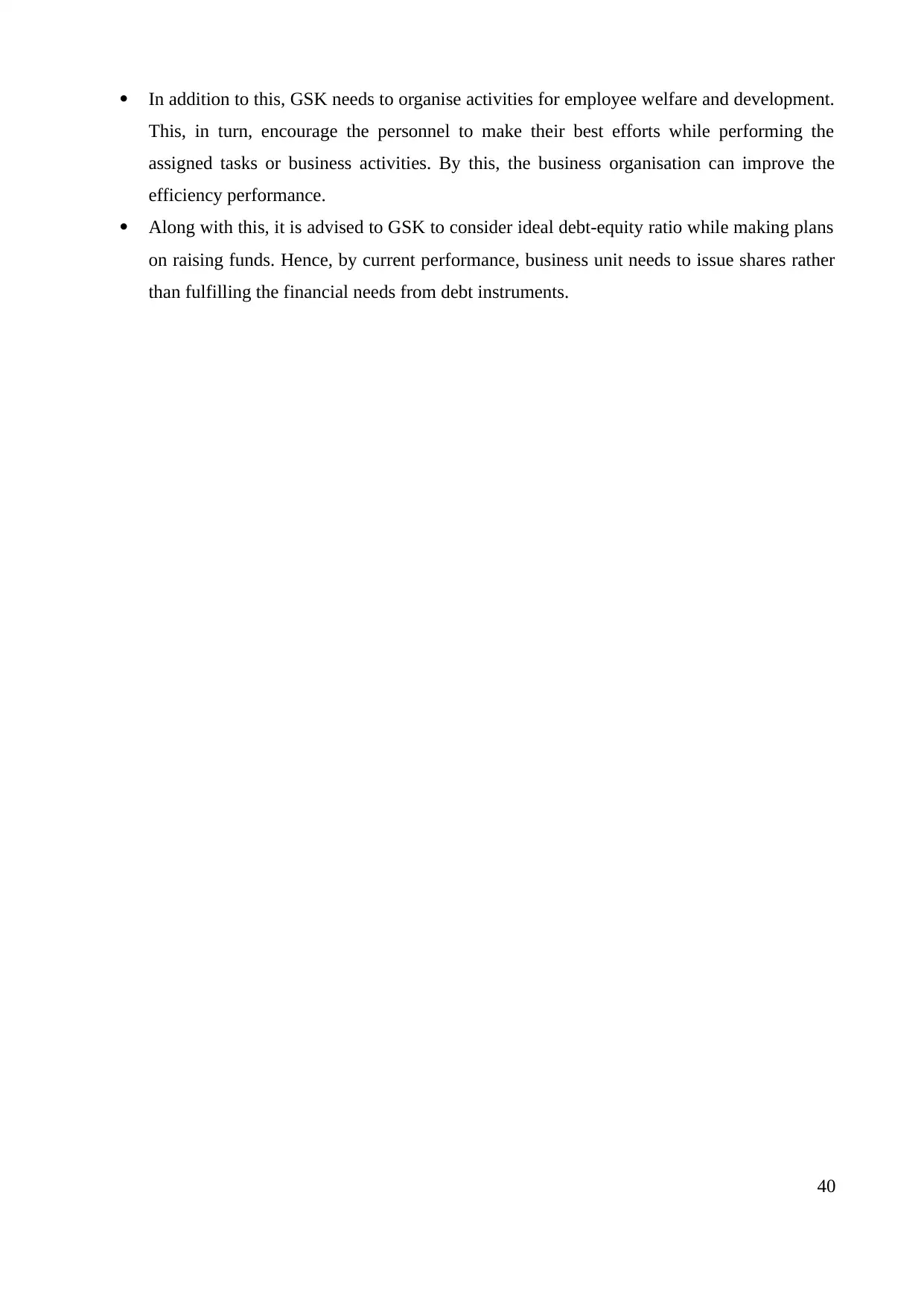
In addition to this, GSK needs to organise activities for employee welfare and development.
This, in turn, encourage the personnel to make their best efforts while performing the
assigned tasks or business activities. By this, the business organisation can improve the
efficiency performance.
Along with this, it is advised to GSK to consider ideal debt-equity ratio while making plans
on raising funds. Hence, by current performance, business unit needs to issue shares rather
than fulfilling the financial needs from debt instruments.
40
This, in turn, encourage the personnel to make their best efforts while performing the
assigned tasks or business activities. By this, the business organisation can improve the
efficiency performance.
Along with this, it is advised to GSK to consider ideal debt-equity ratio while making plans
on raising funds. Hence, by current performance, business unit needs to issue shares rather
than fulfilling the financial needs from debt instruments.
40
Secure Best Marks with AI Grader
Need help grading? Try our AI Grader for instant feedback on your assignments.
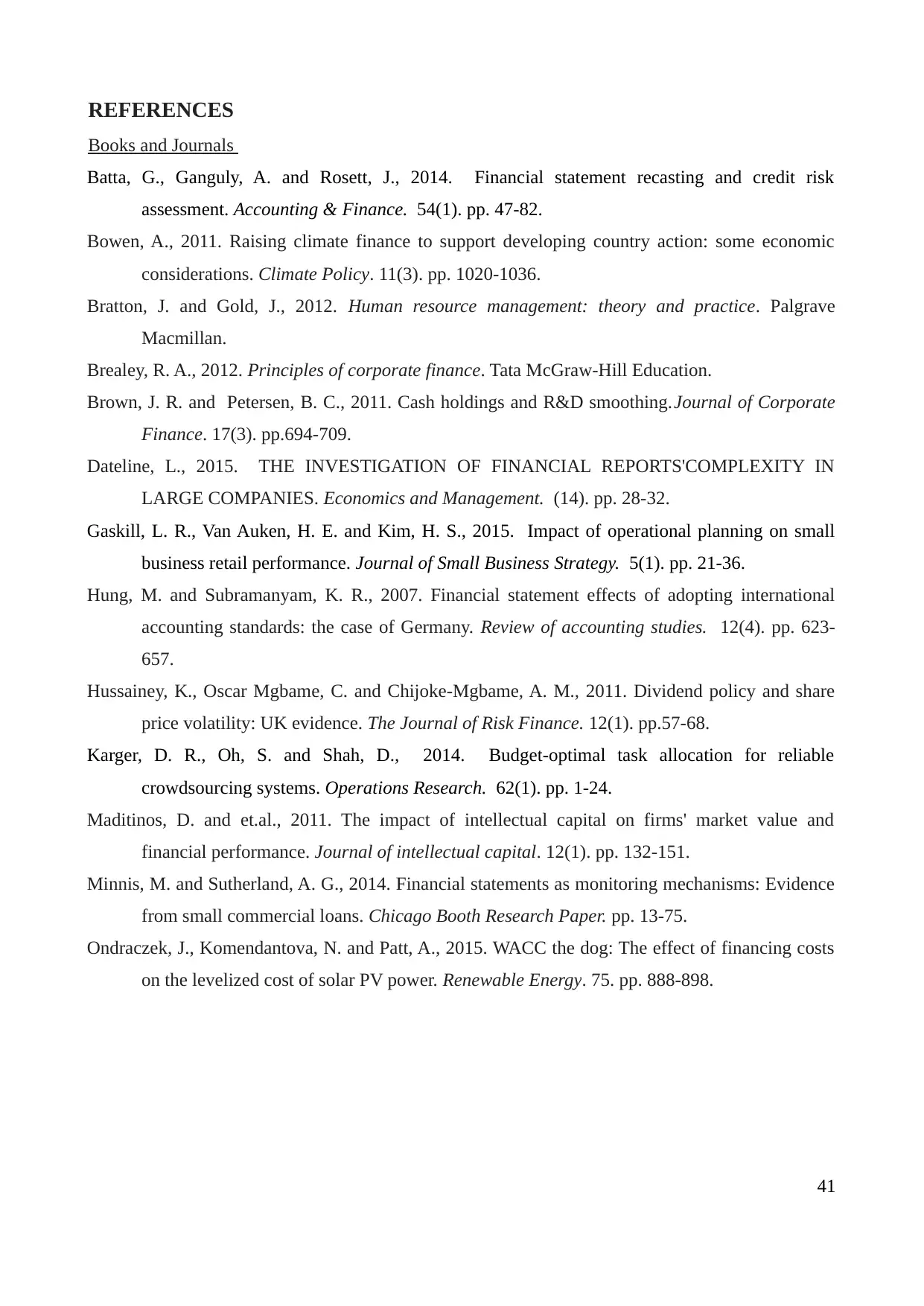
REFERENCES
Books and Journals
Batta, G., Ganguly, A. and Rosett, J., 2014. Financial statement recasting and credit risk
assessment. Accounting & Finance. 54(1). pp. 47-82.
Bowen, A., 2011. Raising climate finance to support developing country action: some economic
considerations. Climate Policy. 11(3). pp. 1020-1036.
Bratton, J. and Gold, J., 2012. Human resource management: theory and practice. Palgrave
Macmillan.
Brealey, R. A., 2012. Principles of corporate finance. Tata McGraw-Hill Education.
Brown, J. R. and Petersen, B. C., 2011. Cash holdings and R&D smoothing.Journal of Corporate
Finance. 17(3). pp.694-709.
Dateline, L., 2015. THE INVESTIGATION OF FINANCIAL REPORTS'COMPLEXITY IN
LARGE COMPANIES. Economics and Management. (14). pp. 28-32.
Gaskill, L. R., Van Auken, H. E. and Kim, H. S., 2015. Impact of operational planning on small
business retail performance. Journal of Small Business Strategy. 5(1). pp. 21-36.
Hung, M. and Subramanyam, K. R., 2007. Financial statement effects of adopting international
accounting standards: the case of Germany. Review of accounting studies. 12(4). pp. 623-
657.
Hussainey, K., Oscar Mgbame, C. and Chijoke-Mgbame, A. M., 2011. Dividend policy and share
price volatility: UK evidence. The Journal of Risk Finance. 12(1). pp.57-68.
Karger, D. R., Oh, S. and Shah, D., 2014. Budget-optimal task allocation for reliable
crowdsourcing systems. Operations Research. 62(1). pp. 1-24.
Maditinos, D. and et.al., 2011. The impact of intellectual capital on firms' market value and
financial performance. Journal of intellectual capital. 12(1). pp. 132-151.
Minnis, M. and Sutherland, A. G., 2014. Financial statements as monitoring mechanisms: Evidence
from small commercial loans. Chicago Booth Research Paper. pp. 13-75.
Ondraczek, J., Komendantova, N. and Patt, A., 2015. WACC the dog: The effect of financing costs
on the levelized cost of solar PV power. Renewable Energy. 75. pp. 888-898.
41
Books and Journals
Batta, G., Ganguly, A. and Rosett, J., 2014. Financial statement recasting and credit risk
assessment. Accounting & Finance. 54(1). pp. 47-82.
Bowen, A., 2011. Raising climate finance to support developing country action: some economic
considerations. Climate Policy. 11(3). pp. 1020-1036.
Bratton, J. and Gold, J., 2012. Human resource management: theory and practice. Palgrave
Macmillan.
Brealey, R. A., 2012. Principles of corporate finance. Tata McGraw-Hill Education.
Brown, J. R. and Petersen, B. C., 2011. Cash holdings and R&D smoothing.Journal of Corporate
Finance. 17(3). pp.694-709.
Dateline, L., 2015. THE INVESTIGATION OF FINANCIAL REPORTS'COMPLEXITY IN
LARGE COMPANIES. Economics and Management. (14). pp. 28-32.
Gaskill, L. R., Van Auken, H. E. and Kim, H. S., 2015. Impact of operational planning on small
business retail performance. Journal of Small Business Strategy. 5(1). pp. 21-36.
Hung, M. and Subramanyam, K. R., 2007. Financial statement effects of adopting international
accounting standards: the case of Germany. Review of accounting studies. 12(4). pp. 623-
657.
Hussainey, K., Oscar Mgbame, C. and Chijoke-Mgbame, A. M., 2011. Dividend policy and share
price volatility: UK evidence. The Journal of Risk Finance. 12(1). pp.57-68.
Karger, D. R., Oh, S. and Shah, D., 2014. Budget-optimal task allocation for reliable
crowdsourcing systems. Operations Research. 62(1). pp. 1-24.
Maditinos, D. and et.al., 2011. The impact of intellectual capital on firms' market value and
financial performance. Journal of intellectual capital. 12(1). pp. 132-151.
Minnis, M. and Sutherland, A. G., 2014. Financial statements as monitoring mechanisms: Evidence
from small commercial loans. Chicago Booth Research Paper. pp. 13-75.
Ondraczek, J., Komendantova, N. and Patt, A., 2015. WACC the dog: The effect of financing costs
on the levelized cost of solar PV power. Renewable Energy. 75. pp. 888-898.
41
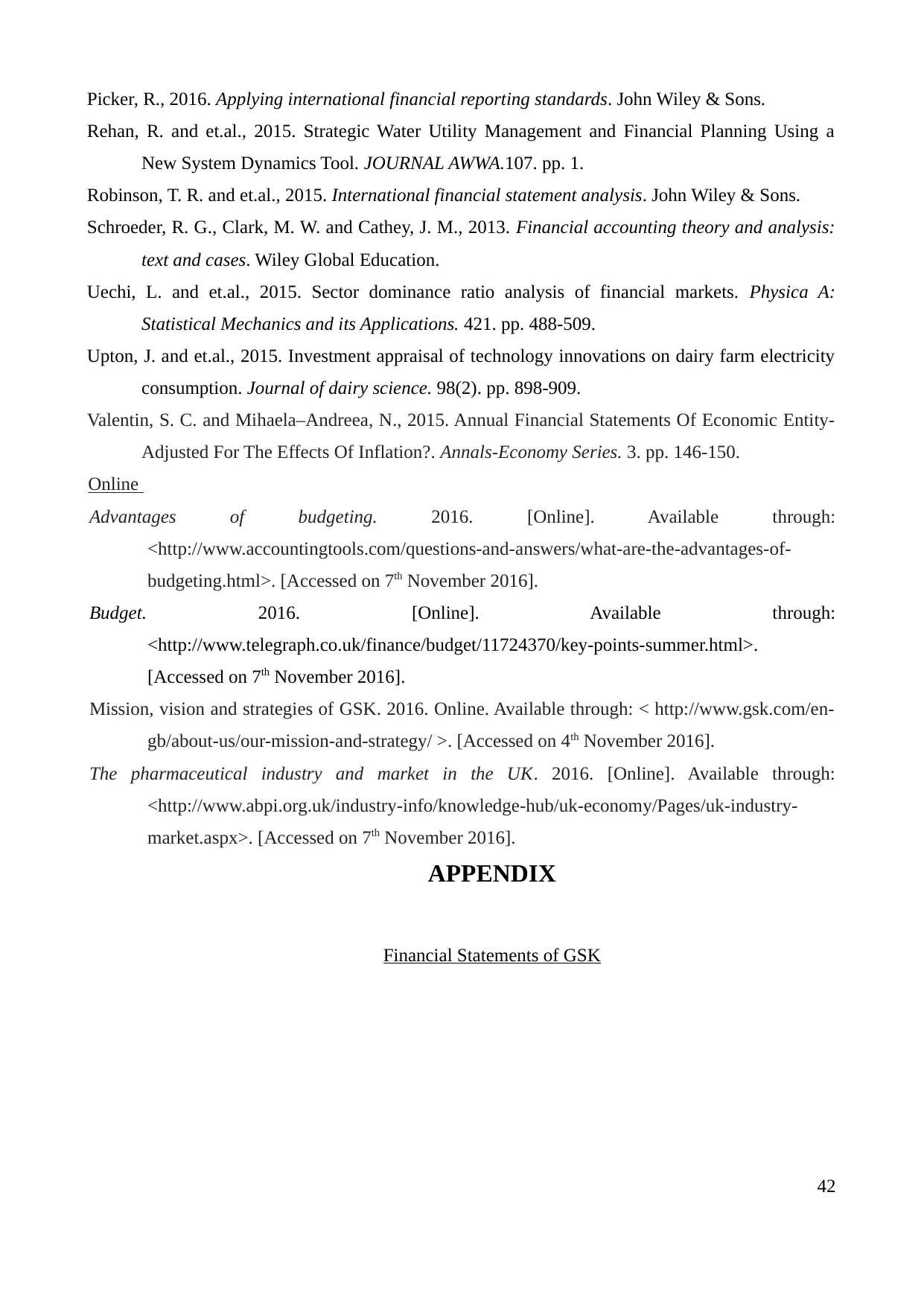
Picker, R., 2016. Applying international financial reporting standards. John Wiley & Sons.
Rehan, R. and et.al., 2015. Strategic Water Utility Management and Financial Planning Using a
New System Dynamics Tool. JOURNAL AWWA.107. pp. 1.
Robinson, T. R. and et.al., 2015. International financial statement analysis. John Wiley & Sons.
Schroeder, R. G., Clark, M. W. and Cathey, J. M., 2013. Financial accounting theory and analysis:
text and cases. Wiley Global Education.
Uechi, L. and et.al., 2015. Sector dominance ratio analysis of financial markets. Physica A:
Statistical Mechanics and its Applications. 421. pp. 488-509.
Upton, J. and et.al., 2015. Investment appraisal of technology innovations on dairy farm electricity
consumption. Journal of dairy science. 98(2). pp. 898-909.
Valentin, S. C. and Mihaela–Andreea, N., 2015. Annual Financial Statements Of Economic Entity-
Adjusted For The Effects Of Inflation?. Annals-Economy Series. 3. pp. 146-150.
Online
Advantages of budgeting. 2016. [Online]. Available through:
<http://www.accountingtools.com/questions-and-answers/what-are-the-advantages-of-
budgeting.html>. [Accessed on 7th November 2016].
Budget. 2016. [Online]. Available through:
<http://www.telegraph.co.uk/finance/budget/11724370/key-points-summer.html>.
[Accessed on 7th November 2016].
Mission, vision and strategies of GSK. 2016. Online. Available through: < http://www.gsk.com/en-
gb/about-us/our-mission-and-strategy/ >. [Accessed on 4th November 2016].
The pharmaceutical industry and market in the UK. 2016. [Online]. Available through:
<http://www.abpi.org.uk/industry-info/knowledge-hub/uk-economy/Pages/uk-industry-
market.aspx>. [Accessed on 7th November 2016].
APPENDIX
Financial Statements of GSK
42
Rehan, R. and et.al., 2015. Strategic Water Utility Management and Financial Planning Using a
New System Dynamics Tool. JOURNAL AWWA.107. pp. 1.
Robinson, T. R. and et.al., 2015. International financial statement analysis. John Wiley & Sons.
Schroeder, R. G., Clark, M. W. and Cathey, J. M., 2013. Financial accounting theory and analysis:
text and cases. Wiley Global Education.
Uechi, L. and et.al., 2015. Sector dominance ratio analysis of financial markets. Physica A:
Statistical Mechanics and its Applications. 421. pp. 488-509.
Upton, J. and et.al., 2015. Investment appraisal of technology innovations on dairy farm electricity
consumption. Journal of dairy science. 98(2). pp. 898-909.
Valentin, S. C. and Mihaela–Andreea, N., 2015. Annual Financial Statements Of Economic Entity-
Adjusted For The Effects Of Inflation?. Annals-Economy Series. 3. pp. 146-150.
Online
Advantages of budgeting. 2016. [Online]. Available through:
<http://www.accountingtools.com/questions-and-answers/what-are-the-advantages-of-
budgeting.html>. [Accessed on 7th November 2016].
Budget. 2016. [Online]. Available through:
<http://www.telegraph.co.uk/finance/budget/11724370/key-points-summer.html>.
[Accessed on 7th November 2016].
Mission, vision and strategies of GSK. 2016. Online. Available through: < http://www.gsk.com/en-
gb/about-us/our-mission-and-strategy/ >. [Accessed on 4th November 2016].
The pharmaceutical industry and market in the UK. 2016. [Online]. Available through:
<http://www.abpi.org.uk/industry-info/knowledge-hub/uk-economy/Pages/uk-industry-
market.aspx>. [Accessed on 7th November 2016].
APPENDIX
Financial Statements of GSK
42
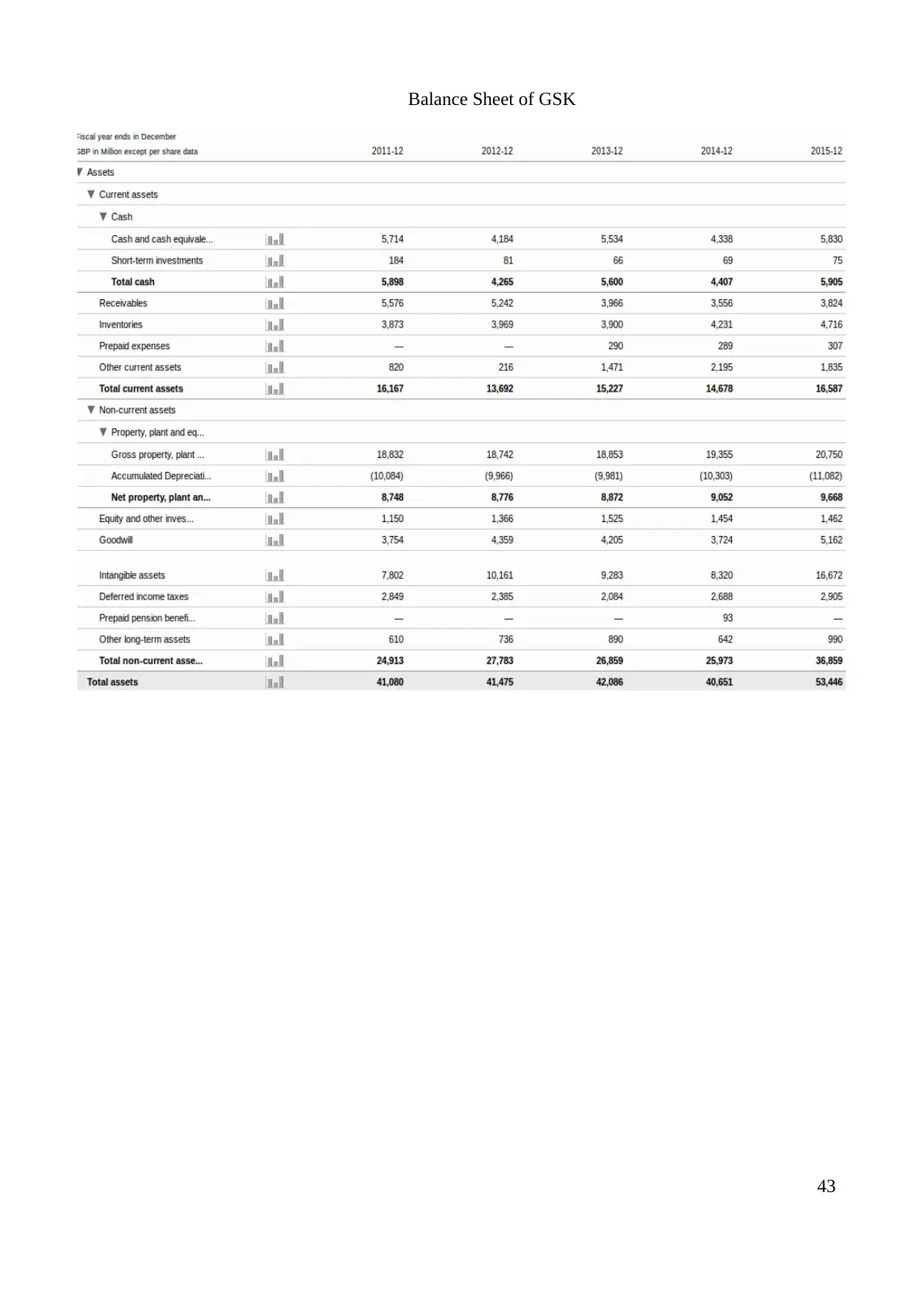
Balance Sheet of GSK
43
43
Paraphrase This Document
Need a fresh take? Get an instant paraphrase of this document with our AI Paraphraser
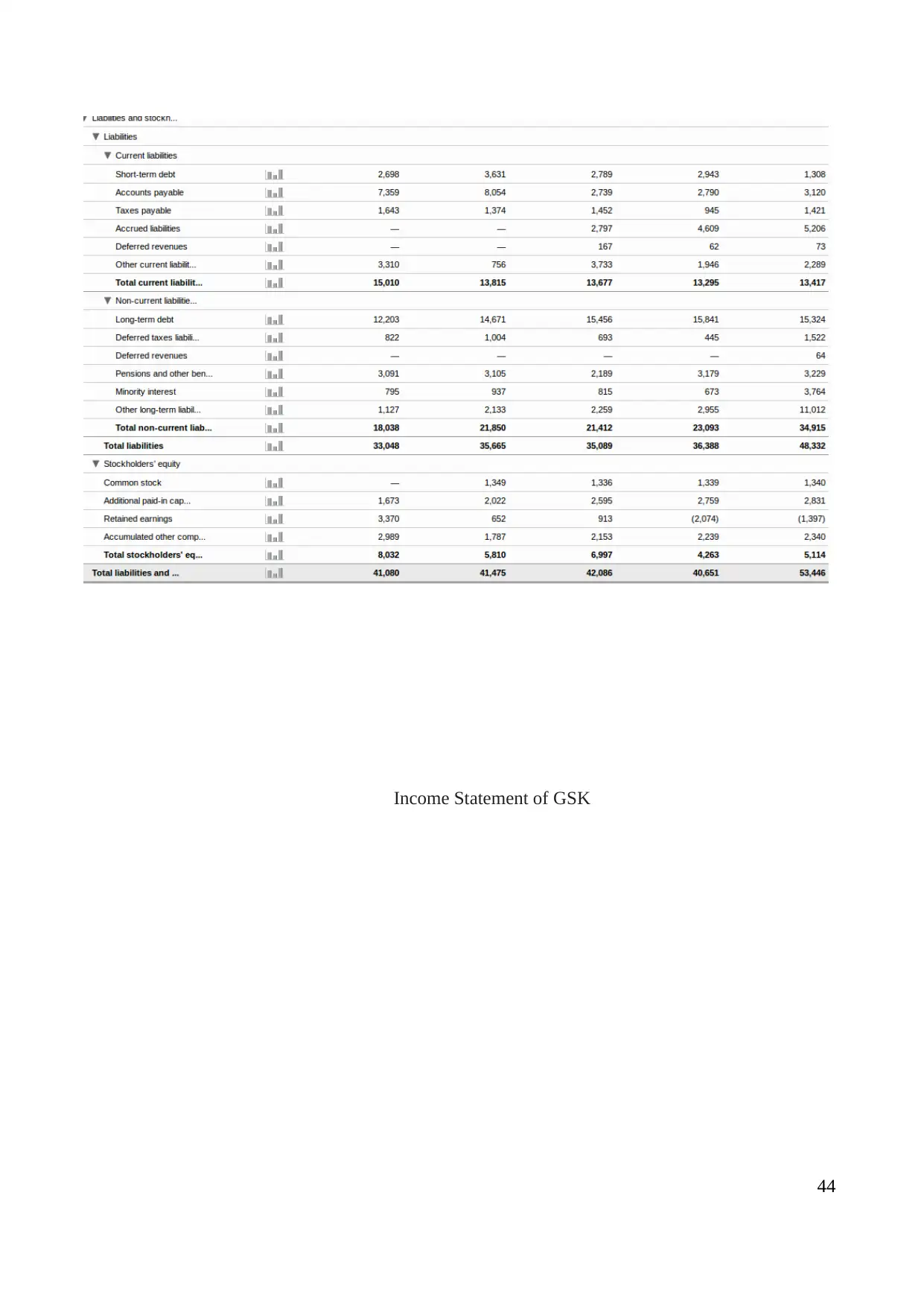
Income Statement of GSK
44
44
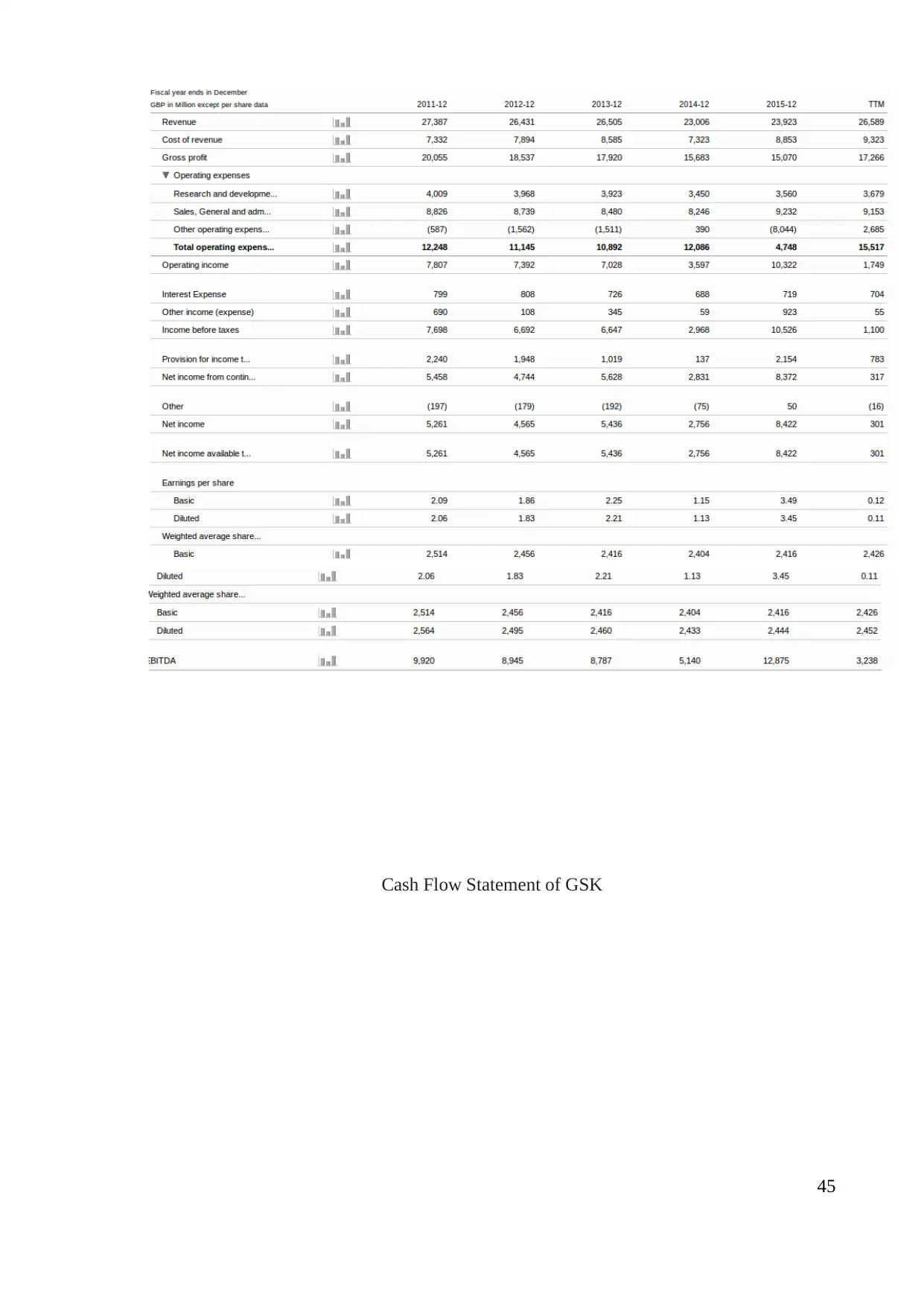
Cash Flow Statement of GSK
45
45

46
Secure Best Marks with AI Grader
Need help grading? Try our AI Grader for instant feedback on your assignments.
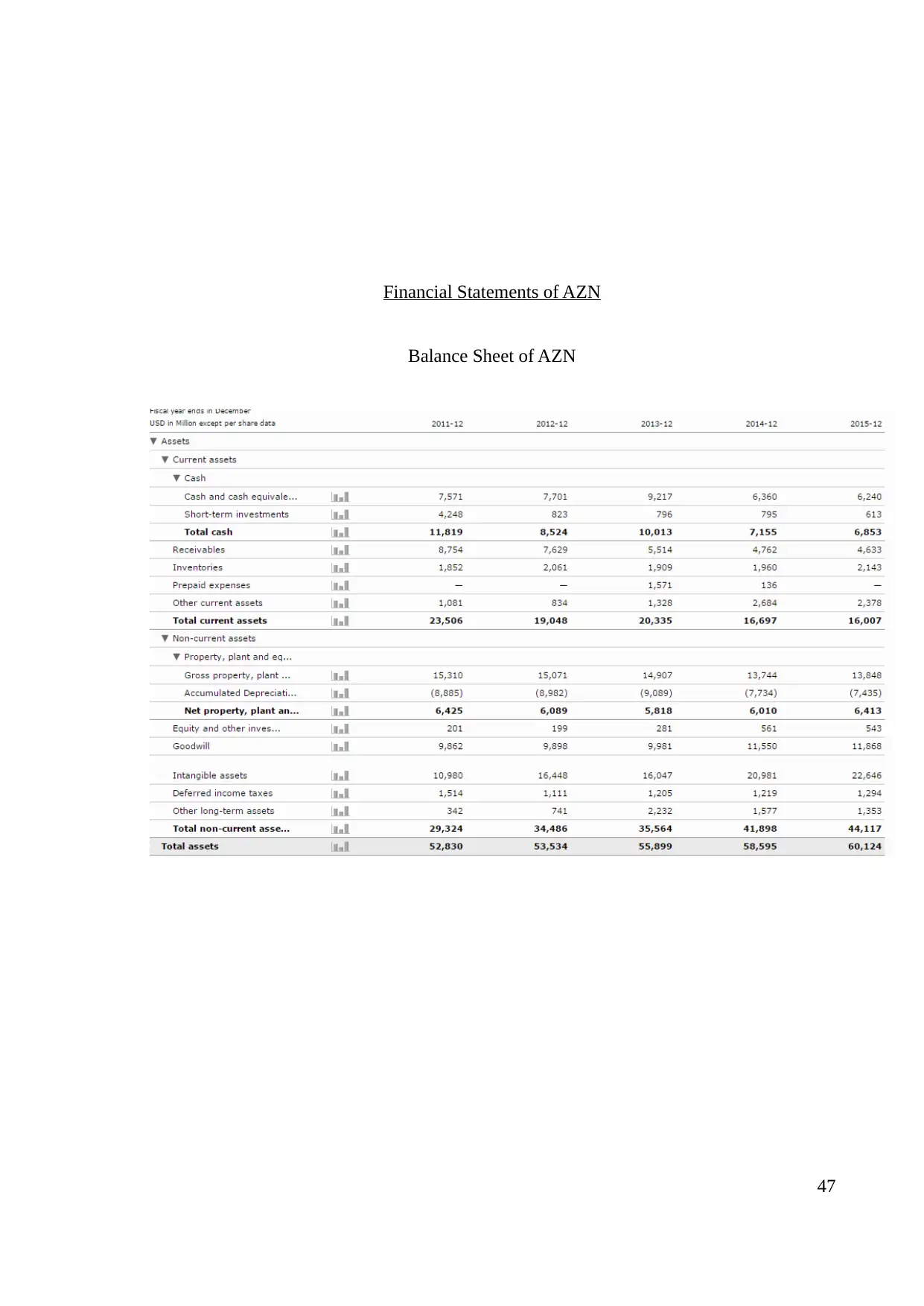
Financial Statements of AZN
Balance Sheet of AZN
47
Balance Sheet of AZN
47

Income Statement of AZN
48
48
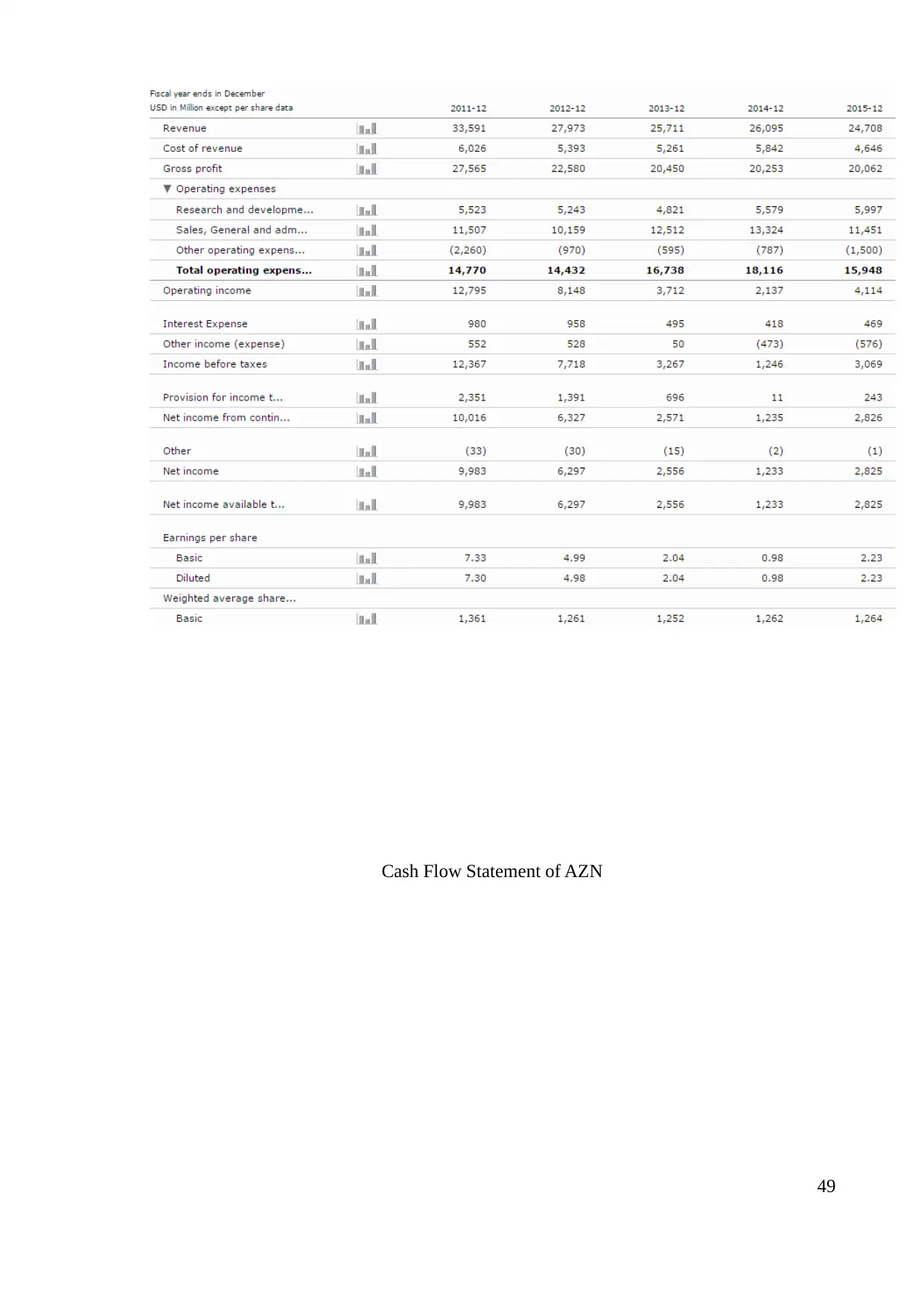
Cash Flow Statement of AZN
49
49
1 out of 49
Your All-in-One AI-Powered Toolkit for Academic Success.
+13062052269
info@desklib.com
Available 24*7 on WhatsApp / Email
![[object Object]](/_next/static/media/star-bottom.7253800d.svg)
Unlock your academic potential
© 2024 | Zucol Services PVT LTD | All rights reserved.

